Travel Safe
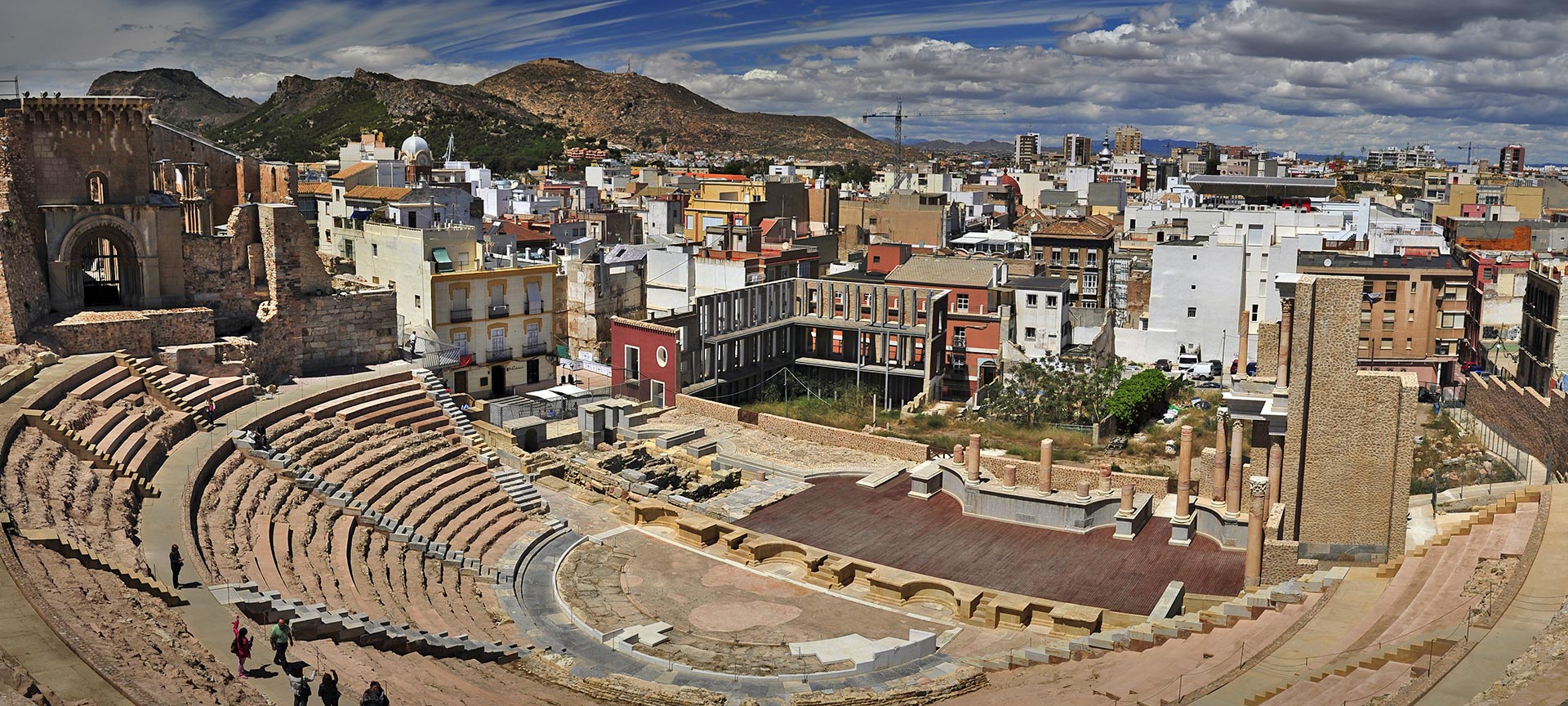
Region of Murcia
The port of Cartagena, in the Mediterranean's Costa Cálida, has been prized since Carthaginian times. Thanks to its strategic position on the Murcia coast, it has been inhabited by several cultures which have left their mark on its artistic heritage.
A tour of the place and its museums will draw us into the history of a city closely tied to the sea. This maritime enclave was already known to the Carthaginians and Romans, and its name today comes from the Latin, Cartago Nova . Cartagena was under Arab domination until Ferdinand III 'the Saint' reconquered it and incorporated it into the kingdom of Castile. Its port played a key role in the War of Succession and the Peninsular War.
Historic centre
The rich Carthaginian heritage spreads to the shores of its marina. The Muralla del Mar ('Sea Wall'), built by Charles III (18th century), delimits the old quarter. Overlooking the Mediterranean there is an element which is clearly connected with the sea: the prototype of the submarine by the inventor from Cartagena, Isaac Peral. In addition, the National Museum of Underwater Archaeology ARQUA (at Paseo Alfonso XII, 22) houses the National Centre for Underwater Archaeological Research. The findings on display reveal aspects of naval construction, trade and navigation since ancient times. The entrance to the city centre is dominated by the Town Hall, a gem of modernist architecture dating from the early 20th century. The Old Cathedral is located on the Camino del Parque Torres (behind the Muralla del Mar wall). This is the oldest place of worship in CartagenaCartagena (13th century), and stands on the remains of a Roman theatre discovered in 1987. This construction dates from the first century A.D., and together with the theatre in Mérida, is one of the most important in Spain. The items found on this site can be seen in the Museum of the Roman Theatre. Other examples of Roman splendour to be seen in the city are the archaeological site of El Molinete, the Morería Baja colonnade and the Byzantine Wall, which –despite its name– is also Roman. Particularly worth mentioning are the Augusteum and the Decumanus . The first contains the remains of the old forum, whose importance as a public building can be seen from the luxurious marble floors on display at the site. The second can be visited on the site adjoining the Roman Forum quarter, a key centre for visitors to the city, containing the different rooms in the city's Roman baths. The Casa Fortuna , built in the first century B.C. and belonging to a wealthy family, shows what daily life was like at the time of the Roman Empire. The Torres park is the site of the Concepción castle . Standing atop a hill, it served as a fortress to Carthaginians, Romans, Visigoths, Arabs and Castilians, and now houses the History and Mediaeval Cartagena Visitor Centre. Indeed the city has always had numerous defensive military buildings. A good example is the Navidad Fortress, built in the mid-19th century and today the Visitor Centre for the Defensive Architecture of Cartagena and the Mediterranean. Also worth visiting is the Refuge – Civil War museum , a series of galleries which were used as protection from aerial attack throughout the conflict. (More information at http://www.cartagenapuertodeculturas.com/ ) The best way to learn more about the Modernist architecture of Cartagena is to take a walk along the Calle Mayor, which leads off the Plaza del Ayuntamiento square, and around the surrounding area. Here visitors will find the houses of Cervantes and Llagostera, by the Cartagena architect Victor Beltrí, with their characteristic glassed-in balconies, worked in iron with bronze reliefs of allegorical figures. Other representative buildings of this artistic movement include the Casino, the Gran Hotel, the railway station, and the houses of Maestre and Dorda, all elegant monuments to the bourgeoisie which remain as evidence of the area's economic development, based on mining and industry, in the late 19th and early 20th centuries. More aristocratic are the palaces of Aguirre (whose adjoining modernist building is this side of the Regional Modern Art Museum MURAM) and Pedreño, one in the modernist and the other in the neoclassical style. The Punic Wall stands on Monte Aletes, one of the five hills surrounding Cartagena. This is the location of the Visitor Centre for this site, dating from the third century B.C. Adjoining the historic walled centre is the Military Arsenal, whose construction was concluded during the reign of Charles III. The walls here have the only surviving entrance gateway in the city. More interesting items from the history of Cartagena can be seen in the Naval Museum , located in the old Naval Offices in Paseo de Alfonso XII, which contains an exhibition of old maritime navigation instruments, maps and navigation charts, as well as models of ships of all kinds. The fishing quarter of Santa Lucía is also well worth visiting. The city of Cartagena also has a variety of key cultural events each year, such as the world music festival known as the 'La Mar de Músicas' (Sea of Music). Other highlights include the historical festivities of the Carthaginians and the Romans in the second fortnight of September which commemorate the Punic foundation of the city, and the Roman reconquest.
The wide variety of landscapes of the Region of Murcia produces a rich selection of different ingredients from the farmlands, the sea and the interior. In Cartagena , the star dishes are products preserved in brine, fish, rice dishes and paellas. The abundant salt flats of the Mediterranean are used for salt to prepare food in brine (particularly tuna, mackerel and bullet tuna) and fish such as gilthead sea bream baked in salt. The calderos, (casseroles) with grey mullet, monkfish, grouper... consist of rice cooked in fish stock and accompanied by a garlic mayonnaise known as ali-oli. Fig bread is a regional speciality, and Cartagena's typical asiático, made from condensed milk, cognac and cinnamon, is the ideal accompaniment to coffee. To enjoy all the different types of cuisine in Murcia, the best idea is to head for the northwest of the region, in order to visit the Sierra de Moratalla, Caravaca de la Cruz and Calasparra, whose rice is the only one in Spain with its own Designation of Origin . This is definitely the star product in a long list of typical dishes, such as rice with snails, or in a stew with celery and turkey. La Vega del Segura leads to towns and villages such as Cieza, Archena (with a spa centre) and Molina del Segura (with a first-rate golf course), where visitors will find such delicacies as green asparagus, hearty chard soup, and rabbit with chestnuts. The area known as the Altiplano in Murcia (in the north) is home to such monumental towns as Jumilla and Yecla . These towns also have wines with their own Designation of Origin. The typical gazpachos (seasoned unleavened bread crumbs) and pulses are served as accompaniments to game dishes. The area's fertile farmlands produce a wide range of vegetables, which are perfect served with the delicious local sausages and cured meats. The Parador hotel in Puerto Lumbreras, and the towns and villages along the Costa Cálida (Águilas, Mazarrón, San Pedro del Pinatar...) are home to interesting monuments from the area's rich heritage, as well as exceptional facilities for nautical sports, beaches, and a delicious cuisine.
What to visit
Select from the list or hover over the map to find out about points of interest.

Torre Ciega

National Museum of Underwater Archaeology.
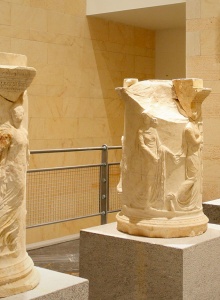
Cartagena Roman Theatre Museum
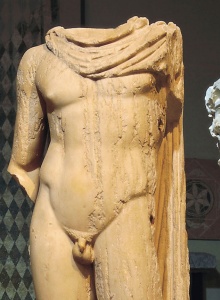
"Enrique Escudero de Castro" Municipal Archaeology Museum
Travel plans for inspiring you
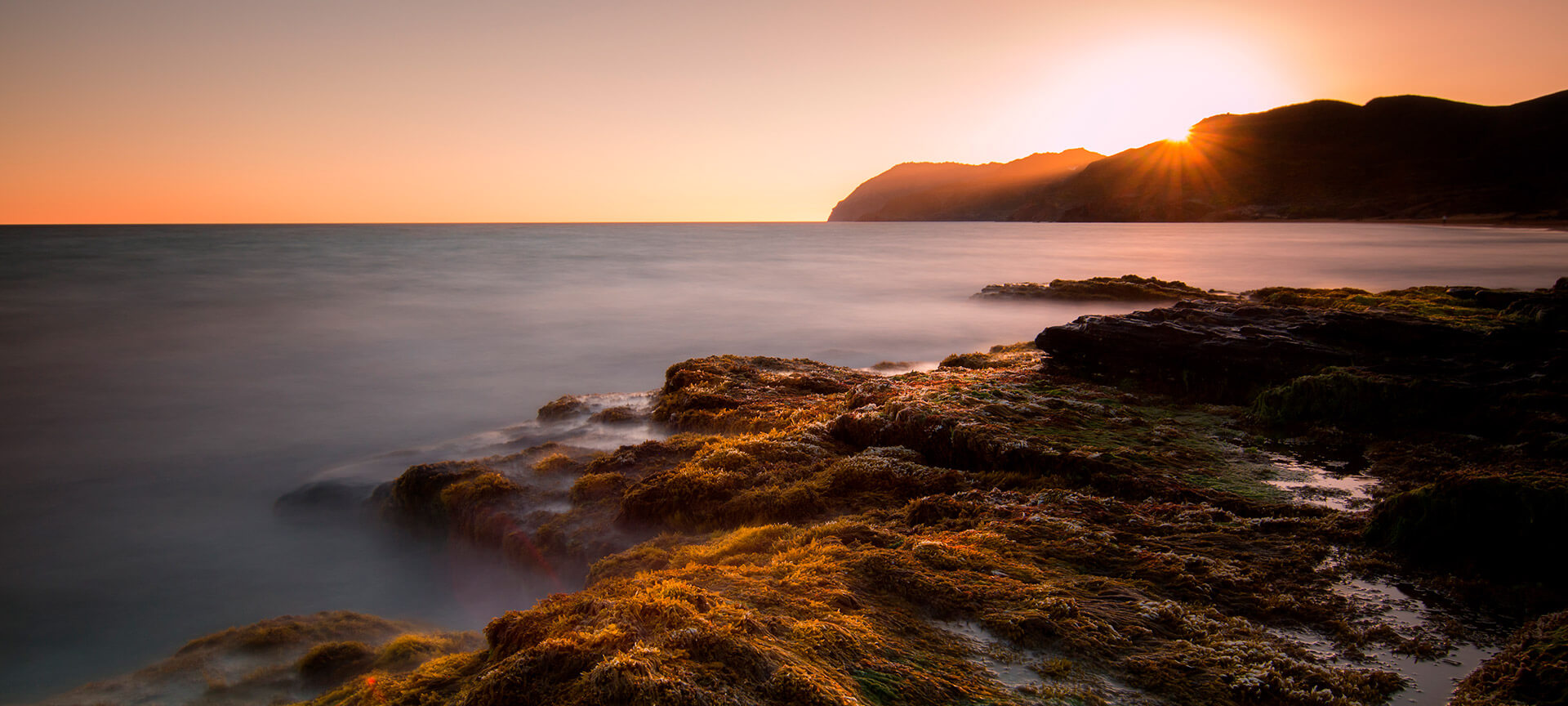
Holidays in Murcia: great things to do at a surprising destination
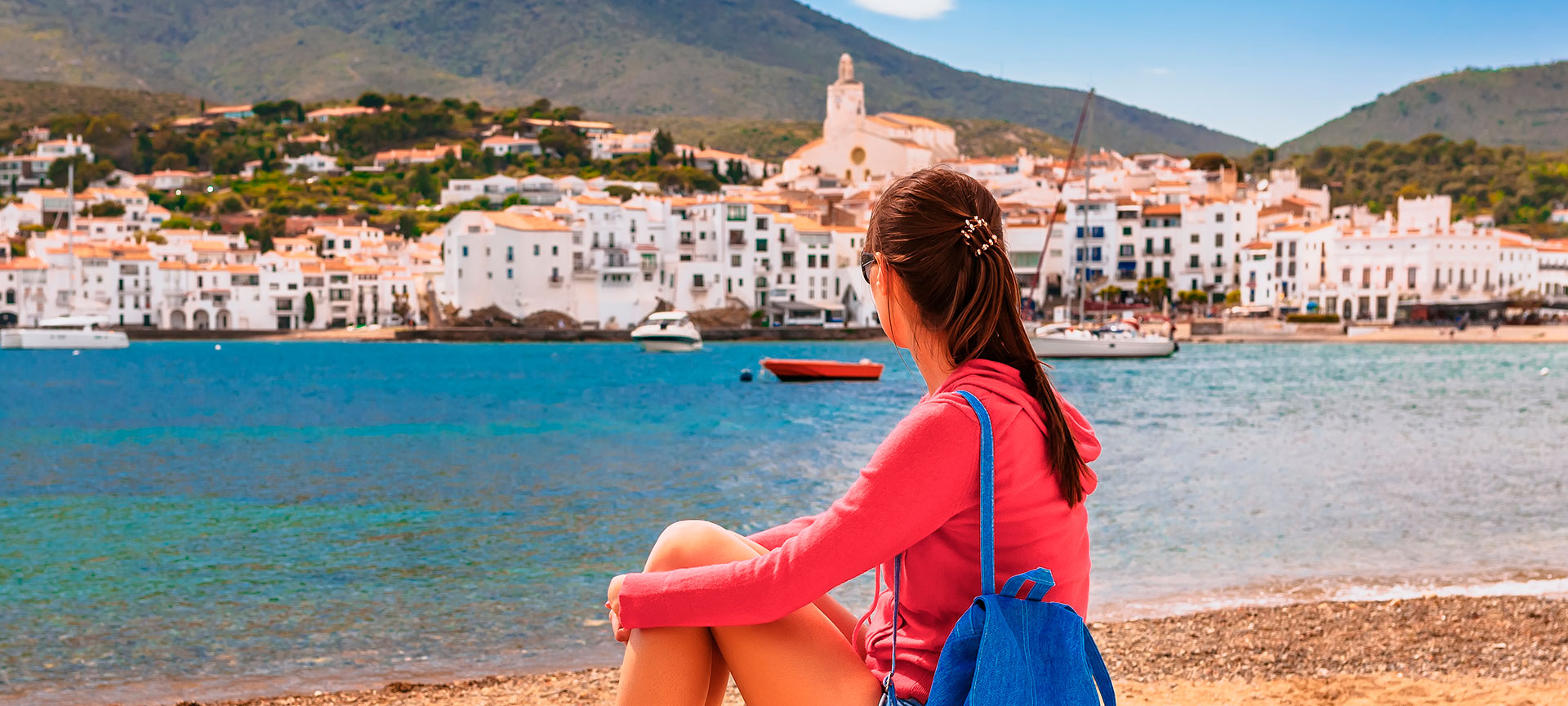
A road trip along Spain’s east coast
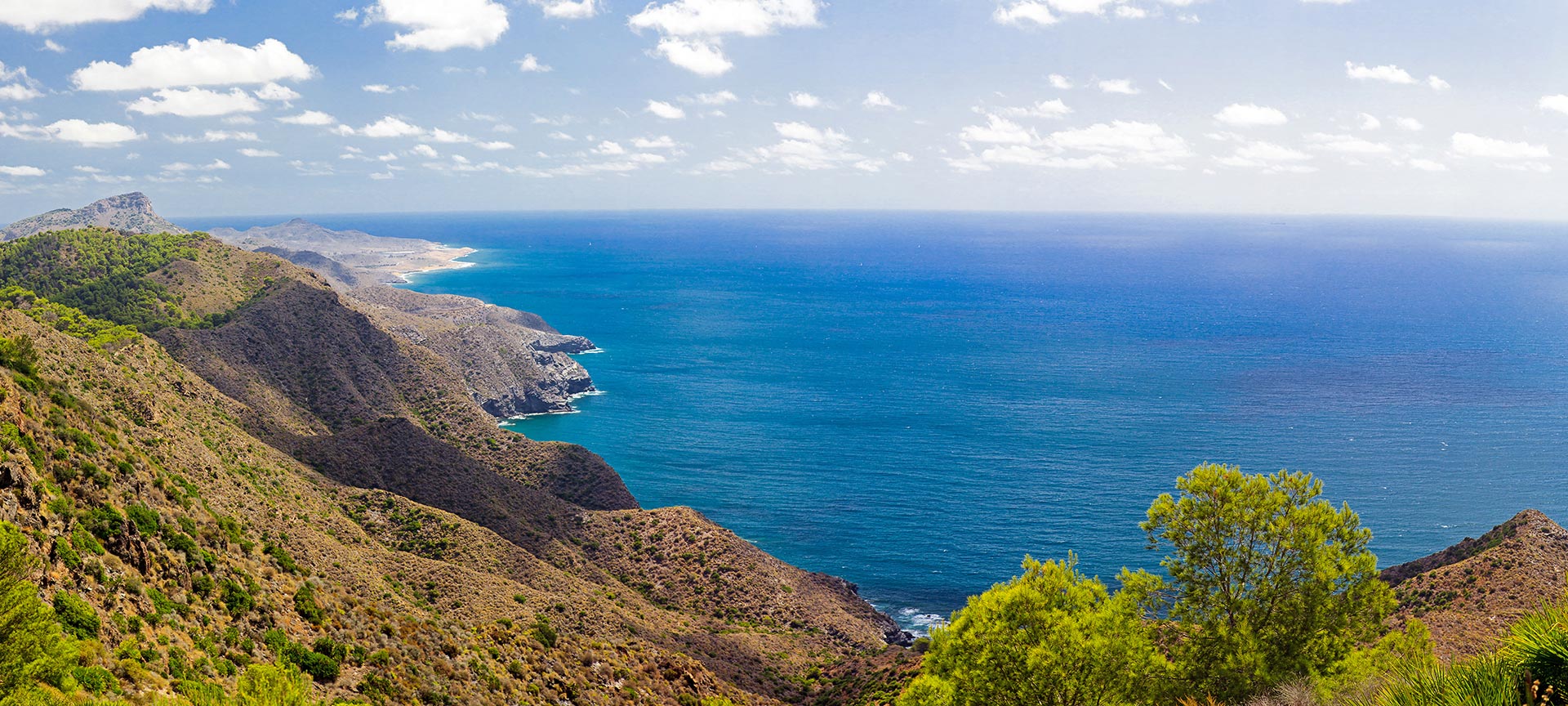
Seaside towns in the Region of Murcia
Shows, festivals, sports...
View some of the most relevant events you will be able to enjoy at the destination.
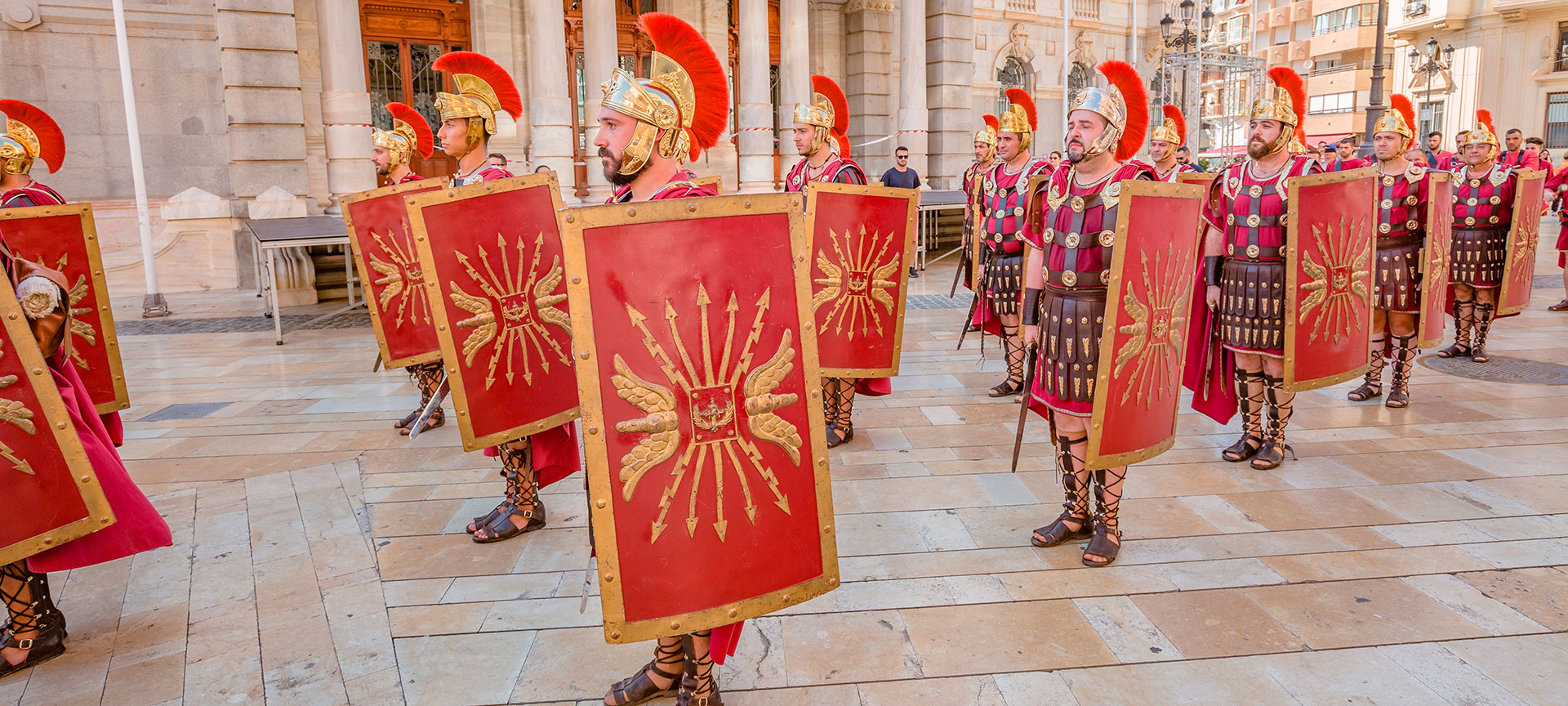

Carthaginians and Romans Fiesta
15 September 2024 - 24 September 2024

La Mar de Músicas Festival
19 July 2024 - 27 July 2024
Cartagena International Film Festival
23 November 2024 - 30 November 2024

Choose between thousands of activities to live your best life on holiday.


Home » Travel Guides » Spain » 15 Best Things to Do in Cartagena (Spain)
15 Best Things to Do in Cartagena (Spain)
With one of the world’s great natural harbours and rich mineral mines, Cartagena has been a prized location for millennia. The Carthaginians played a big role in its evolution as an ancient trading hub in the 3rd century BC before it was conquered by the Romans.
You can purchase a multi-ticket to get access to Cartagena’s numerous Roman sites to understand the complicated ancient history of the city. In the 19th century there was a mining boom, bringing a lot of wealth to Cartagena and transforming the historic centre with art nouveau architecture.
Let’s explore the best things to do in Cartagena :
1. Roman Theatre Museum
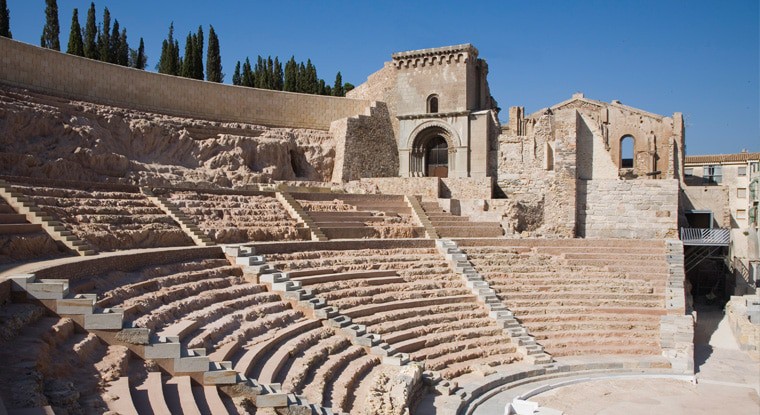
Of all the marvellous Roman landmarks in Cartagena, the 2,000 year-old theatre should be your first port of call.
It was discovered as recently as 1988 beneath the ruins of the Old Cathedral, which had been destroyed during shelling in the Spanish Civil War.
About two thirds of the theatre’s building material was still on site, which made possible the very detailed restoration you can see now.
In the museum you’ll study the fantastic artefacts discovered during the excavations, among them an altar to Jupiter, a statue of Apollo, inscribed lintels, plaques and also Islamic ceramics from the middle ages.
2. ARQUA, Marine Archaeology Museum

It’s fitting that this institution should be set in one of the western Mediterranean’s great ancient harbours, where new finds are made almost every year.
ARQUA is a national centre for marine archaeology: A place to can see remarkable historical artefacts from underwater sites, but also a research facility for experts and scholars in the field.
Find out how archaeologists analyse their discoveries at the laboratory area, which has interactive displays for kids.
Among the many artefacts to check out are Carthaginian ivory tusks and the treasure of Nuestra Señora de las Mercedes, a frigate that was sunk in the early 19th century with 14.5 tons of gold and silver coins.
3. Modernist Architecture

In the late-1800s the mining industry made a handful of people very rich, and the most obvious expression of this wealth can be seen in the historic centre of Cartagena and nearby La Unión.
Cartagena’s centre already needed rebuilding in the late-19th century, after a federalist insurrection in 1874 wiped out half the city.
So towards the end of the century some gorgeous art nouveau buildings went up.
You could fit the best ones into a walking tour and they include the Palacio Pedreño, the Casino de Cartagena, the Casa Cervantes, the Palacio de Aguirre and the Gran Hotel.
4. Palacio Consistoria

You can enter one of Cartagena’s most impressive modernist wonders, the 100 year-old town hall on Plaza del Ayuntamiento.
This triangular palace was also a response to the mining boom in the late-19th century, as Cartagena had outgrown its former town hall.
After suffering from structural problems in the 90s the building was restored to its Belle Époque glory days ten years ago.
Take a few minutes to study the facade, composed entirely of white marble and topped with domes that are coated with local zinc.
Get closer and you’ll even see a few bullet holes from the Civil War.
There are English-speaking guided tours, showing you around the marble balustraded stairways and an exhibit of period tapestries.
5. Municipal Archaeology Museum

Furthest north of Cartagena’s ancient sites is a late-Roman necropolis, which was set on the shore of an ancient lagoon that has since disappeared.
It’s an enthralling site, because it contains some of the latest evidence of Roman settlement, dating from 300 to 700AD – a time of transition to Christianity.
The museum has plenty of items excavated from this site, but has also gathered a wealth of artefacts from around Cartagena.
You’ll get a full chronology of the area, from Neanderthal remains, through Phoenician ceramics to the tools discovered in the Roman mines in the mountains on the edge of the city.
6. Calle Mayor

Linking the Plaza de San Sebastián in the north with Cartagena’s town hall is a ravine-like pedestrian street paved with distinctive blue marble tiles.
It’s a typically Spanish “Paseo”, where families and couples will take a stroll together or meet friends.
The street is kept spotlessly clean and boasts many of Cartagena’s best modernist buildings.
By day you can drop by for a cup of coffee or some high-street shopping, and in the evening you’ll be tempted by the various restaurants and tapas bars in this handsome location.
7. Batería de Castillitos

An eerie time can be had at the tip of Cape Tiñoso, 30 minutes from Cartagena and reached via dirt roads.
At 250 metres you’ll be able to gaze back at the extraordinary mountainous landscape of this natural park.
But also here is an installation that mixes frivolous architecture with meaty and sinister artillery guns.
It was built in the mid-1930s during the rule of Primo de Rivera as part of a series of batteries defending Cartagena’s coast.
Whimsical medieval-style turrets blend with the mountainside and look strange next to the menacing, black Vickers-Armstrong guns.
Use the torch on your phone to investigate the tunnels in the fortified area.
8. Military Museum

Cartagena has had a large military presence for thousands of years, and in modern times a number of Spanish army units have been based in the city.
You can see a great deal of this heritage in one place, and it’s an attraction that will blow your mind if you’re into military hardware.
The museum building was constructed in the late-18th century and in the courtyard you’ll spot an undetonated shell wedged in a wall from the insurrection in 1874. On show are tanks, missiles, field telescopes, light arms, a number of heavy-duty guns and all kinds of other military equipment.
The museum also has the largest collection of hand-made military models in the world, with the Guinness certificate to prove it!
9. Spanish Civil War Museum

The war from 1936-39 was one of the darkest moments in Spain’s history, and Cartagena didn’t escape the destruction.
The city was a Republican military stronghold, and as you may have noticed it was well-defended from sea.
This made it a target of bombing raids by the Nationalist forces (with help from the Nazis) so shelters like this one were built around the city.
Down here you’ll appreciate what people had to do to survive, and will also see original signs, propaganda posters and other artefacts.
There are moving first-hand accounts about the conflict, and you’ll learn of the ingenious ways the city attempted to trick the Nationalist forces into bombing the wrong locations.
10. Casa de la Fortuna

You’ve seen the necropolis, the theatre and the history of the port; now’s your chance to find out how Roman Cartagena’s wealthy citizens lived.
This domus’ name comes from a Latin inscription on its back entrance: “Fortuna Propitia”, meaning “good luck” and it would have greeted all visitors.
It’s easy to get a feel for the site as there’s so much of the walls and decoration remaining, as well as a stretch of the roman road outside.
You can make out the hallway (atrium), bedrooms (cubiculum), dining hall (triclinium) and the owner’s office (tablinum). There are surprising features everywhere, including wall paintings and mosaic floors.
11. Naval Museum

Right on the port is this museum that covers Cartagena’s maritime military past.
It’s in a dignified 18th century waterside building that until recently was a college for marine personnel joining Spain’s navy.
The museum showcases memorabilia, weapons, navigational tools and offers detailed accounts of the turmoil on the 1870s.
An absolute must is the Peral Submarine, the world’s first battery-powered underwater vessel, that was launched in 1888. This prototype was tested for two years but never developed, despite being a great technological step forward and possibly the world’s first “U-boat”.
12. Castillo de la Concepción

Cartagena had long been in decline by the time the Moors arrived in Spain.
And for centuries it was believed that they hadn’t made their mark on the city at all, but excavation of the walls of this fortress in Parque Torres have shown that it was an Alcazaba, an Islamic fortified palace in the middle ages.
Long before that it had been a Roman temple to Asklepio, and the cisterns from that time are still intact.
Most of what remains now is from the 13th century, following the Christian “re-conquest”, with small pointers to this period visible in the carvings of eagles and rosettes.
Catch the lift to the top for supreme panoramas of the harbour and coastal mountains.
13. Playa de Calblanque

For a day of sun and sand you won’t regret going the extra mile to this unspoiled beach half an hour from Cartagena.
Playa de Calblanque is on the road to Cabo de Palos, the headland at the southern end of La Manga.
Take the exit for Calblanque and the road runs south towards the coast through farmland traced by the low arid mountains of the Calblanque Regional Park.
Beyond these peaks is a secluded 300-metre beach with sands the shade of burnt gold.
On quieter days you’ll have the beach almost to yourself, but don’t forget to bring refreshments as there’s hardly a sign of civilisation here.
14. Licor 43 Tour

A grown-up rainy day option is a tour of one of Spain’s most-exported liqueurs, Licor 43, distilled right in Cartagena.
Book ahead and you’ll take a two-hour trip around the facility, picking up loads of factoids from your multi-lingual guide.
For the uninitiated, Licor 43 is a 31% abv spirit, made with 43 different citrus fruits and spices, and goes best with ice and milk.
On the visit you’ll see the production process up close, from mixing to fermentation, ageing and bottling.
Try to avoid being the designated driver, because the tour concludes with cocktails!
15. Local Mines

As with many things in Cartagena mining was introduced to the area by the Romans.
The Sierra Minera is rich with an assortment of metals including silver, copper, zinc, lead, tin, manganese and iron.
Anyone who gets a kick out of industrial heritage will a closer look at the two mining attractions in the area: the La Unión Mining Park and the Las Matildes Mine.
At La Unión the Agrupa Vicenta mine will blow you away; it plunges 80 metres beneath the surface and has huge, navelike spaces and an underwater lake with reddish waters.
At both attractions you’ll see gear and infrastructure like miner’s quarters, compressor rooms, 19th-century derricks and carts for carrying minerals.
15 Best Things to Do in Cartagena (Spain):
- Roman Theatre Museum
- ARQUA, Marine Archaeology Museum
- Modernist Architecture
- Palacio Consistoria
- Municipal Archaeology Museum
- Calle Mayor
- Batería de Castillitos
- Military Museum
- Spanish Civil War Museum
- Casa de la Fortuna
- Naval Museum
- Castillo de la Concepción
- Playa de Calblanque
- Licor 43 Tour
- Local Mines

34 Things to do in Cartagena, Spain – 3 Day Itinerary
By Author Paulina
Posted on Published: June 3, 2020 - Last updated: July 7, 2023
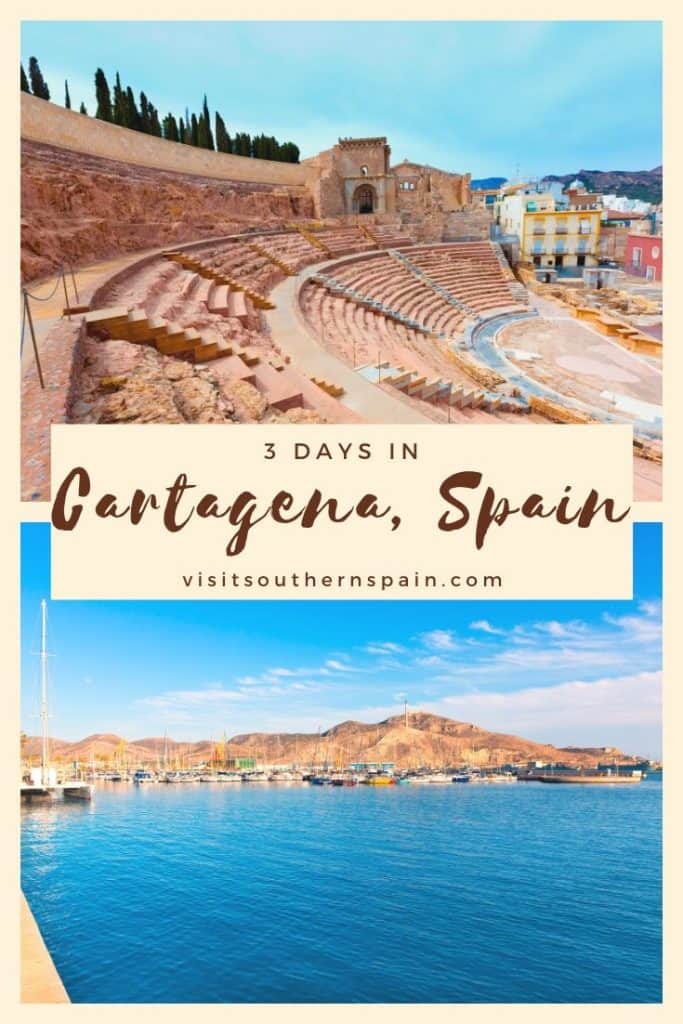
A travel guide to the best attractions in Cartagena, Southern Spain: the perfect Cartagena Itinerary
Looking for things to do in Cartagena ? Cartagena is one of the most amazing places to visit on the Mediterranean coastline, especially for those interested in ancient history. The city has ample Roman ruins and a rich maritime background.
Nowadays the city in Murcia province is one of the most important harbours in Spain for cruise ships, thus the starting point for many to explore Southern Spain.

Following this 3-day itinerary for Cartagena, Spain will allow you to fully explore this historical gem, and if in a hurry, it’s easy to adjust it by simply skipping a few locations – or just take your time, and enjoy the long holidays in Cartagena!
You, dear reader, support this blog. If you purchase through a link, we earn a small commission. As an Amazon Affiliate, we earn from qualifying purchases.
Top Things To Do In Cartagena, Murcia Region – Our Cartagena Itinerary For 3 days
- Visiting the Old Town and nearby monuments
- Exploring ancient Roman ruins
- Trying Andalusian cuisine and tapas
- Relaxing on the best beach in Cartagena
- Discovering wildlife from Southern Spain
Useful Travel Information About Cartagena
✈ Book cheap flights to Cartagena with Skyscanner ⚘ Avoid tourist traps and get the customizable “ Andalucia Like a Local ” itinerary. – Get it here ✔ Book tours in Cartagena with GetYourGuide ➳ Find the best hotels in Cartagena with Trivago ❖ Rent a car at the best rates with Discover Cars ✎ Never leave without travel insurance ! I get mine at HeyMondo . It is easy to set up, cheap and reliable. $ Withdraw money without hidden fees and avoid exchange charges with TransferWise (Free Mastercard debit card to spend money abroad)
Where is Cartagena?
Cartagena is located right by the Mediterranean coast in the Region of Murcia . You’ll find it only 50 km south-east from Murcia and next to the wildlife resort Sierra de la Muela, Cabo Tiñoso y Roldán.
How to get to Cartagena
How to get from Murcia to Cartagena:
Bus: Take a direct bus from Murcia Central to Cartagena bus station (45min). Train: Take a direct train from Murcia del Carmen train station (50min).
Get tickets in advance here
How to get from Almeria to Cartagena:
Bus: Take a direct bus from Almeria main bus station (4h). Train: There are no train connections between Almeria and Cartagena..
How to get from Alicante to Cartagena:
Bus: Take a direct bus from Alicante main bus station (1:50h). Train: Take a direct train from Alicante-Termino train station (2:12h).
Day 1: 1 day in Cartagena
Visit cartagena old town.
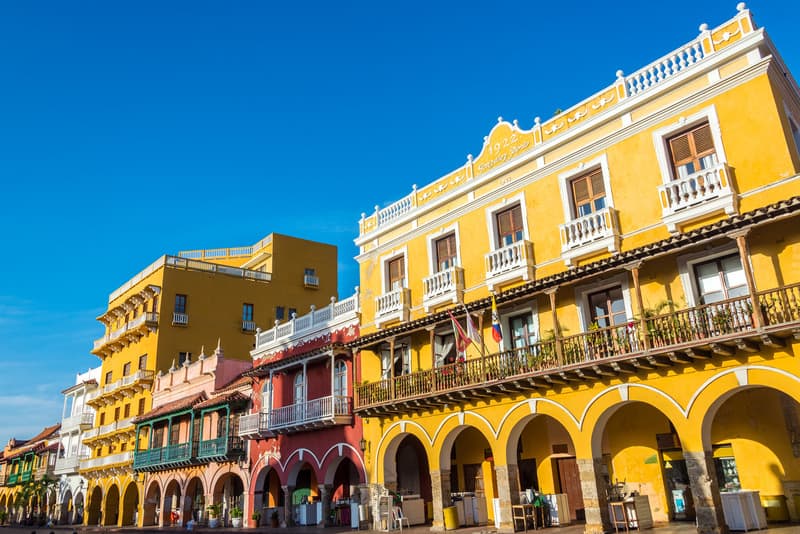
One of the best things to do around Cartagena city is to visit the old town of Cartagena. It’s one of the richest and full of character places in the city. It was constructed in 223BC, and was Hannibal ‘s capital city on the Iberian Peninsula, making it an area with plenty of historical monuments, squares, and buildings for you to discover!
It’s an amazing example of the beauty of Andalusian architecture, built within grotesque, little streets, lively tapas bars, and the overall Spanish atmosphere and chatter!
Make sure to stop at Plaza Ayuntamiento with the gorgeous town hall for a photo! The square is absolutely breathtaking!
In order to explore all hidden gems, take a guided tour . – Check the best prices here
Discover the Roman theatre and Roman heritage of Cartagena
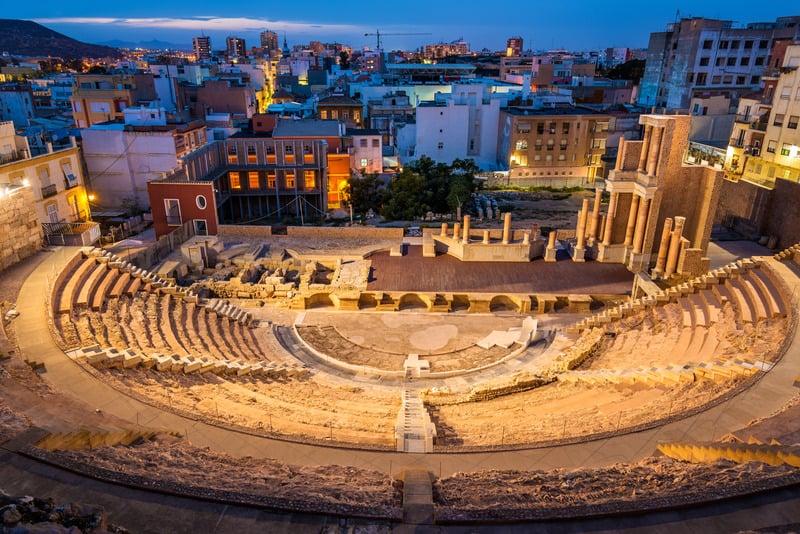
When walking around the Old Town, you simply cannot skip the Roman theater in Cartagena Spain! Built between the 5th and 1st centuries BC, the theater has been one of the best things to see in Cartagena and is a truly magnificent site to explore!
A great place for all interested in re-discovering the ancient history of Spain and a fantastic opportunity to learn more about the archeological remains and development of Spanish architecture.
Check rates for guided Roman tours here
Opening times:
Oct – April: Tues – Sat: 10:00-18:00/ Sunday: 10:00 – 14:00 May – Sept: Tues – Sat: 10:00 – 20:00/ Sunday 10:00 – 14:00
Head over to ARQUA, Marine Archaeology Museum
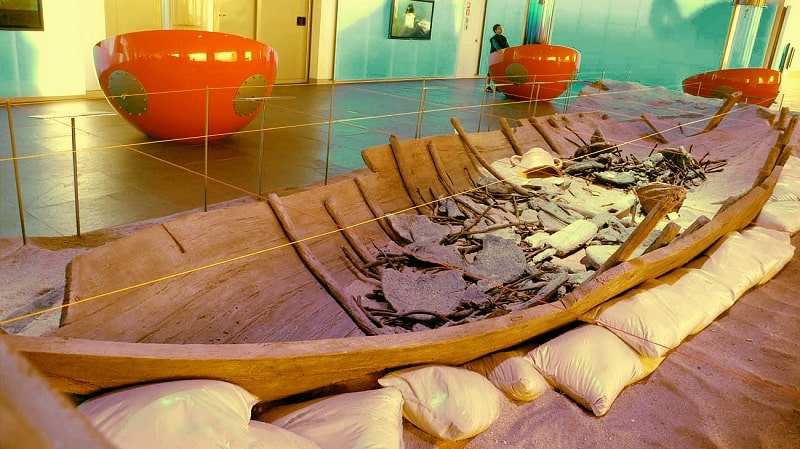
If you’re looking for museums in Cartagena, Spain, this museum is one of your best options.
Spending at least an hour in the Marine Archaeology Museum is simply a must! Known to be one of the best places to visit in Cartagena, the ARQUA facility is true underwater life and marine history wonderland set in a modern and well-designed building for you to relax and enjoy the tour!
Great exhibitions about the city’s development and marine life history are here for all travelers to marvel at and discover more about Cartagena, España! You can enter for free if you decide to visit on a Saturday after 2 pm!
Oct – April: Tues – Sat: 10:00-18:00 May – Sept: Tues – Sat: 10:00 – 20:00
Learn about history at the Punic Wall
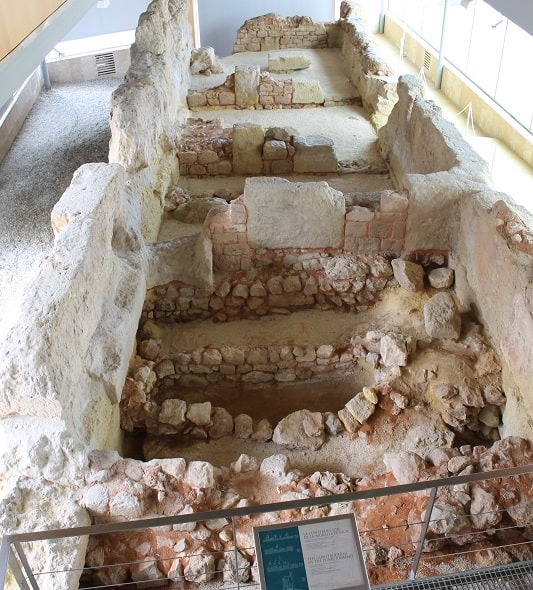
The Punic Wars between the Carthaginians and the Romans are known to be the most important moments in Cartagena’s history, and it’s a great idea to learn a bit about that period!
The legendary Qart Hadast founded by Hasdrubal in 229 BC and one of the few remaining Carthaginian relics – the wall – is a must-see when visiting Cartagena, Murcia. – Check guided Roman tours here
Lunch in La Catedral

After a busy morning, it’s time to sit down and relax, surrounded by the aromas and flavors of Southern Spain!
For an unforgettable experience head down to La Catedral ( Plaza Condesa de Peralta ) – one of the best restaurants in Cartagena, where you’ll be able to dive into the world of Spanish cuisine.
Try their delicious Tuna Tartare , Cod, and Baked Sea Bream if you’re seeking for the best quality seafood dishes in town!
Explore the Modernist architecture of Cartagena
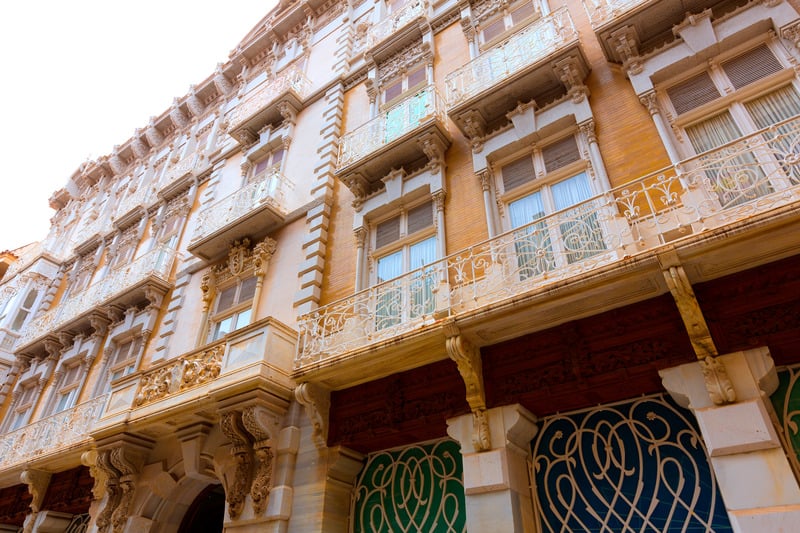
Architectural discovery does not only mean visiting museums and ancient ruins of Cartagena. Head down to Calle Mayor to discover the Art Nouveau buildings alongside the best shopping area in Cartagena.
You’ll find here plenty of local bars and restaurants as well as monumental sites and squares to marvel at!
There are plenty of hidden gems in Cartagena, that’s why we recommend booking a guided tour . – Check prices here
Visit the military museum of Cartagena
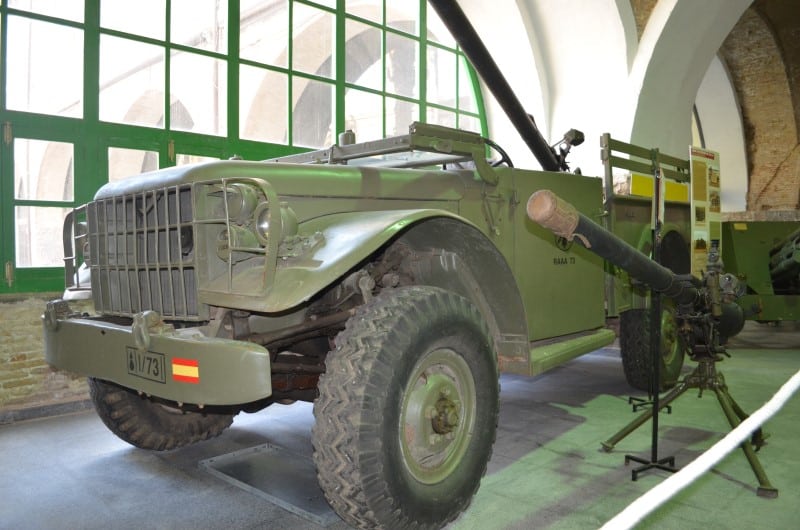
The Museo Militar is a true gem in terms of capturing Cartagena’s military history, and holds the world’s biggest collection of military models!
You’ll find here endless weapon collections and a great representation of the defense tactics of the city during its many years of war and conflicts!
The museum is free of charge and is a must-see when discovering the Murcia coast.
Opening times: Mon – Fri: 10:00 – 13:30
Take a picture at Palacio Consistorial
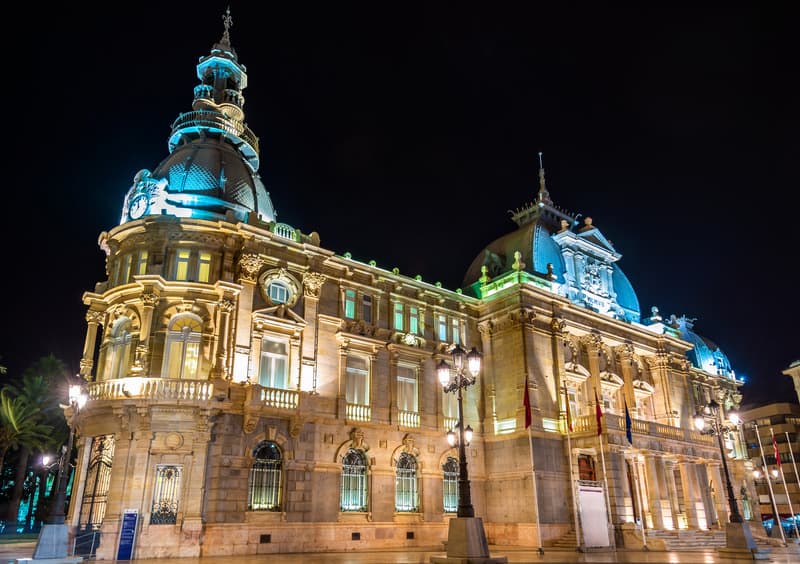
The City Hall is, without doubt, one of the most outstanding buildings in Cartagena. It was built between 1900-1907 by Tomás Rico and Francisco de Paula Oliver and will definitely catch your attention with its eclectic French style.
A truly stunning place, not only to enjoy while wandering within its ornamented halls and corridors but also a beauty to marvel at from the outside square, while enjoying a sunny afternoon!
Tues – Fri: 10:30 – 13:30/ 17:00 – 19:00 Sat: 10:30 – 13:30/ 17:00 – 20:00 Sun: 10:00 – 13:30
Marvel at Casa de la Fortuna
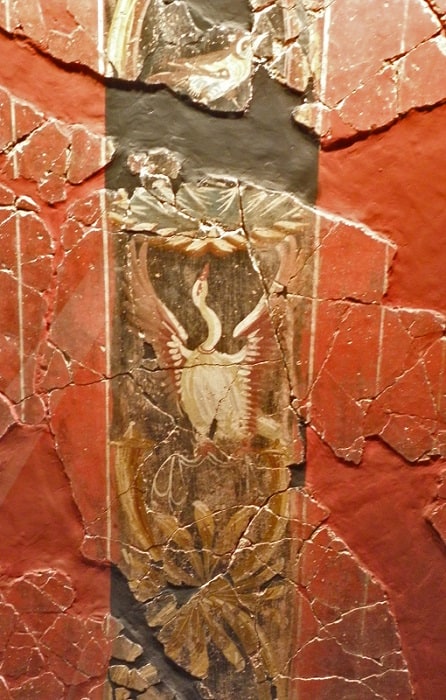
Visiting Casa de la Fortuna will take you back in time to the domestic ways of the Roman Cartagena. A great place to learn and discover the traditional household settings from the 1st century, and a very interesting way of presenting a museum within Roman remains.
You’ll find here plenty of personal objects, ancient dishes, murals, mosaics, and more, which will allow you to relive the history of the first settlements in Southern Spain .
Opening times: Tue – Sun: 10:30 – 15:30
Go shopping in Calle Mayor, Cartagena
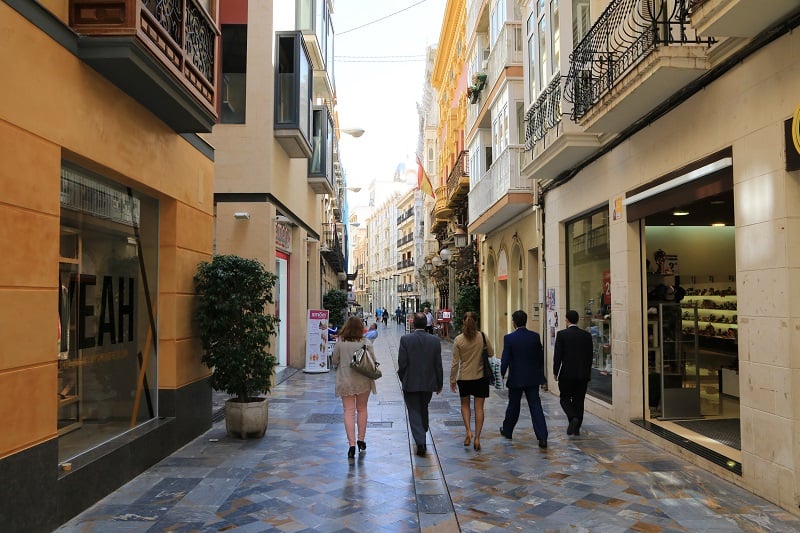
The main shopping street, Calle Mayor , runs from the Cartagena port area into the center.
Filled with local markets, lively bars, restaurants, and petit cafes, here you’ll be able to enjoy some good old shopping and grab a delicious coffee if you need a break from retail therapy!
A great place to enjoy the Carthaginian lifestyle and get to know the ways of the locals. – Check guided tours here
Enjoy tapas in Cartagena

The best way of ending your first day in Cartagena is definitely going out for tapas! Close to Calle Mayor , you’ll find plenty of original and unique places to grab a delicious Tinto de Verano and try some Andalusian delicacies!
In order to find the best tapas in Cartagena, have a look at the guided tapas tours . – Check prices here
Check out one of the best tapas bars in Cartagena and fill your belly with amazing treats:
- La Fortaleza (Calle Canon 7) – best for crispy Spanish croquettes
- Las Termas Del Pincho (Calle Honda 9) – great variety of pinchos
- Tasca Tio Andres (Paseo Alfonso XIII 46) – delicious seafood
Visit Spanish Civil War Museum
Visiting this museum is surely one of the most interesting things to do in Cartagena. The museum is extremely well organized, and will definitely make an impact on your perception of the Civil War while showing the harshness and difficulties of life during the bombardings.
You’ll be led through a channel of tunnels with audio-visuals and very well restored sets – making it truly an intense learning experience!
Opening times: Tue – Sun: 10:00 – 19:00
Visit Naval Museum
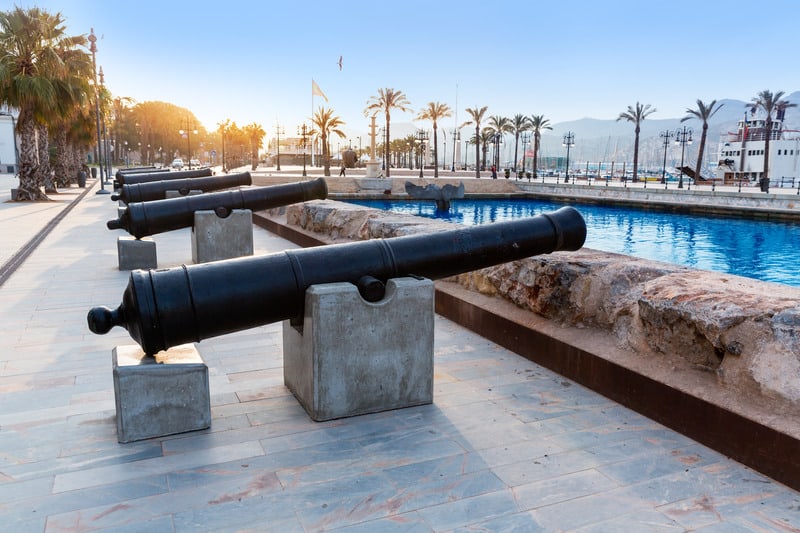
You’ll find the Naval Museum just next to the Puerto de Cartagena . It’s a fascinating place where you can discover the underwater world of the navy, and explore the machinery and weapons of Carthaginian ships.
The museum is excellently prepared for visitors and holds plenty of large scale models of warships, showing their evolution through the ages.
The general entry is free of charge, but you will be able to leave a donation and support the local museum!
Opening times: Tues – Sun: 10:00 – 14:00
Climb Castillo de la Concepción
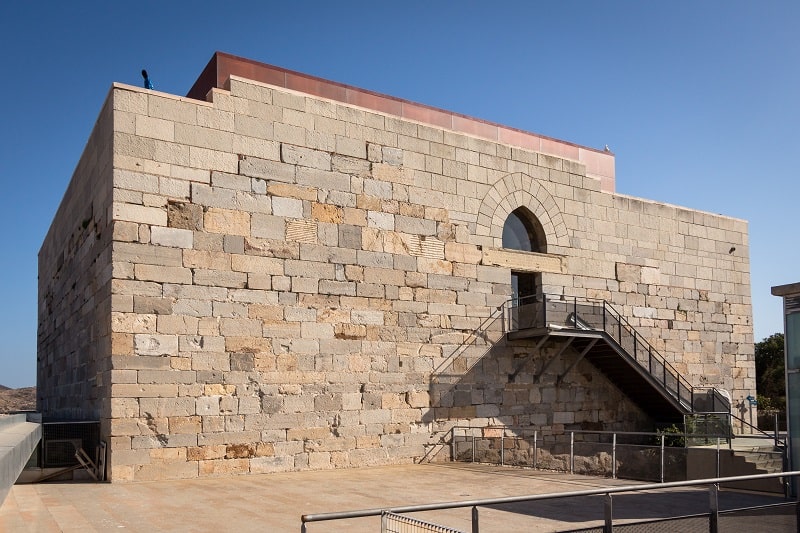
For a breathtaking view of the city, make your way up the castle of Cartagena! It’s located on a hill in the city center, where it has served as a Roman temple, a Muslim fortress, a medieval castle, and the watch out point during the Civil War.
Feel free to climb the lengthy staircase, or take the comfortable lift up to the top, and enjoy the incredible panorama of Cartagena and the port.
Opening times: Tue – Sun: 10:00 – 17:30
Lunch in La Alacena de Maria
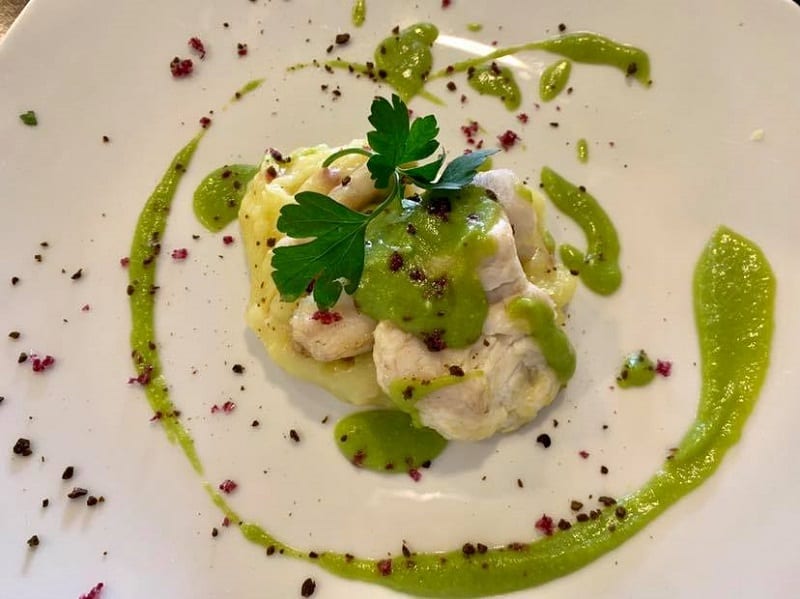
When visiting the Murcia coastline you must try the delicious and fresh seafood dishes this region has to offer.
La Alacena de Maria (Calle Real 24) is known to be one of the best restaurants in Cartagena for lunch, and will take you on a delicious exploration of fresh and tasty seafood, prepared in the most traditional way!
Try their Merluza con Parmentier de jamón y crema , and allow the chefs to surprise you with not only flavors but also a gorgeous presentation!
Mon – Sat: 9:00 – 11:00/13:00 – 16:00 Sun: 13:00 -16:00
Explore the town’s only beach: Cala Cortina
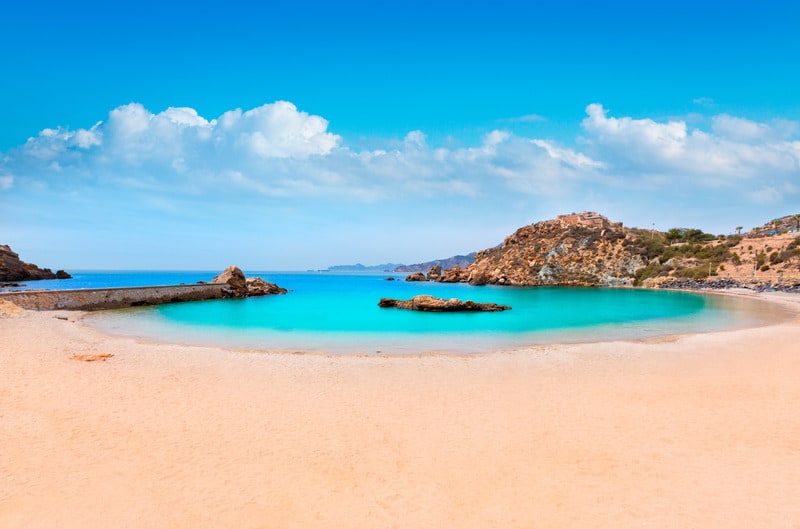
If you’re researching Cartagena beaches, there’s actually just one. Beaches in Cartagena are not as common as in other coastal cities, but you’ll find a beautiful little cove located a few minutes outside of the city – Cala Cortina !
A lovely sandy beach with clear water is a perfect spot to rest from the city hustle and bustle, and enjoy some sunbathing or snorkeling.
Right next to Cartagena beaches you’ll also be able to grab some tapas and enjoy a delicious sunset drink, thanks to many bars and restaurants just across the street!
Do a sailing cruise in Cartagena
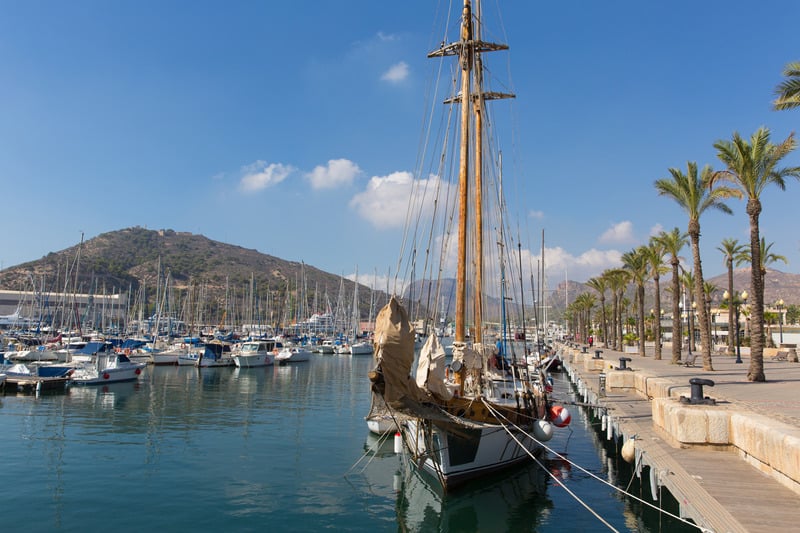
If you’re looking for a unique and exciting way to spend time in Cartagena why not hoping on a cruise boat to explore the coastline!
Cartagena’s port has many sailing trips and cruises to offer, and it’s a great way to enjoy a magical sunset from the sea waters.
Seeing the Roman city from a distance will definitely become a strong and beautiful memory of your trip to Spain. – Check sailing tours here
Finish the day with a food tour in Cartagena
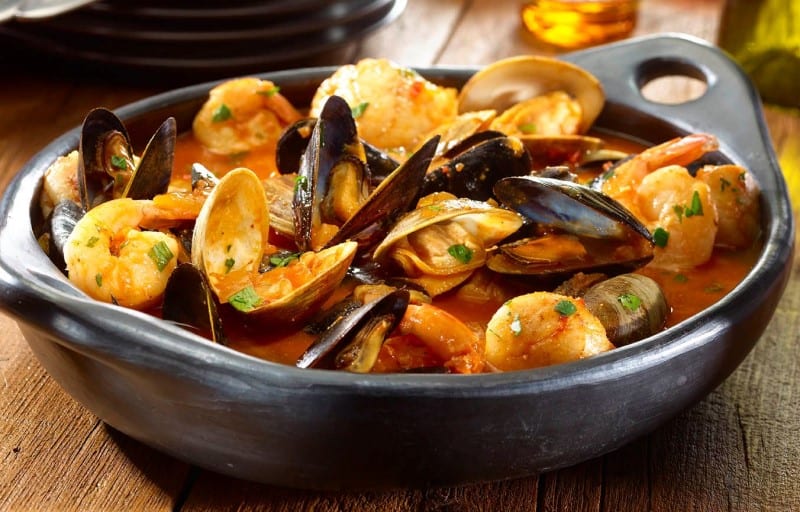
Taking part in a food tour is one of the best plans for the evening! Spanish cuisine is famous all around the world and with such tours, you’ll be able to discover hidden restaurants and delicious treats of Cartagena.
You’ll be able to try one of the most traditional Cartagenian dishes, such as Mojarra or Cazuela de Mariscos !
- Street Food Tour of Cartagena
- Cartagena Tapas and Culture
To learn more, please visit our ultimate guide about the best Andalusian food .
Check food tours in Cartagen, Spain here
Enjoy dinner in the best restaurant in Cartagena
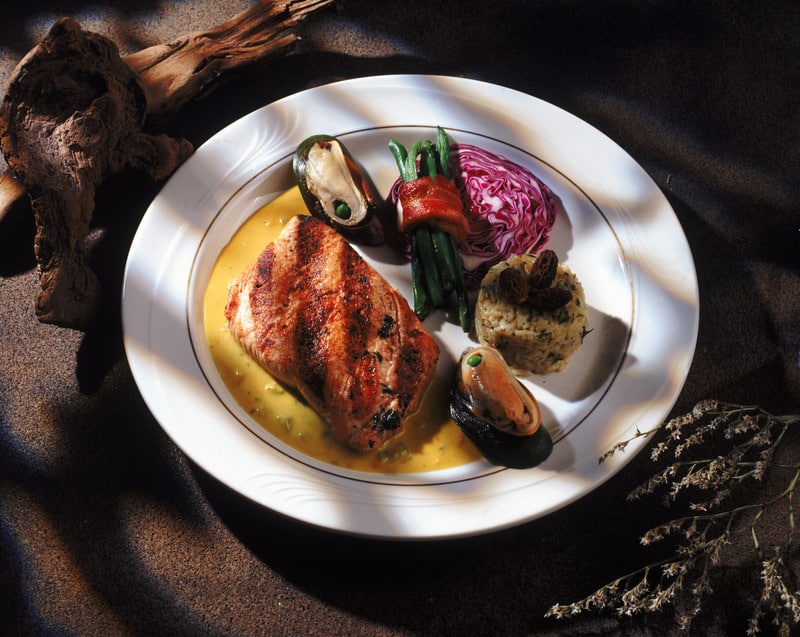
La Marquesita is known to be one of Cartagena’s best restaurants, and is a perfect choice for an elegant dinner in a friendly atmosphere!
A lovely interior, together with the very helpful staff and talented chefs will make your evening a memorable and delicious experience.
Try the famous Arroz y Bogavante or Bacalao Encebollado , and don’t forget to order their delicious dessert – Corazon de Mousse de Chocolate Negro !
Day 3: 3 days in Cartagena
If you’ve seen all the parts of Cartagena that you’d like to, day 3 can be spent visiting places near Cartagena like Murcia and Mar Menor.
Day trip from Cartagena to Murcia
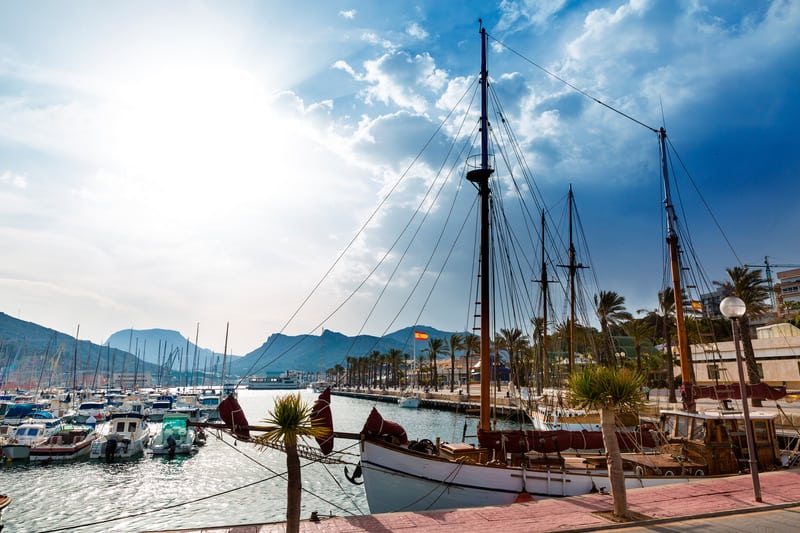
Murcia is located just 50 km north from Cartagena and is a perfect destination for a day trip, especially if you’d like to change from Cartagena’s Roman-style to a more modern, yet still authentic, Spanish city.
Not to mention the famous Murcian cuisine you’ll be able to discover when rumbling through tapas bars in town!
Best places to see in Murcia:
- Cathedral de Santa Maria
- Jardin de Floridablanca
- Plaza Cardenal Belluga
For more information on Murcia, please visit the following guide with the perfect 3-day itinerary for Murcia . For now, why not try our Murcia salad recipe or even our Puntillitas Fritas recipe .
Day Trip to Mar Menor from Cartagena
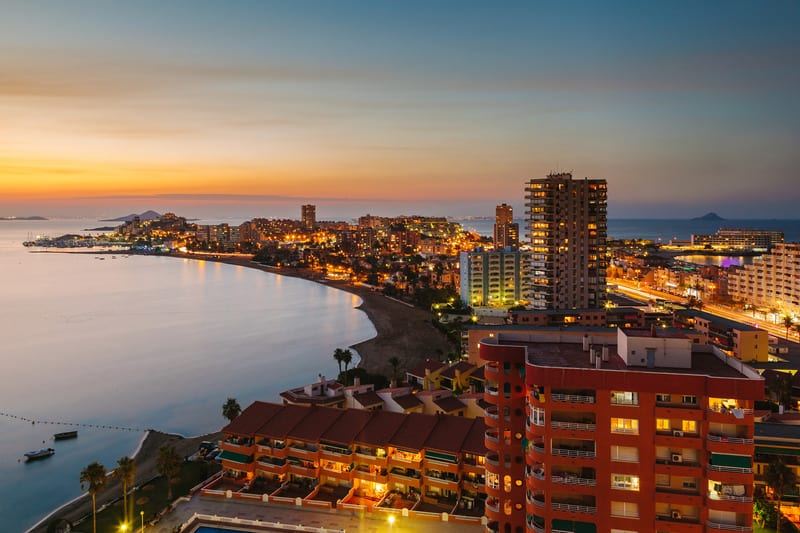
Another great idea for a day trip would be visiting the extraordinary areas of Mar Menor – a beautiful saltwater lagoon surrounded by Spanish port towns.
It’s a great place to enjoy the wilderness of the Murcia coast, and explore the beauty and roughness of the Mediterranean cliff sides. Best places to see around Mar Menor:
- Puente de la Risa
- Puerto Deportivo Tomas Maestre
- Cala Del Pino
- Las Charcas Mud Baths
Day Trip to La Magna from Cartagena
La Manga is located a 30-minute drive away from Cartagena. The ALSA – L20i Puebl bus also runs frequently between La Magna and Cartagena and takes 1 hour, 5 minutes.
Also known as La Manga del Mar Menor, the area is a seaside spit of Mar Menor.
The area is famous for its beaches, especially Playa de Paradiso and Playa de La Cala . Playa de Paradiso is one of the best beaches in Southern Spain .
Mar Menor is Mar Menor is the largest saltwater lagoon in Europe and is even known to have therapeutic properties. There are many watersports available to try including sailing, kayaking and paddleboarding.
Also in the area is Calblanque Natural Park , where there are plenty of hiking options and stunning coves for swimming.
If you plan to stay late, the area is famous for its nightlife. The ‘La Magna Strip’ has many bars and restaurants as well as shops open late.
Day Trip from Cartagena to Alicante
Alicante is located 1 hour, 32 minutes drive North of Cartagena. The city is the capital of the Alicante region. It’s best to drive or book a private transfer; otherwise, you will have to travel by bus via Murcia.
Alicante is a beautiful city with ample beaches, a stunning marina and is home to Santa Barbara Castle, which towers over the city. Alicante is also one of the best places in Spain for good-value tapas.
Here are the best things to do in Alicante on a day trip from Cartagena:
- Walk along the Explanada de España
- Visit the MACA Contemporary Art of Picasso
- Walk around the Basilica of St. Mary
- Discover Mercat Central d’Alacant
- Walk along Deportiva del Puerto de Alicante
Go Horseback riding near from Cartagena

Thanks to the incredible beaches and natural resorts all around Cartagena, you can also decide on going on a Horseback riding trip !
Whether you’d like a romantic ride on the beach or relaxing forest retreat, you’ll be able to experience a thrilling and bonding experience with nature and horses. – Check guided rides here
At the beginning of this article, we mentioned how to get from Almeria to Cartagena, but we didn’t mention the things to do in Almeria . Be sure to check it out since it is only a short trip from Cartagena.
Best Hotels in Cartagena, Southern Spain
Below you’ll find the 3 top spots from luxury to cheap accommodation in Cartagena , which will provide you not only with a good night’s sleep, but also great commodities and location.
Hotel Sercotel Alfonso XIII **** – Luxury
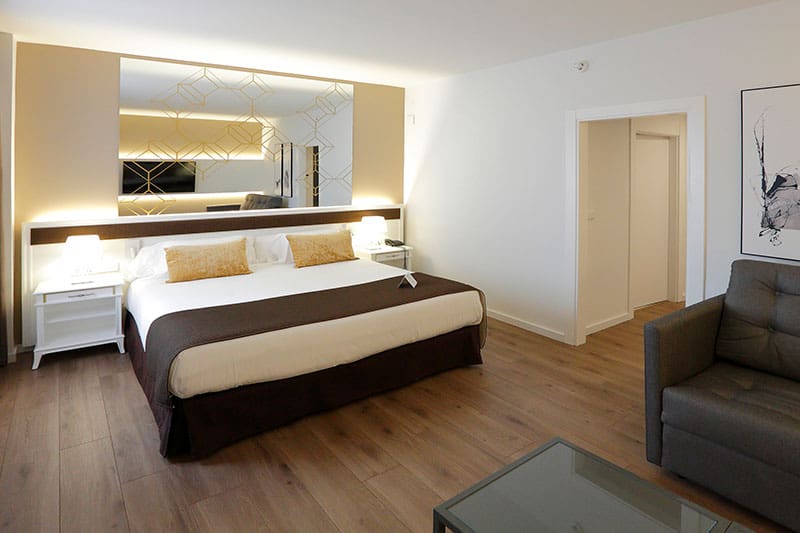
One of the best hotels in Cartagena Spain, located close to the Punic Wall, is a great choice for the most demanding travelers.
The rooms are very spacious and well designed, allowing you to really make yourself comfortable and feel at home!
The Sercotel Alfonso XIII offers additional services such as free wifi, restaurant, bicycle, and car rental, free parking and conference rooms – all to make your stay a pleasant experience! – Check rates & reviews here
Sercotel Carlos III *** – Mid-Range
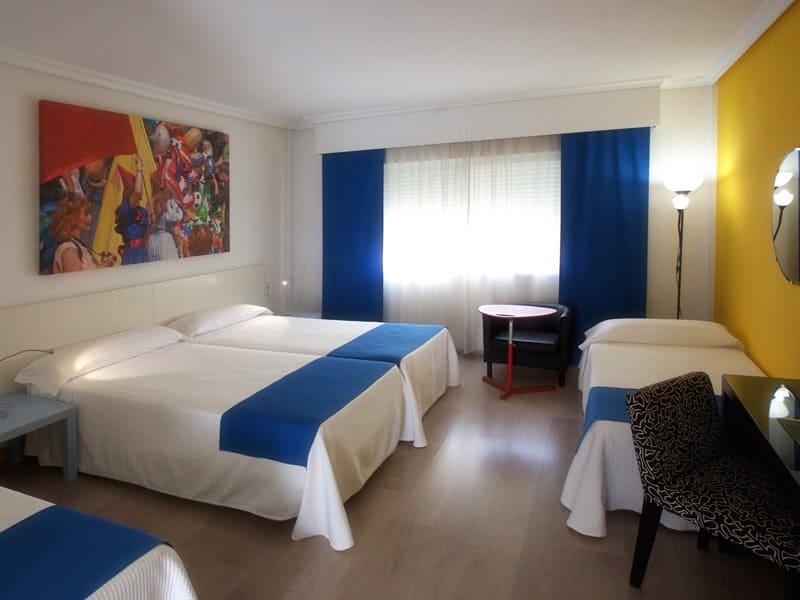
Located just 500m from the main bus station, and very close to the marina, Sercotel Carlos III is a great place to enjoy your stay! A very friendly, colorful decor and tidy rooms are all that you need to feel good and rested.
The hotel offers additional services such as free wifi, restaurant, and breakfast buffet, bicycle rental, indoor workout room, and parking. – Check rates & reviews here
Hotel Los Habaneros *** – Budget
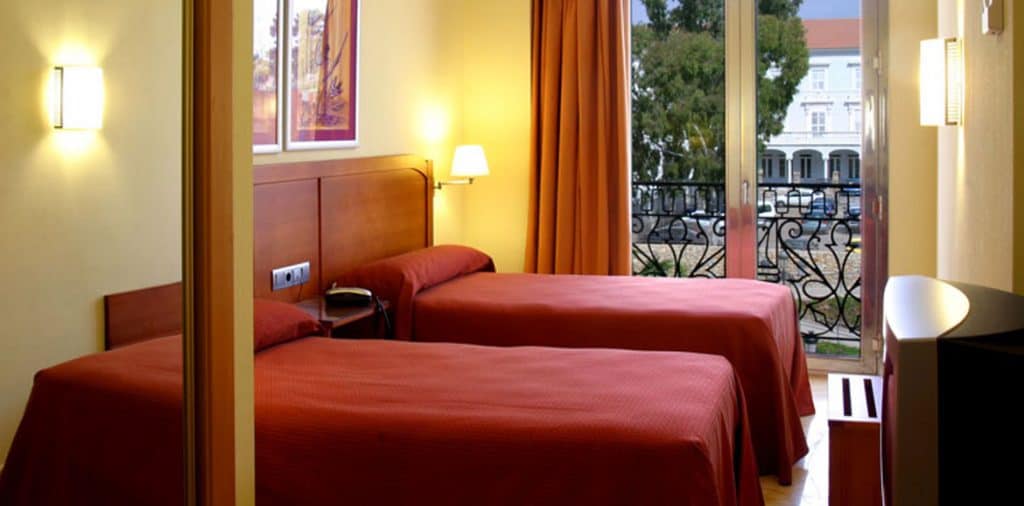
Hotel Los Habaneros is located near the Roman Theater and the Port of Cartagena, and is known to be a great choice for budget travelers!
Decorated in a traditional Andalusian style, you’ll find clean and tidy rooms attended by very helpful staff on site.
The hotel offers additional services such as: free wifi, bar, bicycle rental, paid parking and meeting room. – Check rates & reviews here
Getting Around Cartagena
Biking and walking are definitely the best ways to discover Cartagena! The city is very well connected by cycling and walking paths and it’s a joy to explore it on foot.
Not to mention that the distances between the main tourist attractions are very small, and you’ll be able to reach them in no time!
Best Attractions in Cartagena, Spain Map
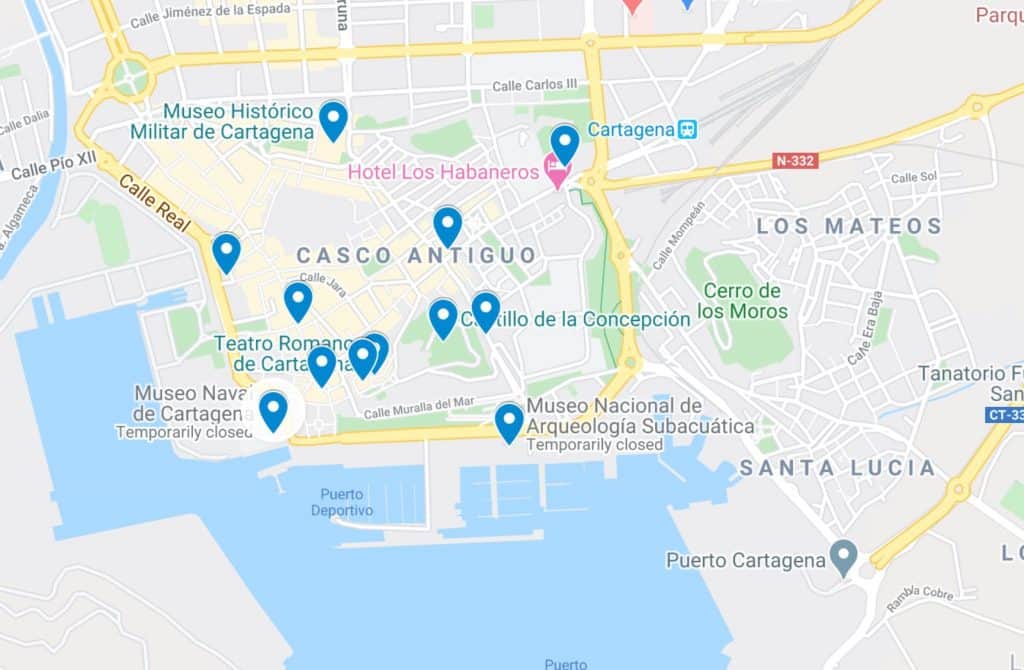
A short FAQ about Things to do in Cartagena, Spain
What are things to do in cartagena, spain with family.
Discover the Roman theatre and Roman heritage of Cartagena are great things to do in Cartagena with a family.
What are free things to do in Cartagena, Spain?
Visiting the ARQUA – Marine Archaeology Museum, the military museum of Cartagena, and the Naval Museum are some free things to do in Cartagena, Spain.
What are unusual things to do in Cartagena, Spain?
Doing a sailing cruise in Cartagena is quite an unusual thing to do in Cartagena, Spain.
What is Cartagena, Spain, known for?
Cartagena is renowned for its rich maritime history, impressive Roman Theatre, and Modernist architecture. It is also famous for its natural harbour and beautiful old town.
Is there good nightlife in Cartagena, Spain?
There isn’t a huge nightlife in Cartagena. However, there are plenty of bars open late, some with live music.
is Cartagena Spain worth visiting?
Yes, there are lots of amazing things to do in Cartagena from exploring the old town to discovering more about Murcia’s Roman heritage. Cartagena is also home to Cala Cortina beach!
Where do cruise ships dock in Cartagena, Spain?
Cruise ships dock at Cartegena cruise port which is called Pier Alfonso XII Cruise Terminal. From here you can walk to the city centre. There is also a terminal slightly further away from the Cartagena centre called Muelle de la Curra. From here, there is a shuttle bus to the centre.
Can you walk around Cartagena, Spain?
Yes, Cartagena is a very walkable city. You can walk between all the main attractions. There are also lots of hikes you can do from Cartagena.
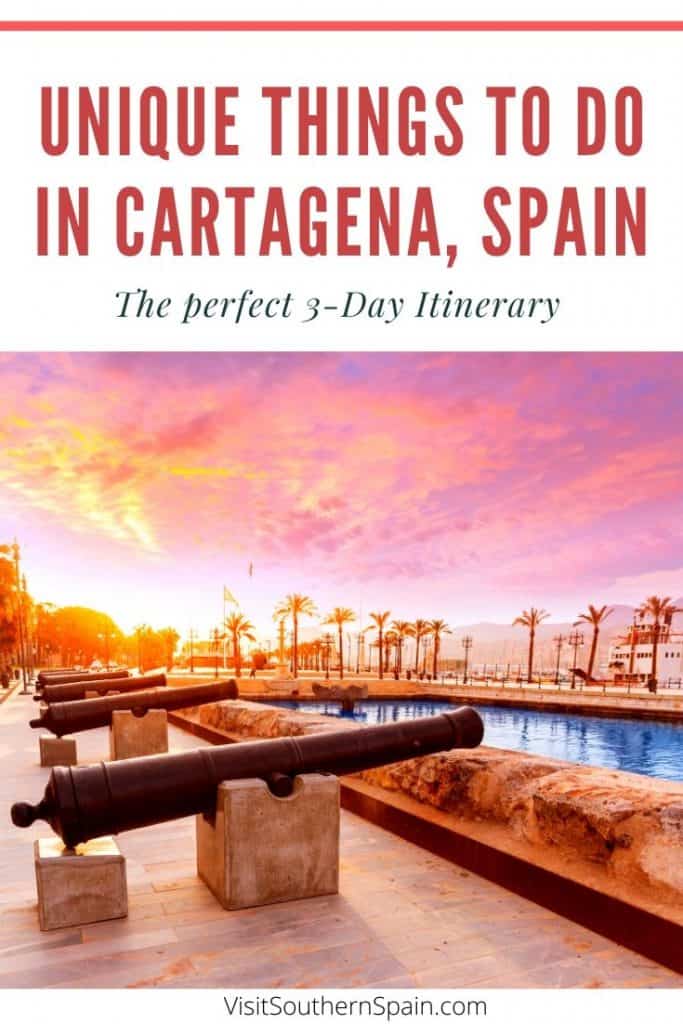
Hola, I’m Paulina! Together with my team, we are passionate about Southern Spain. Here we share all you need to know for great times in Southern Spain with the best places to visit, stay and, of course, the best food to eat.
Let’s dive in and explore Southern Spain’s outdoors, food and culture con pasión!
Thursday 8th of June 2023
Thank you for this itinerary! hoping to explore Cartagena next Tuesday, can't believe there's a beach too!
Kim Ratcliff
Monday 12th of October 2020
I have a Silver & Clothing shop in Calle San Fernando called Mystic Sol could I advertise with you ?kind Regards Kim .
Thursday 3rd of December 2020
Hi Kim, I sent you a mail! Can't wait to hear from you!
15+ Best Things To Do In Cartagena, Spain
Cartagena, the one in Spain not Colombia, is a small port city with a long and rich history. Its strategic location on the coast and closeness to the mineral reserves made the city an important hub for more than 2000 years. Over these years, Carthaginians, Romans, Arabs, and finally Spaniards, inhabited the area and each left its mark on the city. Nowadays Cartagena is full of ancient ruins, museums, and historic sites, which makes it a real paradise for history buffs.
But don’t worry if history is not your jam and you don’t feel like visiting museums. Thankfully, it’s not the only attraction city has to offer! In this post, we’ll show you many great things to do in Cartagena, Spain and you’ll choose which ones interest you most. We’re sure that among all of them, every traveler will find something for himself. Without further ado, let’s go!

Created by Sonia & Wojtek
One day, we packed our lives and slowly rushed into the unknown with smiles on our faces. We’re full-time digital nomads traveling in Europe who inspire to live, travel, and discover differently. Sunny coastal destinations are what we love most. We share travel guides, tips, and know-how to make planning your next trip a piece of cake. Real human experience and verified facts only!
This website uses affiliate links thanks to which we may earn a commission for purchases you made at no additional cost to you. If you like the content, consider using those links to support us. Thank you!
Cartagena, Spain FAQ
Cartagena is located in the Region of Murcia in Spain , on the Mediterranean coast known as Costa Calida .
Nowadays, without a doubt, Cartagena in Spain is best known for its numerous Roman ruins spread all over the city, and especially for its impressive and well-preserved Roman Theatre. Many travelers also will associate the city with Art Nouveau architecture which is filling the streets of the old town, its important naval history, and for being one of the most important harbors in Spain.
Absolutely! Cartagena is definitely a city worth visiting. In our opinion, it’s the most interesting and beautiful city in the Region of Murcia. A charming old town full of art nouveau architecture, a bustling harbor, a picturesque coastal setting, a warm Mediterranean climate, archeological sites, ancient ruins, spectacular views, and delightful cuisine – all of that really tempts you to visit and see Cartagena with your own eyes.
Cartagena is a walkable city, easy to get around on foot as most of the attractions are located close to each other within a short walking distance. Also, be aware that it’s a city with some hills and stairs to climb but it shouldn’t be a problem for those who are fairly fit and don’t have any mobility issues. In case of any problems. You can use public transport or a taxi.
Cartagena is a great destination for a one-day trip, a weekend getaway, and even a home base for longer stays to slowly discover the Region of Murcia. We started exploring Cartagena early in the morning, around 8AM, and without rushing we managed to see all we wanted in one day. But if you want to get to know the city even better we recommend staying at least for 3 days.
The best time to visit Cartagena in Spain depends on your personal preferences for things like crowds, weather, or desired activities. Summer months will be the hottest, driest, and most crowded. During the low season months temperatures will be more pleasant, there will be fewer crowds, and prices will be lower.
We can only speak for ourselves but we felt safe in Cartagena in Spain. Like in any touristic place, be cautious and take basic safety precautions, such as being aware of your surroundings and keeping an eye on your belongings, particularly in crowded areas and popular tourist spots.

Restaurants, accommodations, and map
Check out various recommended places below.
Where to eat in Cartagena?
Here are your best, high-rated options in Cartagena:
- Bodega La Fuente
- El Soldadito de Plomo
- Restaurante Techos Bajos
- Restaurante Bahía
- Delicia Tropical
- Cotton Grill
Where to sleep in Cartagena?
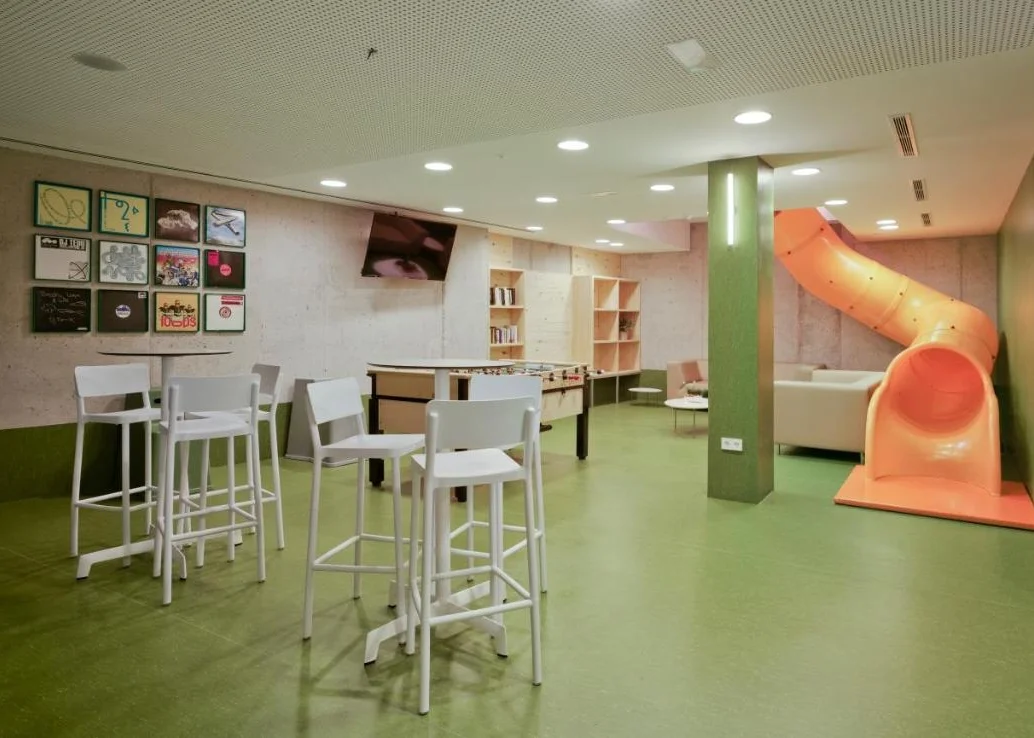
Loop Inn Hostel
Loop Inn Hostel is a vibrant and modern hostel located in the heart of Cartagena. With its lively atmosphere and friendly staff, it offers a welcoming and comfortable stay for travelers looking to explore this beautiful coastal city. The hostel provides various accommodation options, including dormitories and private rooms, as well as a communal kitchen, rooftop terrace, and common areas, making it a great choice for budget-conscious travelers and backpackers.
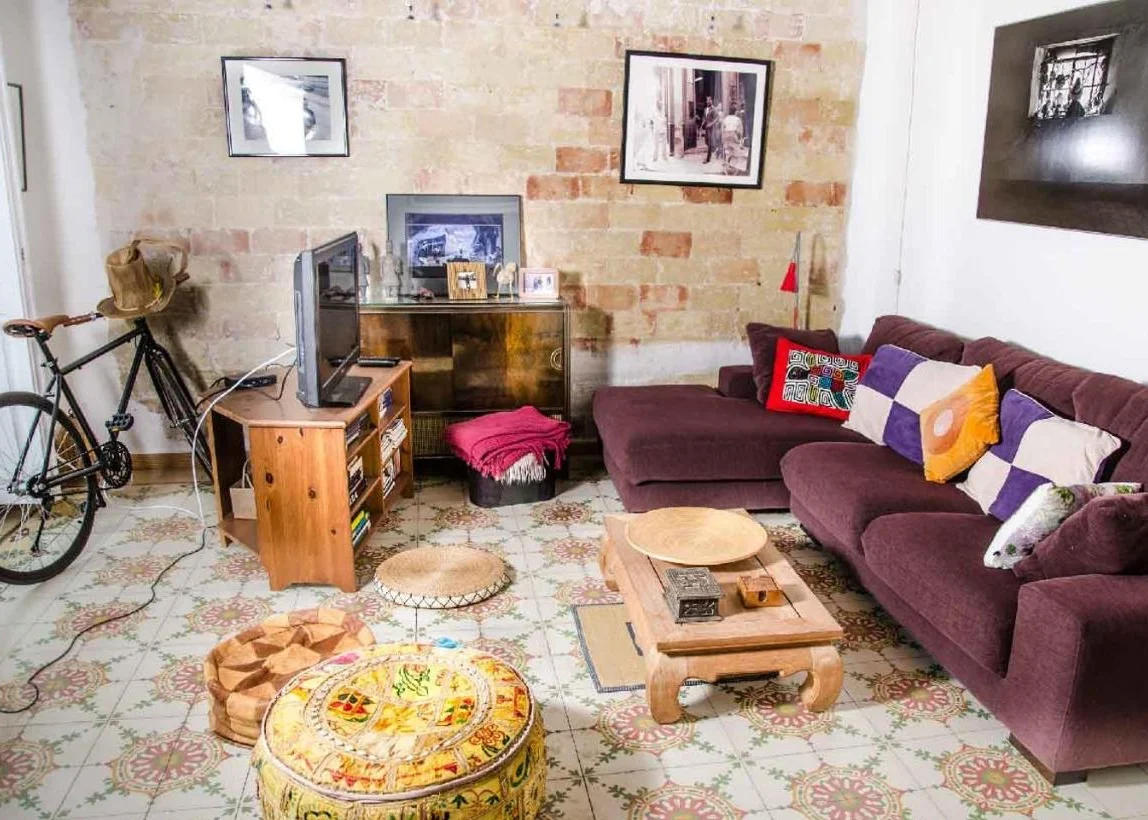
Apartamentos Turisticos Teatro Romano
Apartamentos Turisticos Teatro Romano offers a fantastic stay in Cartagena. It offers modern and spacious apartments located just a stone's throw away from the iconic Roman Theatre. The apartments are elegantly furnished and equipped with all the necessary amenities for a comfortable stay, making it a perfect choice for both short and long-term stays in the city.
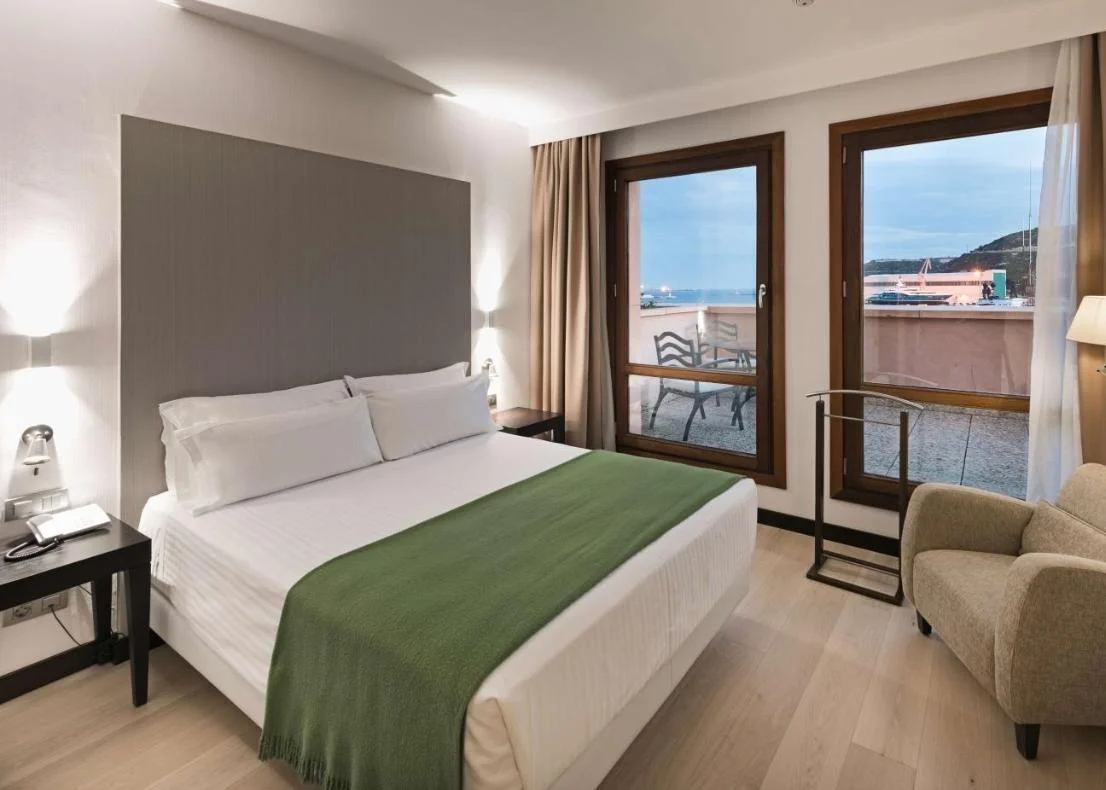
Nh Cartagena Hotel
NH Cartagena Hotel is a stylish and contemporary accommodation option conveniently situated in Cartagena. With its modern amenities, comfortable rooms, and attentive staff, the hotel offers a comfortable and enjoyable stay for both business and leisure travelers. Its strategic location provides easy access to the city's main attractions, making it an ideal base for exploring Cartagena's rich history and culture.
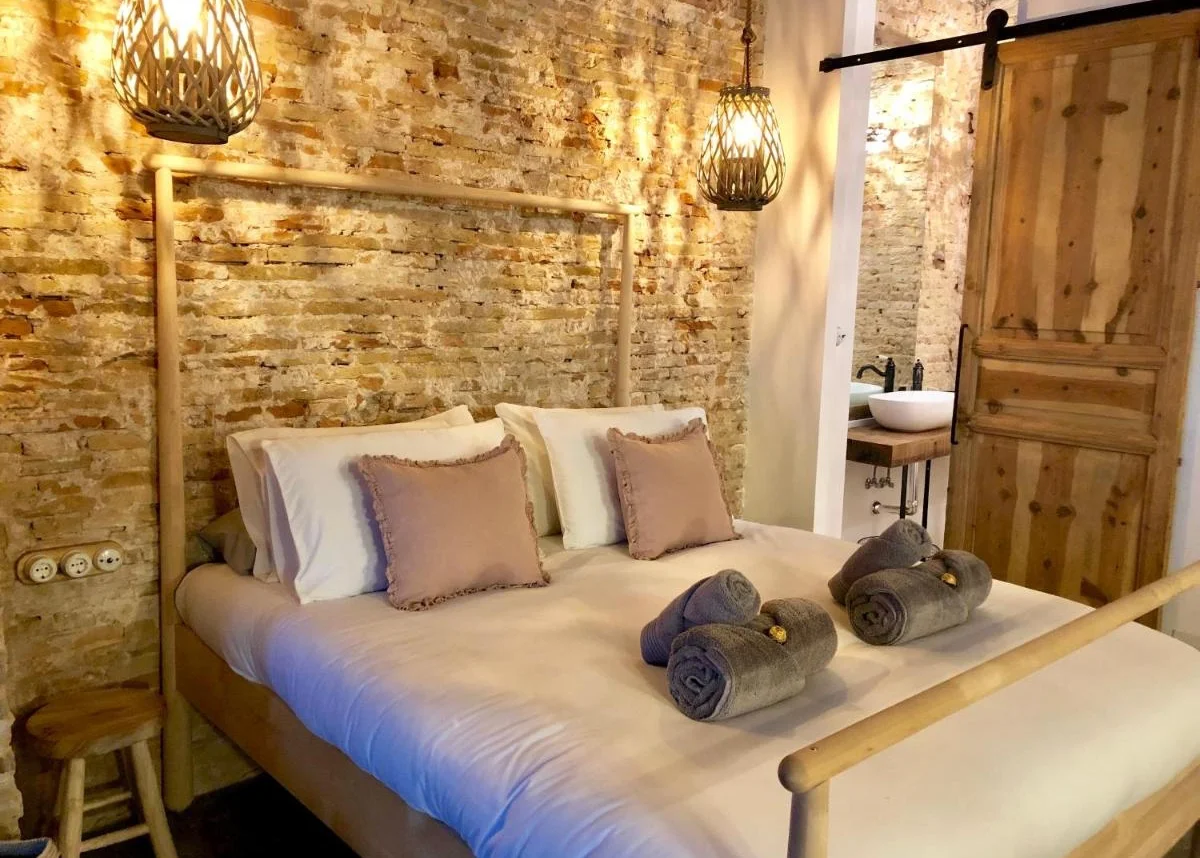
Casa Poeta Pelayo
Casa Poeta Pelayo is a charming spacious apartment with a terrace and city views, nestled in the heart of Cartagena. The property with two bedrooms, a living room, a kitchen, and two bathrooms boasts a very unique design making it a place for a very pleasant stay in the city.
Accommodations photos source: booking.com
Cartagena, Spain - Map of places
Traveling in region of murcia.
- Best Coastal Cities in Spain
- 20+ Best Beach Towns In Southern Spain
- Best Places To Visit In Region Of Murcia
- Murcia City
- Bateria de Castillitos
- La Manga del Mar Menor
Pin & share: 15+ Best Things To Do In Cartagena, Spain
Your travel resources handy in one place 🗺️, 🏨 accommodations.
For a short stay check out Booking or Agoda . Staying longer? Take a look at the offers at Airbnb .
🎫 Book tours
Are you up for taking part in epic guided tours? Book ones you like using GetYourGuide or Viator .
🚗 Rent a car
To find great rental car deals check out Rental Cars and get ready for your car trip!
✈️ Book a flight
For the hottest deals check out WayAway or Skyscanner .
🚆 Get train tickets
Love traveling by train in Europe? Book your tickets on Trainline .
🧳 Travel insurance
Enjoy peace of mind during traveling and don't leave your country without good travel insurance. SafetyWing or World Nomads are the best in class.
To stay safely connected while traveling, don’t forget about a good VPN. We recommend Surfshark or NordVPN .
🌐 Mobile internet
To stay online always and have roaming bills in check use Airalo - the world’s first eSIM store with digital data packs for over 200 countries/regions!
💰Travel finances
Get your travel finances smart and straight with Wise or Revolut .
Leave a Comment Cancel Reply
Your email address will not be published. Required fields are marked *
Save my name, email, and website in this browser for the next time I comment.
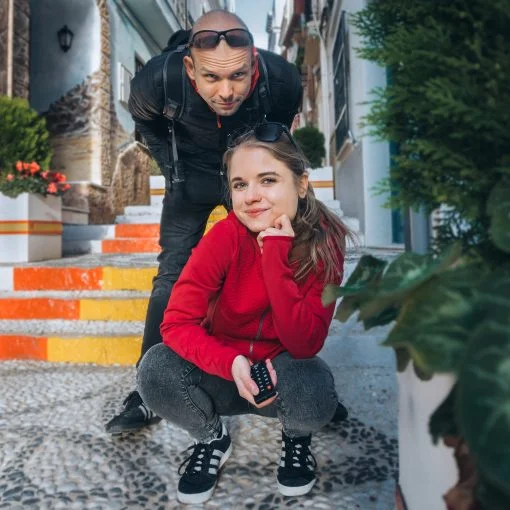
Hello Travel Seeker! Sonia & Wojtek here. One day, we packed our lives and slowly rushed into the unknown with smiles on our faces. We’re full-time digital nomads who inspire to live, travel, and discover differently. Join us and get all the answers you need to start your own journey.
Region of Murcia - TOP3

15+ Best Things To Do In Murcia City In Spain
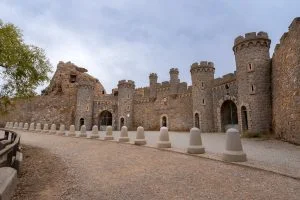
Bateria De Castillitos Cartagena, A Fairytale-Looking Fortress In Spain


- Best of Spain
- Cities & Villages
- Beach Destinations
- Top Attractions
- Map of Spain
- About España Guide
CARTAGENA Spain
- TOP THINGS TO DO
- Welcome to Cartagena
Cartagena is a small port city with a big history . Since its founding in 227 BC, the city has been ruled over by Carthaginians, Romans, Arabs and finally the Kingdom of Spain . There are numerous archaeological sites, including the Roman Theater that was only just discovered in 1988!
Cartagena is also home to a world-class naval museum and a charming old town with plenty of modernist architecture to discover.

This article might include affiliate links, allowing us to earn a small commission at no extra cost to you. Check our disclosure page for more info.
- Map of Cartagena
Visit Cartagena, Spain
- Roman Theater & Museum
- Naval Museum
- Concepcion Castle
- Consistorial Palace
- Cala Cortina
- Beaches of El Portus
- Tourist boat and Navidad fort
- Roman forum, Fortune house & Augusteum
- Civil war shelters museum
- National museum of underwater archaeology
- Punic wall interpretation center
Top Hotels & Apartments in Cartagena
Map: cartagena.

This small port city is home to 216,000 inhabitants and is located in the southeast corner of Spain. Its wide bay is one of the best protected ports in all of the Mediterranean . It was for this reason, as well as its close proximity to a silver mine, that the Carthaginian general Hasdrubal the Fair founded the city in 227 BC .
Its original name was Kart hadašt which was Phoenician for “new city.” This is the same name that was given to the original Carthage in modern day Tunisia. After the Carthaginian defeat in the second Punic War, the Romans gained control of the city which was renamed to Carthago Nova .
The Romans fully exploited the mineral reserves of the surrounding mountains and took advantage of Cartagena’s privileged defensive location on the coast. Most of the ancient ruins that can be seen in the city today date back to this time period.

In 714 AD, the Moors conquered most of the Iberian peninsula and Cartagena was mostly forgotten. That is until the 1700’s when it became one of Spain’s leading naval ports .
In 1873, Cartagena established itself as its own self-governing canton for a period of 6 months and put itself in the center of Spain’s Canton Revolution . The city was heavily shelled and it’s estimated that 80% of the city’s buildings were destroyed before everything was all said and done.
Today, Cartagena is one of three main navy bases for Spain .
- The city’s tourism office offers several combined tickets that will help you save money when visiting Cartagena’s landmarks. A great option is the 13€ voucher that allows access to the city's top 4 tourist sites (Roman Theater, Roman Forum, Conception Castle & panoramic lift).
- Avoid visiting on Monday , because most of the tourist landmarks are closed.
Best Things to Do in Cartagena
Roman theater.

Cartagena’s Roman theater ( 6€ entrance fee ) is the city’s main tourist attraction and visiting it is at the very top of the main things to do in Cartagena.
Built by the Romans in the 1 st century BC , the theater had space for about 7,000 spectators. Remarkably, houses were built on top of it and it remained buried for almost 2,000 years. It wasn’t discovered until 1988!
Access to Cartagena’s Teatro Romano is done through the theater museum, which occupies the Riquelme Palace located on the town hall square (Plaza del Ayuntamiento).
The visit to the museum starts along an underground corridor with an exhibition of archaeological remains found while excavating the theater.
After touring two more exhibition rooms, you will finally cross one last corridor running under the Santa Maria church until reaching the imposing Roman Theater, which you can tour freely .
NAVAL MUSEUM

Every city has museums. Sometimes too many in our opinion. Because the reality is that many of them don’t have noteworthy collections. And if the collection isn’t very interesting, then why visit? With that said, you can rest assured that the Naval Museum (free access) in Cartagena is indeed something very special . The collection is world-class.
The museum is divided in two buildings. The first building houses the original Peral Submarine, the main highlight of the museum . Designed by Isaac Peral , it was propelled by electric power and was the first of its kind to be used by the military.

Surrounding the submarine you will find some torpedoes and a beautiful collection of submarine and ship models, as well as a lot of interesting information. E.g. did you know that the first submarines were made out of wood?
The second building of the Naval Museum won’t disappoint you either . You will find military ship models, compasses and other historical navigation devices, ammunition, uniforms, old diving equipment, paintings, a huge torpedo, etc. The collection is very extensive.

Even if the idea of a naval museum doesn’t sound like your cup of tea, we think if you give it a try you will be pleasantly surprised. Aside from the Roman Theatre, visiting the Naval Museum is the top thing to do in Cartagena .
The museum if free but there is a suggested 3€ donation .

Unfortunately, Cartagena was mostly destroyed by bombings during the Cantonal rebellion that took place at the end of the 19 th century . However, a big mining boom took place shortly afterwards that created a new local bourgeoisie excited to show off their newly acquired wealth.
Luckily for us, they did so by building beautiful houses inspired by the Catalan modernist movement all over the city center. Thanks to them, strolling through the old town is one of the best things to do in Cartagena .
We recommend you to walk from the San Francisco square to the town hall square along the Honda and Mayor streets . The Calle Jabonerías is another noteworthy street with a great atmosphere, especially on the weekends.

The Plaza San Francisco itself is a charming square with several huge trees and incredible architecture on it (although a lot of it is quite neglected). A building that stands out particularly is the Casa Maestre , inspired by Gaudí’s Casa Calvet.
Walking along the Honda and Mayor streets you will see other cool buildings such as the Gran Hotel , the Casa Llagostera , the Casino and the Casa Cervantes .

Your walk will end at the elegant Plaza del Ayuntamiento (town hall square), located just a few meters away from the port. This square is presided over by the impressive Palacio Consistorial , seat of the city hall. This square is also where you will find the entrance to the Roman Theater Museum .
Make sure not to leave Cartagena’s old town without trying the most famous tapa of the region, the “marinera” . This curved breadstick is covered by a generous scoop of Russian salad which is then topped with an anchovy.
The marinera is the perfect tapa to accompany a cold beer on a sunny terrace!
CONCEPCION CASTLE

The Castillo de la Concepción (4€ entrance fee) is a medieval castle from the 13-14 th centuries located on top of one of the five hills that historically protected Cartagena.
The truth is, there isn’t much to see of the castle itself. The main thing to do is to enjoy the great views of the city from the lookout area , including the port and the Roman Theater. There are some great photo opportunities for the theater and the rest of the city.
Inside the fortress you will find the Interpretation Center of the History of Cartagena . It houses an exhibition about the 3,000 year history of the city and the different civilizations that have called it home.
If you don’t want to walk up to the castle, you can use the panoramic elevator , which ascends 45 m (148ft) and is located on Gisbert street . The easiest option is to buy a combined ticket castle + elevator which costs only 0.50€ more than the standard castle ticket.
CONSISTORIAL PALACE

The Palacio Consistorial is one of the main modernist buildings in the city and also one of the most beautiful ones. It was built between 1900-1907 by Tomás Rico, featuring an eclectic style with French influences .
This unique triangular building stands out for its majestic white marble facade, which is topped with one zinc dome in each of the three corners plus a larger one on top of the main entrance . It was actually the first building in the city to have electricity.

Today, for 1€ you can take part in a 20-30 min guided visit . In addition to learning about Cartagena’s history, you also get to see:
- The imperial marble staircase with a gorgeous stained glass ceiling.
- The "sala de plenos” (plenary hall) , featuring several original lamps, each of them weighing 500kg (over 1,100 lbs!) and made with over 10,000 crystals.
- The “oficina del secretario” (secretary’s office) featuring also several original elements such as the desk, typewriter, oil lamp…
- The “alcaldía” (mayor’s office) .
The Palacio Consistorial is one of the best things to do in Cartagena and, if you have the time, we recommend you to take part in a guided visit.
Beaches around Cartagena
Due to its great location in the coast of Murcia , known as Costa Cálida , Cartagena is surrounded by beautiful beaches. What’s even better, Cartagena features a semi arid climate, which is actually one of the hottest and driest climates in Spain . And La Manga del Mar Menor is less than 30 min drive away.

CALA CORTINA
Cala Cortina is one of the most beautiful beaches in all of Murcia . This 200 m long beach is made up of coarse sand and features tranquil crystal clear waters .
It has all services and amenities, including several chiringuitos (beach bars).
Cala Cortina is located 5 km east of downtown Cartagena . It takes about 10-15 min to get there by car, but it is also possible to walk (40-50 min). If you have the time, walking to Cala Cortina is a nice alternative . You will enjoy beautiful views of the coastline as well as great panoramic views of the beach itself on arrival.

To the west, the closest beaches accessible from Cartagena are in El Portús . Although in google maps you can see that there are some beaches closer to the city center, those are in military land and can’t be accessed.
El Portús is a tiny fishing village with a small pebbled beach followed by several tiny coves . Next to it is also the Camping Naturista (nudist campsite), located in front of another small pebbled beach.
Although the pebbles might not be the most comfortable, the waters are crystal clear! Just do like the locals and make sure to come prepared with beach chairs.

Throughout history Cartagena has been treasured for its port . If you are interested in learning more about the importance of its bay or just want to get out on the water for a bit, then taking a ride on the tourist boat (“barco turístico” in Spanish”) might not be a bad idea.
During the 45 min boat ride (6€ ticket) you will navigate around and out of Cartagena’s bay while sighting castles, defensive batteries and lighthouses . At the same time, the multilingual audioguide will teach you about their military, strategic and commercial importance over the centuries.
Note that you can pay 2€ extra and get off the boat to visit the Fuerte de Navidad . Although the truth is that there isn’t much to see on it, you can enjoy some nice views of the city. Keep in mind though, that you will have to wait a full hour to get back on the boat.
ROMAN FORUM, FORTUNE HOUSE & AUGUSTEUM

Cartagena’s Roman heritage goes far beyond its impressive theater. Here is a list of the other main Roman sites in the city:
- Located at the feet of the Molinete hill, the Roman Forum (6€ entrance fee) contains the archaeological remains of a block of the ancient Roman city that covers about 1,000 square meters (1/4 acre). There isn’t too much intact and the site is mostly made up of building foundations.
- The Casa de la Fortuna (2.5€ entrance fee) houses the remains of a small Roman villa from the 1 st century BC, discovered in the underground level of a modern building. While touring the house, you will be able to admire some murals and mosaics as well as get an idea of what it was like to live in Roman times.
- The Augusteum (2.5€ entrance fee) was a temple dedicated to the first Roman emperor , Caesar Augustus. Visitors can learn about the cult to the emperor and the exuberant performances staged at the temple.
CIVIL WAR SHELTERS MUSEUM
At Cartagena’s civil war museum-shelter (3.5€ entrance fee), you will have the opportunity to learn more about the city’s more recent history. During the Spanish civil war (1936-39), Cartagena was an important Republican stronghold. It was actually the last city in Spain to surrender to Franco's troops .
Due to its geographical location, it was very difficult to attack Cartagena by land or sea. Therefore, it suffered many air attacks . At this museum, you will visit one of the many shelters created to protect civilians during the bombings.
This audiovisual museum features real testimonies, images and sounds from the war, making it easier to imagine what it was like to live through such a horrendous and traumatic experience.
NATIONAL MUSEUM OF UNDERWATER ARCHAEOLOGY
The ARQUA or National Museum of Underwater Archaeology (3€ entrance fee) is responsible for the research, conservation and exhibition of the underwater cultural patrimony of Spain.
One of the main highlights of this interactive museum is the Odyssey treasure . This collection of over 570,000 gold and silver coins belonged to the frigate Nuestra Señora de las Mercedes, sunk in 1804.
PUNIC WALL INTERPRETATION CENTER
The Punic Wall Interpretation Center (3.5€ entrance fee) houses some of the only Carthaginian remains in all of Spain. They belong to a defensive wall from the 3 rd century BC, the same time period as the Punic Wars when the Carthaginians fought the Romans.
Next to the wall, you will also discover the burial crypt of the hermitage of San José built in the XVI and XVII centuries.

The 4-star NH hotel is one of the best hotels in Cartagena and our personal favorite. It features a superb location in a quiet pedestrian street in the heart of Cartagena . It’s situated right across from the Palacio Consistorial, next to the port and the Roman Theater.
The décor is elegant but simple. Most rooms feature stunning views of the bay and/or the adjacent Consistorial Palace . Superior rooms also have a balcony and a Nespresso machine .
Private parking is available on site . You can either book a room that includes free parking or pay 19€/day.
The B&B Hotel Cartagena Cartagonova is a recently renovated 4-star accommodation located 10 min walk away from the Roman Theater and 15 min from the port.
The décor at the B&B Cartagonova is modern and minimal. There is free coffee and tea for all guests at the reception area 24h/day .
At this property, they take sustainability seriously. They have proudly gone plastic free and they also offer free breakfast to the guests that opt out of the room cleaning service .
Private parking is available on site and costs 15€/day.
The LoopINN Hostel Cartagena is a quiet accommodation located on the edge of the city center (the roman theater is a 10 min walk away). It offers private rooms for up to 4 people, as well as beds in dormitories of 4, 6 or 8 beds .
This accommodation features simple white décor with quirky and colorful tiled floors and walls. It is somewhat basic, but still very nice and comfortable – it feels more like a hotel than a hostel.
However, since it is a hostel, it features certain shared spaces such as a kitchen, a TV room and, best of all, a rooftop terrace with great views .
Although there is no parking at this accommodation, there is usually free parking in the surrounding streets.
MORE HOTELS IN CARTAGENA
Apartamentos turísticos Puerta Real offers stylish 2 bedroom apartments for up to 6 people . The property is located in the city center, just one block away from the main pedestrian street in Cartagena’s old town.
The apartments are new, clean and spacious. They feature chic modern décor and great views of the port. The two units in the top floor even have a private terrace with a jacuzzi .
Apartamentos turísticos Puerta Real might not be the cheapest apartments in Cartagena, but you get a lot for the money .
Private parking is available at a location nearby for 10€/day.
Apartamentos turísticos centro histórico offers 1, 2 and 3 bedroom apartments for up to 6 people in Cartagena’s historic center.
These bright and spacious apartments feature simple décor and are fully equipped. Although they might not be the most stylish, they are among the cheapest in the city and definitely offer great value for the money .
Private parking is available on site for 10€/day.
Without a doubt, San Sebastián Suites offers the most stylish apartments in all of Cartagena . These exclusive apartments are located in a historic building right on the Plaza San Sebastián, at the heart of Cartagena’s city center.
All of these charming and luxurious apartments have 2 bedrooms (accommodating up to 4 people) and feature traditional balconies with beautiful old town views.
Each room has been carefully designed respecting the historic building. The modern and minimalist kitchens are fully equipped , including dishwasher and washing machine.
Public parking is available at a location nearby and costs 10 €/day.
MORE APARTMENTS IN CARTAGENA
EXTERNAL LINKS
- Official Tourism Website of the city of Cartagena
- Official Tourism Website of the province of Murcia
- Cartagena – Wikipedia
© Eusko Guide Ltd. All Rights Reserved. | Privacy Policy | Disclosure
Has España Guide helped plan your trip?
If so, please consider booking your hotel through the links to booking.com found on our website or use the following link: https://www.booking.com/?aid=1802409
That way, you get the best rates on your hotels and at the same time, it helps us to continue contributing to this site. Everyone wins!
10 Best Things to Do in Cartagena, Spain
:max_bytes(150000):strip_icc():format(webp)/d0598453a36aa6f71cb57cc8be377f9de9d6b98d-582c8418c5d24bcbb4ccdfcbf6293fce.jpg)
Eve Livesey / Getty Images
Founded in 227 B.C. by the Carthaginian Hasdrubal the Fair, Cartagena, a vibrant port city on Spain’s southeast Mediterranean coast, has a long history with a plethora of monuments documenting the passing of many civilizations.
Being a rather small city, it’s easy to walk from one site to the other, starting with the remains of the Punic Walls, continuing on to the second largest Roman Theatre of the Iberian Peninsula, enjoying the splendor of Art Deco buildings, and finishing the day with a panoramic view of the city and port on board a harbor cruise. Additionally, lovers of all things maritime will be delighted by the Naval Museum and a model of the world’s first submarine, invented by Cartagena-born Isaac Peral and launched in 1888.
Tour the Roman Theatre
Cartagena presumes of the second largest Roman Theatre on the Iberian Peninsula. Dating back to the first century, it was opened in honor of the visit of Gaius Cesar, grandson of Emperor Augustus.
The theatre could accommodate more than 6,000 people. It’s accessed via a pink building a which also houses the Roman Theatre Museum. Over three floors, the museum has a huge collection of Roman statues and artifacts, then leading via a glass bridge into the theatre itself. Behind it and visible from the theatre’s top tier are the Cathedral of Cartagena and remains of a Byzantine Wall.
Understand Ancient History at the Punic Wall
Cartagena has made a great effort to explain the sometimes complicated history to visitors. The Punic Wall Interpretation Center protects the remains of Cartagena’s oldest part, the Punic Wall, under glass walkways, whilst a video explains the founding of Cartagena. It’s of particular historical value because there are very few Punic remains Spain. During excavations, the 16th century Hermitage of San Jose was discovered. What remains is the crypt of the monks, with bones and skulls resting in several stories of burial niches and a quite macabre depiction of the Dance of Death.
Marvel at Casa de la Fortuna
Cartagena lived through its heyday when it was part of the Roman Empire. The wealth of the citizens derived from trade and abundant silver mines in the surrounding countryside.
The Casa de la Fortuna is a well preserved Roman villa dating from the first century. Marvel at the floor mosaics and the colorful wall paintings, among them a swan which is the most famous image of the villa.
Furniture, tools, and mannequins dressed in the clothes of the times evoke a vivid image of how a rich Roman merchant lived. Only discovered in 2000, the villa originally extended to 2,200 square feet. At the rear of the house you can see part of a Roman road with huge stone slabs and remains of their advanced canalization.
Climb the Concepcion Hill
Dominating Cartagena’s skyline is the 13th century Castle of Concepcion on top of the hill of the same name. Before King Alfonso X of Castille conquered Cartagena from the Arabs in 1245, it was the site of a Roman temple and an Arab Alcazar.
Access is from sea level at the King Charles III rampart via a winding path through a landscaped park full of flowers, ponds, statues and peacocks. The castle often features exhibitions, most recently of splendid Renaissance costumes. Make your way down via a footbridge to the outside elevator, illuminated at night.

Discover Art Deco Along Calle Mayor
Calle Mayor is the main pedestrian shopping street of Cartagena and the site of many outstanding Art Deco buildings. At the beginning of the 20th century, the growing mining industry brought wealth to the city and with it richly decorated townhouses and public buildings.
Prime examples are the triangular Town Hall and the casino. Casinos in Spain are not for gambling, but rather they are the seat of a cultural society.
Pass by the former Grand Hotel, now a bank, and the pink and white Casa Aguirre which also houses the Museum of Regional Modern Art. Finally, take a break at Cartagena’s most traditional bar, La Tartana.
Ride the Waves on a Harbor Cruise
LUNAMARINA / Getty Images
The natural, sheltered port of Cartagena is the main reason why so many civilizations fought over it. Enjoy the best view of the city from the sea with an entertaining harbor cruise. It leads past the cruise ship dock and commercial port into the open sea past two castles that guard the entrance to the port.
There are two options : a catamaran and or a closed boat with a sundeck. Both depart from the quay crossing Paseo Alfonso XII and down the steps. The tour in the boat lasts approximately an hour, while the catamaran trip is three hours and includes a stop at the recently refurbished castle Fuerte de la Navidad.
Learn about Cartagena’s Naval History
It’s not surprising that a city so closely connected to the sea has several venues dedicated to maritime history.
The Naval Museum, located in a fine 18th century building on the waterfront features a vast collection of tall ship models, naval uniforms, medals and the Peral submarine, which was built in the late 19th century by Spanish sailor Isaac Peral for the country's Navy.
Shiver at the Spanish Civil War Museum
The Spanish Civil War, fought from 1936 through 1939, brought suffering and destruction to Cartagena too. Coming down in the lift from Concepcion Hill, turn left and enter the Spanish Civil War Museum, a former shelter for the citizens and a dramatic testimony to the hardship of this dark time in Spanish history.
Become a Moor or a Roman
Visitors in September are in for a treat as they're given the chance to relive history up close and personal. The biggest festival, called Moors and Christians, takes over the city for two weeks with re-enactments of the battles and thousands of "soldiers" and "civilians" in historical costumes taking part in plays and parades. Everybody wears a piece of fancy dress and clinks glasses in the Feria precinct (the football stadium) in one of the many tents.
Explore Underwater Archaeology at ARQUA
Matías Soria / CC BY-SA 3.0
Further along the waterfront stands the modern building of ARQUA, which is the national center for maritime archaeology. A museum as well as a research facility for scientists, ARQUA’s most outstanding exhibit is a treasure of 14.5 tons of gold and silver coins recovered from the fregatte Nuestra Señora de las Mercedes that sunk in the early 19th century.
10 Best Things to Do in Sagunto, Spain
Top 20 Most Popular UK Cities for International Visitors
The 15 Best Things to Do in Alicante, Spain
20 Best Things to Do in Barcelona
The Most Architecturally Significant Building in Every State
Madrid on a Budget
Top 20 Most Popular French Cities for International Visitors
The 9 Best Things to Do in Saint-Tropez
Top 15 Destinations in the French Riviera
Cubas Capital City of Havana
The 9 Most Romantic Things to Do in Madrid
The Top 12 Things to Do Around the Eiffel Tower
The 12 Best Day Trips From Barcelona
Visit the East Coast of Spain
The 12 Best Things to Do in Casablanca
North Coast of France: The Ultimate Road Trip From Dieppe to Calais

9 Things To Do In Cartagena, Spain: A One Day Itinerary
Last Updated on February 20, 2024
by Michael Rozenblit
Disclaimer: This article contains affiliate links. That means if you click a link and make a purchase, we may make a small commission. As an Amazon Associate we earn from qualifying purchases. For more information, see our privacy policy.
When researching about the best things to do in Cartagena, Spain, I was constantly directed to articles about the eponymous city in Colombia. Cartagena is one of the most popular cities to visit in Colombia, while its namesake in Spain tends to often be overlooked by foreign tourism except for some cruise ships that stop here during the summer months.
This is a great shame as Cartagena has a lot to offer travellers; from ancient Roman history, a bustling city centre and pier and unique cuisine that offers you the chance to try dishes not found in more-travelled regions such as Andalucía , Catalonia or Madrid .
This article outlines how we recommend spending one day in Cartagena as well as some tips if you have a longer stay in the city.
Table of Contents
Getting To & Around Cartagena
While the majority of foreign visitors that make it to Cartagena arrive via a cruise ship, it’s incredibly easy to visit this city as part of a longer trip throughout Spain.
There are a few direct buses daily from Granada and Valencia making it a logical stop if you’re travelling between Andalucía and Catalonia or Valencia. It also makes for a logical day trip if staying in nearby resort towns such as Alicante .
If you have the flexibility of renting a car while in Spain (we recommend using Rentalcars.com to compare prices!) then a stop in Cartagena can be added onto a longer trip in the region of Murcia and along the Eastern Coast of Spain.
Once in Cartagena, the centre of the city is easy to get around and navigate on foot and you can easily get to all of these things to do without using public transport.
If you want to explore with the help of a knowledgeable local guide, then this guided walking tour of the city is a good option. And foodies will love this gourmet tapas tour of Cartagena.

9 Best Things To Do In Cartagena
Mercado de santa florentina.
One of the best ways to start your time in Cartagena is to head to the local Mercado de Santa Florentina . Open every day except Sunday from 8am to 3pm, this market has a range of typical fresh produce including fruits and vegetables, olives, cheeses, fish and meats.
Apart from picking up a few snacks for your day of exploring Cartagena, this is also a great place to enjoy a coffee and light breakfast.

Stroll down Calle Mayor
From the Mercado de Santa Florentina, head into the centre of the city by taking a stroll along the main pedestrian street in the old town of Cartagena – Calle Mayor.
Calle Mayor is a bustling place during the morning hours and once again in the evening, making it a great place to people-watch and appreciate the Art Nouveau architecture (and if you really want to appreciate the architecture, don’t miss the gorgeous town hall, either).
If you didn’t manage to fit in your caffeine fix at the market or simply need another one, then Calle Mayor is also a great place to enjoy a coffee and people-watch.
Kuss Cartagena became our go-to coffee place each morning during our time in the city and has an incredibly appealing selection of cakes and baked goods to accompany any hot drink!

Teatro Romano de Cartagena
One of the most historically important things to do in Cartagena is to visit the Roman Theatre. While you can get decent views of the Roman Theatre from various parts of Cartagena, it’s definitely worth paying to visit to learn more about the history of this site and be able to explore it properly.
The Roman Theatre was only rediscovered a few decades ago with excavation beginning in 1988 and completed in 2003 but it is now a top attraction in the city.
A visit to the Roman Theatre begins with a short film that alternates between Spanish and English which shows the history of the site and how it would have originally looked.
Visitors are then guided through a small museum that houses artefacts found during the excavation and an archaeological corridor that guides you finally to the theatre itself.
The Roman Theatre is open daily except for Mondays and with reduced hours on Sunday. Standard entry is €6 with discounts available for students and seniors. You can buy skip-the-line tickets here or purchase a combined ticket if you plan to enter other Roman ruins in the city.

Cartagena Port
From the Roman Theatre, keep heading south along Calle Mayor until you reach the Port of Cartagena. On a sunny day, this is a great place to enjoy a short stroll along the seaside or take a boat tour to see some of the historical sites around the city’s port.
The Tourist Boat leaves approximately every hour with reduced services during the low season. The ride lasts 40 minutes and takes you past several important historical sites including castles, forts, naval docks and lighthouses while also allowing you to enjoy nice views of Cartagena.
There is commentary in both Spanish and English so you understand the significance of what you are seeing and learn about the Carthaginian history and Punic War here.
Tickets cost €6 or €8 if you also want to get off the boat and visit one of the forts. During busier periods you might not be able to buy a ticket last minute so it can be worth coming to the ticket office before visiting the Roman Theatre to ensure you secure a spot for later in the day.

Calle Jara for Lunch
After an active morning, it’s time to head back up Calle Mayor and turn right down Calle Jara. On this street, you will find a few fantastic tapas bars conveniently located right next to each other.
Two of these bars, La Uva Jumillana and Bodega La Fuente are owned by the same people and actually have the other’s menus on the back of their own. Both these restaurants require you to order and pay at the bar and give you the food on a tray to take to your table inside or outside.
Bodega La Fuente is known for its fish dishes and is a great place to try a variety of toastas (flatbread) and montaditos (little sandwiches) with anchovies. A local speciality to try is marinera which is a crispy breadstick topped with Russian salad and an anchovy.
La Uva Jumilliana has a wider range of dishes with its specialities including a fantastic version of patatas bravas (fried potatoes with spicy paprika sauce), pollo kentucky (fried chicken) and caldero (traditional seafood rice which acts as Cartagena’s version of paella) which is only available on Sundays and public holidays.

Next, to these bars, you will find La Bodeguilla which is another great option for lunch. They have an extensive wine list and have table service unlike the other two places listed here. You can also order from a long list of tapas or go for one of their larger typical Spanish dishes.
You can easily hop between these three places for lunch or simply pick your favourite and enjoy your time there. If you’re anything like us, chances are you’ll be returning to one of these places later in the day for dinner or the following day if you happen to have more than one day in Cartagena.
Street Art & Roman Forum
After lunch, it’s time to take a stroll through some of the side streets to enjoy the impressive range of street art that Cartegena has to offer. There isn’t necessarily a specific district to see street art but we kept getting pleasantly surprised as we walked down random alleyways away from the main pedestrian streets.
Some of the largest murals can be found opposite the Roman Forum (Cerro del Molinete Archeological Park) which is worth a visit in its own right. It is one of the largest archaeological sites in Spain and allows you to transport yourself back to Roman times as you walk through the preserved section of the city.
The Roman Forum is open daily in high season and from Tuesday to Sunday for the rest of the year. The entry fee is €6 and there is also reduced prices for students and seniors.

Café Asiatico or Churros
If you need a moment of relaxation after a busy day of sightseeing, enjoy a local speciality coffee drink known as Café Asiatico. Sharing some similarities to Vietnamese coffee, this drink can only be found in Cartagena and surrounding towns.
It consists of a coffee, condensed milk, cognac and is topped with a local liquor known as Licor 43. Many cafes serve it along the main pedestrian streets of Cartagena.
If a Café Asiatico doesn’t sound quite up your alley, then another option is to head to Churreria Tofi for some churros can chocolate. This local favourite is located just north of the main city centre and serves traditional churros con chocolate as well as porras (thicker churros) on the weekends.
You can choose to get them to take away or sit in the undercover seating section.

Sunset at Castillo de la Concepción
One of the best things to do in Cartagena in the evening is to climb up to Castillo de la Concepción which offers one of the best viewpoints in the city.
Travellers can either take the approximate 20-minute uphill walk up or if you’re tired after a day of sightseeing, you can choose to go up on the panoramic lift instead ( purchase tickets here ).
From this viewpoint, you can get amazing views of the sun setting behind the mountains as well as panoramic views of all of Cartagena including the Roman Theatre and the sea.
The panoramic lift shuts down at 7 m however it’s a fairly straightforward 10-15 minute walk down from the viewpoint back into the city centre if you want to stay up at the viewpoint for longer. Make sure to keep an eye out for the peacocks that reside up here as well!

Evening Tapa
There’s no better way to end your day in Cartagena than to enjoy a final tapa or two in the city. One option is to head back to any of the places listed in this article for lunch, in case you didn’t make it all of them earlier in the day!
Another option is to head down along Calle Mayor which has plenty of places to eat and to enjoy the atmosphere of the bustling Spanish city.

Have More Than One Day in Cartagena?
This Cartagena itinerary undoubtedly packs a lot into the single day, so if you have the luxury of spending more time in the city, then you can easily stretch out some of these things to do across several days.
There are a few museums to visit in Cartagena that can be worth checking out, such as the Casa de la Fortuna, the Cartagena Naval Museum, the Spanish Civil War Museum and more. You could also visit some more ancient ruins, such as the Punic Wall.
There are also some fantastic beaches near Cartagena that are the perfect place to enjoy the sun. Cala Cortina is located 4km from the city centre and has a small beach suitable for swimming as well as some nearby restaurants.
If you have rented a car , then there are some other beaches located about 20 to 30 kilometres outside of the city centre that also make for an enjoyable day out.
Where to Stay in Cartagena
B&B Hotel Cartagena Cartagonova – A four-star hotel located in the centre of the city, offering a range of private rooms including single rooms. Rooms are modern and comfortable and there is the option to include a buffet breakfast in the daily rate.
Hotel Los Habaneros – A fantastic budget hotel that is located close to the port and the bus and train stations. Rooms are clean and spacious with options available for solo travellers, couples and families.
Not quite what you’re looking for? Click here to browse other hotels in Cartagena!

There are many fantastic things to do in Cartagena, Spain that deserve to put the city on travellers’ radars when visiting Southern Spain.
Are you visiting Cartagena? Have any questions about this itinerary?? Let us know in the comments!

Related Posts:

Is Barcelona Expensive? A Barcelona Trip Cost Guide

The Ultimate Girona Day Trip from Barcelona

The Essential Guide to Visiting Madrid in Winter

About Michael Rozenblit
Michael is a co-founder and writer for The World Was Here First. Both solo and with his partner, Maggie, he has travelled to over 50 countries across the globe and has a particular affinity for the Balkans and Eastern Europe. He’s lived in numerous countries worldwide but currently resides in his hometown of Melbourne, Australia. Read more about Michael
Great ideas! I lived here as a child in the 60s..returned in 2009..but have heard the city is even more beautiful now..Thanks for all your wonderful suggestions..
It’s definitely a lovely city Barbara – hope you have a great time visiting again!
Hi Michael how lucky am I to have across you Love your blog hubby and I are sailing the Mediterranean we picked up our catamaran in La Rochelle in May and we are currently sailing the Spanish coast line heading to Cartagena Thank you for your insights maybe you could consider marinas and anchorages for us sailors and there’s a lot of us Cheers Desi ? check us out on sailing Solis for a laugh
Thanks for your comment – hope you have a great time in Cartagena!
Leave a Comment Cancel reply
Plan Your Trip to Cartagena: Best of Cartagena Tourism

Essential Cartagena

Trending in the forums
Cartagena Is Great For
Historical tours.

Art & history

Ports of Call Tours

Sand & surf

- Hotel Cartagena Puerto
- Camping Naturista El Portus
- Sercotel Alfonso XIII
- B&B HOTEL Cartagena Cartagonova
- Los Habaneros
- The Curyy Corner
- El cantón Cartagena
- Marisqueria La Marina
- Luces Restaurante
- Playa de Calblanque
- Bateria de Castillitos
- Museo Del Teatro Romano
- Experiencia 43
- Cala Cortina
- Cartagena and Murcia - full day shore excursion for cruise guests
- Roman exploration in Cartagena (Spain)
- 3 Tapas Cartagena walking tour
- Luxury Rewaco Trike "The Fun In The Sun Tour" - (3 hours, Min of 2 Passengers)
- Discover two wonderful cities: Cartagena & Murcia on a private tour

Cartagena Spain
Visitor & Tourist Information

Cartagena, Spain, is located in the southeast of the country bordering on the Costa Blanca and the Costa de Azahar. Often overlooked by visitors to Spain, it is a city brimming with history, culture, and Mediterranean charm.
One of the must-see attractions in Cartagena is the Roman Theatre Museum , a remarkable archaeological site that takes you back in time to the days of the Roman Empire.
Explore the well-preserved ruins of the ancient theatre and marvel at the intricate architectural details. As you walk through the museum, you'll learn a lot about the city's rich Roman heritage.
Another fascinating historical site is the Concepcion Castle and Fortress , perched high on a hill overlooking the city. This medieval fortress offers panoramic views of Cartagena and its surroundings.
You can explore the castle's various rooms and exhibits, and imagine what life was like within its walls centuries ago. Don't miss the chance to stroll along the castle's ramparts and soak in the breathtaking vistas.
For those seeking a beach escape, head to Cala Cortina , a pristine stretch of coastline that offers tranquillity and natural beauty. If you prefer a livelier beach atmosphere, Playa de la Manga is a bustling strip of sand lined with bars, restaurants, and water sports activities.
When it comes to cuisine, Cartagena is a gastronomic delight. Indulge in the region's fresh seafood delicacies, such as the famous Caldero, a traditional rice dish with fish and spices. Don't forget to sample the local Spanish tapas , small plates bursting with flavour and showcasing the best of Spanish cuisine .
Head to the bustling Calle del Carmen, known as the "Gastronomic Street," where you'll find an array of charming restaurants and bars serving up delectable dishes.
Cartagena's vibrant city center is a hub of activity, with its picturesque squares, lively plazas, and bustling markets. Explore the pedestrian-friendly streets, browse the shops for unique souvenirs, and soak up the lively atmosphere.
Don't miss a visit to the fascinating Military Museum and Artillery Park, a green oasis in the heart of the city, where you can relax amidst lush gardens and admire ancient cannons.
As you wander through Cartagena's charming streets, you'll encounter architectural gems like the City Hall and the iconic Modernist Casino. These buildings reflect the city's rich architectural heritage and offer glimpses into its past.
Best Things To Do In Cartagena
Roman Theatre Museum :
Explore the well-preserved ruins of an ancient Roman theatre and learn about Cartagena's rich Roman history.
Concepcion Castle:
Visit this medieval fortress for panoramic views of the city and immerse yourself in its fascinating history.
Playa de Calblanque:
Relax on this pristine beach with crystal-clear waters and stunning natural beauty.
Playa de la Manga:
Enjoy a lively beach atmosphere with water sports activities, bars, and restaurants.
Calle del Carmen:
Discover this gastronomic Street, lined with charming restaurants and bars serving delicious local cuisine.
Admire the beautiful architecture of this historic building located in the city center on a guided tour of the city .
Artillery Park:
Relax in this green oasis amidst lush gardens and ancient cannons.
Modernist Casino:
Marvel at the intricate design and architecture of this iconic building.
Guided Walking Tour:
Take a guided walking tour to get to know the local gastronomy of Cartagena. Taste some delicious local tapas and drinks, and visit the city's ancient Roman Theater as part of your tour.
Bateria de Castillitos:
Visit this coastal fortress for panoramic views of the Mediterranean Sea.
Cartagena Naval Museum:
Learn about the city's maritime history through fascinating exhibits and artefacts.
Cartagena Cathedral:
Admire the grandeur of this impressive cathedral, a blend of Gothic, Baroque, and Neoclassical styles.
Augusteum Roman Forum:
Explore the remains of a Roman forum and discover the city's ancient past.
Museum of Underwater Archaeology:
Dive into the fascinating world of underwater archaeology and discover sunken treasures.
Port of Cartagena:
Take a stroll along the bustling harbour, lined with restaurants, bars, and shops.
Cartagena City Walls:
Walk along the historic city walls and enjoy panoramic views of the city and the sea.
Castillo de la Atalaya: Climb to the top of this hilltop castle for breathtaking views of Cartagena.
Punic Walls:
Discover the ancient Punic defence walls and learn about Cartagena's Carthaginian heritage.
El Faro de Cartagena:
Visit the lighthouse for stunning views of the coastline and the city.
Calle Mayor:
Wander through the charming streets of the old town, lined with shops, cafes, and historic buildings.
Santa Maria de Gracia Church:
Admire the beautiful architecture and artwork of this historic church.
The Roman Theatre Cartagena

One of the most iconic places of interest to visit in Cartagena is the Roman Theatre, which is a remarkable archaeological site that provides a glimpse into the city's rich history.
Located in the heart of Cartagena's historic centre, the theatre stands as a testament to the Roman influence in the region.
It is a well-preserved structure that dates back to the 1st century BC and was rediscovered in the late 1980s. Since then, it has become one of the most significant attractions in Cartagena, drawing history enthusiasts and curious visitors alike.
The Roman Theatre offers you a fascinating insight into the architectural marvels of the Roman Empire. Its impressive size and intricate design showcase the grandeur of Roman construction techniques.
Here you can marvel at the well-preserved semicircular seating area, the stage, and the stunning backdrop that once provided a backdrop for performances.
The theatre also houses an informative museum that provides further context and historical details about the site. The museum displays various artefacts and objects found during archaeological excavations, giving visitors a deeper understanding of the theatre’s significance in the Roman era.
The site is open to the public, but the opening hours may vary depending on the time of year, so it is advisable to check the official website or inquire locally for the most up-to-date information.
Guided tours are available , providing insightful commentary and enriching the visit with historical anecdotes.
The Consistorial Palace

The Consistorial Palace is another stunning landmark in Cartagena. Located in the heart of the city, this magnificent building serves as the seat of the local government and stands as a symbol of historic cultural heritage.
The Consistorial Palace is a striking example of neoclassical architecture, with its grand façade and imposing presence. The building's design reflects the influence of various architectural styles, including baroque and neoclassical elements, which add to its unique charm.
Constructed in the 19th century, the Consistorial Palace has been meticulously preserved, showcasing its architectural splendour. The ornate details, such as the intricate carvings, elegant balconies, and grand staircase, exemplify the craftsmanship of the era. The interior of the palace is equally impressive, featuring beautifully decorated halls, grand meeting rooms, and historical artefacts.
You can visit the exterior of the Consistorial Palace which lets you admire the grandeur of the building. The central location of the palace makes it easily accessible for visitors to appreciate its architectural beauty and take photographs. While the interior is not open to the public, the exterior alone is worth a visit.
Historic Gun Batteries

Cartagena has a fascinating military history, and one of the attractions that showcase this heritage is the gun battery placements.
Scattered throughout the city, these historical sites offer visitors a glimpse into the strategic defence systems that once protected the harbour and the city from potential threats.
The gun battery placements in Cartagena are remnants of the city's fortified past, where cannons and artillery were strategically positioned to safeguard the coastline.
These sites played a crucial role in defending the city and its valuable naval port, highlighting the military prowess of the region.
Notable gun battery placements in Cartagena include the Batteries of Castillitos and the Batteries of Cenizas.
The Batteries of Castillitos , located on a hilltop overlooking the Mediterranean Sea, offer panoramic views of the surrounding landscape and provide an immersive experience of the coastal defence system.
The Batteries of Cenizas, situated on a stunning cliffside, offer a glimpse into the military history of the region and offer breathtaking views of the sea.
Cartagena Port & Marina

The historic port of Cartagena is a captivating destination that beautifully blends its rich maritime history with modern amenities. This ancient port city boasts a strategic location that has attracted seafarers and merchants for centuries.
Cartagena's historic port showcases a fascinating collection of ancient ruins, including Roman and Carthaginian remains.
Here, you can explore the impressive Roman Theatre, which dates back to the 1st century BC and was discovered in the 1980s. The theatre's grand amphitheatre-like structure stands as a testament to the city's ancient past.
In addition to its historical significance, the port of Cartagena also features a bustling marina that offers a vibrant atmosphere for both locals and visitors.
The marina is home to a wide range of yachts and sailboats, creating a picturesque scene against the backdrop of the city's historic architecture.
Strolling along the marina promenade, you'll find a multitude of charming cafes, restaurants, and shops where you can relax and enjoy the maritime ambience.
The marina is not only a place to admire beautiful vessels; it also serves as a gateway to various maritime activities.
Here you can enjoy boat tours to explore the stunning coastline, embark on fishing trips, or even charter a yacht for a luxurious sailing experience.
The marina is also a hub for water sports enthusiasts, offering opportunities for jet skiing, kayaking, and paddleboarding.
Whether you're interested in delving into Cartagena's maritime past or simply soaking up the vibrant atmosphere of the marina, the historic port of Cartagena provides an enchanting experience that combines history, culture, and a love for the sea.
Best Beaches in Cartagena

Whether you're seeking relaxation, water sports, or simply a day under the sun, here are some of the best beaches in Cartagena and its surroundings:
Cala Cortina:
Located near the city center, Cala Cortina is a picturesque beach with calm waters, making it perfect for families with children. It offers fantastic views of the port and the iconic Castle of San Julián.
Situated within the Calblanque Natural Park, this unspoiled beach is renowned for its untouched beauty. With its pristine coastline, dunes, and crystal-clear waters, it's an ideal spot for nature lovers and those seeking a tranquil escape.
Playa de Cala Reona:
This small, hidden gem is nestled within the stunning landscape of Cabo de Palos. Surrounded by cliffs, it offers a secluded and peaceful atmosphere, making it a favourite among locals and snorkelling enthusiasts.
Playa de Levante:
Located in La Manga, a narrow strip of land that separates the Mediterranean Sea from the Mar Menor lagoon, Playa de Levante boasts a vibrant atmosphere and a range of water sports activities. It's an excellent choice for those seeking excitement and a lively beach scene.
Playa de la Almadraba:
Situated near the charming village of Portman, this beach is renowned for its rugged beauty and clear blue waters. It's a popular spot for snorkelling and diving due to its abundant marine life.
Playa de Cala del Pino:
Tucked away within the Calblanque Natural Park, this secluded beach offers a serene setting and pristine waters. Surrounded by cliffs and pine forests, it provides a picturesque backdrop for a relaxing day by the sea.
Best Festivals Held In Cartagena

Carnival of Cartagena (February/March):
This colourful and lively carnival takes place in the weeks leading up to Lent. It features parades, music, dancing, and elaborate costumes, creating a festive atmosphere throughout the city.
Holy Week (Semana Santa) (March/April):
Like many other Spanish cities, Cartagena commemorates Holy Week with solemn processions and religious events. The streets come alive with religious statues, music, and the scent of incense as the city honours its religious heritage.
Carthaginians and Romans Festival (September):
This week-long festival reenacts the historical conflict between the Carthaginians and Romans. Locals dress up in elaborate costumes, stage battles, and recreate historical events, providing a unique glimpse into the city's ancient past.
Cartagena Jazz Festival (November):
Music enthusiasts flock to Cartagena for this renowned jazz festival, which attracts both national and international jazz artists. Concerts, jam sessions, and workshops take place in various venues across the city, delighting jazz lovers of all ages.
Virgen de la Caridad Festival (September):
This religious festival celebrates the patron saint of Cartagena, the Virgen de la Caridad. Processions, religious ceremonies, and fireworks honour the revered figure, bringing together the community in a display of faith and devotion.
The Gastronomy of Cartagena

The cuisine of Cartagena, Spain, and the surrounding region of Murcia is a delightful blend of Mediterranean flavours and local ingredients. Known for its fresh seafood, aromatic spices, and vibrant produce, the gastronomy of this area is a true treat for food enthusiasts.
One popular local dish in Cartagena is "Caldero del Mar Menor," a rice dish similar to paella but with a distinct regional twist. It is prepared using fish from the Mar Menor lagoon, which infuses the dish with unique flavours. Another must-try is "Zarangollo," a traditional Murcian dish made with scrambled eggs, courgettes, onions, and olive oil. It offers a simple yet delicious taste of the local cuisine.
Typical Dishes from Cartagena & Murcia
"Caldero del Mar Menor": This iconic dish is a rice-based stew made with fish from the Mar Menor lagoon, such as grouper or sea bass. The rice is cooked in a rich fish broth infused with saffron and served with a side of "alioli" (garlic mayonnaise).
"Pastel de Cierva": This savoury pie is a local speciality made with puff pastry, tender pork meat, and aromatic spices. It is often enjoyed as a snack or appetizer.
"Migas Cartageneras": This traditional dish consists of fried breadcrumbs combined with garlic, peppers, chorizo, and other ingredients. It is a hearty and flavorful option, often enjoyed as a main course.
"Tortilla Cartagenera": A local variation of the classic Spanish omelette, this version includes additional ingredients such as peppers, onions, and sometimes even seafood. It is a popular choice for a light meal or tapas.
"Habas con Jamón": This dish features fresh broad beans sautéed with cured ham, garlic, and olive oil. It is a simple yet delicious combination that highlights the flavors of the ingredients.
When it comes to authentic local dining experiences, here are three recommended restaurants in Cartagena:
Restaurante El Batel:
Situated by the harbour, this waterfront restaurant combines stunning views with exquisite cuisine. They are known for their fresh seafood dishes, including grilled fish and seafood paella, all prepared with top-quality ingredients.
Webiste: auditorioelbatel.es/
Restaurante El Churra:
While not located in Cartagena itself, this restaurant in nearby Murcia is worth a visit for its exceptional regional cuisine. They focus on traditional Murcian recipes, such as "Michirones" (a hearty bean stew) and "Paparajotes" (lemon tree leaves coated in batter and fried).
Website: elchurrarestaurante.com
These restaurants showcase the flavours of Cartagena and the Murcia region, providing a genuine taste of the local culinary heritage. Whether you're a seafood lover or eager to try traditional Murcian dishes, these establishments are sure to satisfy your palate and leave you with a memorable dining experience.
Recommended Places To Stay In Cartagena
The Hotel Cartagonova , centrally located in the heart of the city, provides a perfect blend of modern amenities and historic charm.
For those seeking a luxurious experience, Hotel Cartagena Puerto boasts stunning views of the Mediterranean, offering a refined atmosphere and impeccable service.
If boutique charm is what you desire, Hotel Los Habaneros is an excellent choice, combining personalized attention with stylish decor.
Live Weather Update
Disclosure: Please note that some of the links included in the above content may be affiliate links. We may earn a commission if you make a purchase at no extra cost to you. Rest assured, we only recommend products and services that we personally use or have used and are happy to recommend. Any commission we earn helps toward the site's running costs.

Travel Smarter - Not Harder
Download free e-guides and travel tips.
Start your Journey today and get access to exclusive FREE content.
Username or Email Address
Remember Me
- WHY VISIT SPAIN?
- TRAVELLING TO SPAIN
- SPAIN ON A BUDGET
- TRAVEL REQUIREMENTS – ETIAS
- SPAIN ENTRY REQUIREMENTS
- SPANISH CUISINE
- SPANISH FOOD
- HOLIDAY IDEAS
- PUBLIC HOLIDAYS
- TOURISM BOARDS
- AIRPORT GUIDE
- DRIVING IN SPAIN
- WEATHER IN SPAIN
- FREE WEB CAMS
- BEST BEACHES SPAIN
- FESTIVALS & FIESTAS
- MUSEUMS IN SPAIN
- CAMPING IN SPAIN
- MARINAS IN SPAIN
- SKIING IN SPAIN
- WATER PARKS
- UNESCO WORLD HERITAGE SITES
- 80 BEST ATTRACTIONS
- 71 BEST PLACES TO VISIT
- REGIONS OF SPAIN
- COSTA DEL SOL
- CANARY ISLANDS
- SAN SEBASTIAN
- Complete List:
- SAGRADA FAMILIA BARCELONA
- BARCELONA FC STADIUM TOUR
- BARCELONA FLAMENCO SHOW
- SEVILLE FLAMENCO SHOW
- SEVILLE CATHEDRAL
- GAUDI`S CASA BATLLO
- THE ALHAMBRA GRANADA
- SANTIAGO CATHEDRAL
- CITY OF ARTS & SCIENCE VALENCIA
- MOSQUE-CATHEDRAL CORDOBA
- CAMINITO DEL REY
- PRADO MUSEUM MADRID
- REINA SOFIA ART MUSEUM
- SCUBA DIVING
- BEST TAPAS TOURS
- BEST WINE TASTING TOURS
- TOUR GUIDES
- HOTELS IN SPAIN
- LUXURY HOTELS
- LUXURY BEACH HOTELS
- HOLIDAY RENTALS
- PARADOR HOTELS
- CHEAP FLIGHTS
- TRAVEL INSURANCE
- FREE TRAVEL BROCHURES
- WIN FREE HOLIDAYS


23 Unique things to do in Cartagena Spain
There’s a Cartagena, Spain? Yes indeed, in fact, most N. American and S. America cities have European namesakes – that’s colonialism for you.
Before I went to Cartagena I tried to research the City online but most of what I found was from the city’s namesake in Colombia, South America. So I must admit I was surprised and pleased to find that there are plenty of things to do in Cartagena Spain.
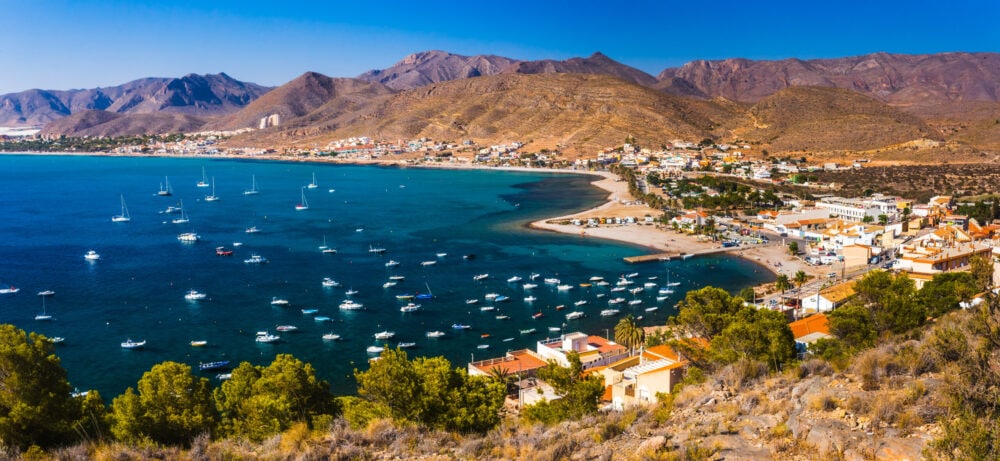
Visiting Cartagena Spain
From Roman history, a beautiful city centre with marble streets and art nouveau buildings, modernist architecture, amazing food and sites you won’t see in Andalucia , Barcelona or the rest of Spain . Cartagena Murcia is one of the fabulous hidden gems of Europe that you should make an effort to visit.
So I say add Cartagena to your list to discover in Spain and if you are wondering what the best things to do in Cartagena, Spain are this article outlines how we recommend spending one day in Cartagena as well as some tips if you have a longer stay in the city. Spain has many famous landmarks and Cartagena is very much off the beaten path but well worth a visit.
- Map of Cartagena, Murcia
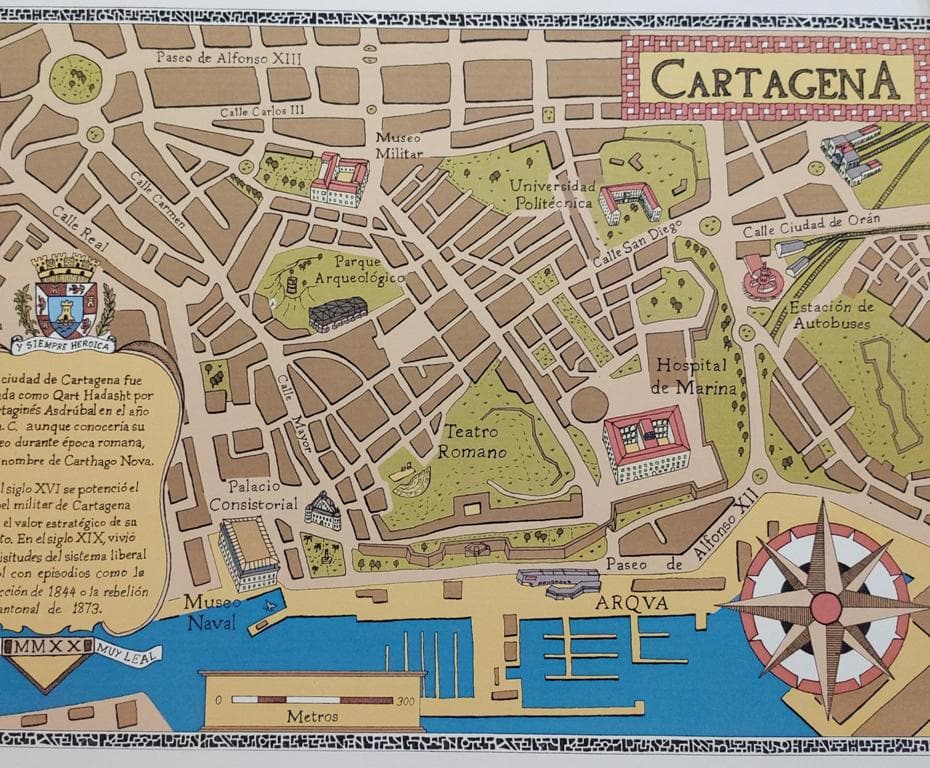
How to spend a fabulous holiday on the Costa Almeria
- Is Cartagena Spain worth visiting?
The answer to that question is an unqualified yes. There are so many things to do in Cartagena Spain from historic Roman and Carthaginian sites to feasts fit for foodies. There are marble streets and brilliant shopping. The heartstopping elevator to the top of the Castillo, boat rides and so many more activities.
- Cartagena Spain weather
Cartagena is located in the Region of Murcia, by the Mediterranean coast, in south-eastern Spain. Cartagena also has some of the best weather in Europe and is called the “winterless” city. Even in January, the temperatures hover around 57° F.
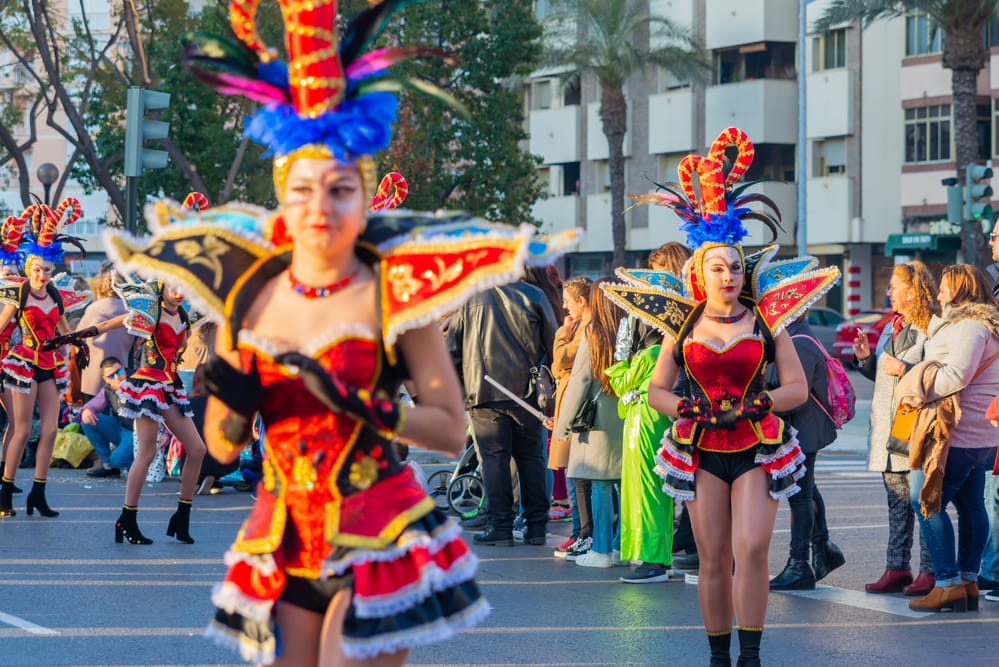
How to Get to Cartagena Spain
Port of cartagena, boat trips in cartagena spain, paseo de alfonso xiii.
- The Whale's Tail opposite the Naval Museum
Naval Museum, Cartagena, Spain
Arqua – museum of underwater archaeology, civil war refuge museum in cartagena spain, castillo de la concepción, roman theatre – roman forum museum, the molinete archeological park, augusteum of cartagena spain, the house of fortune , roman decumano maximum , centre for the interpretation of the punic rampart, museo historico militar de cartagena spain, the san josé´s ermitage, walking calle mayor, palacio consistoria, the gran hotel, casa cervantes, cala cortina, mercado de santa florentina, restaurants in cartagena – where to eat, hotels in cartagena spain, frequently asked questions – things to do in cartagena, what are the best things to do in cartagena, what are some of the top attractions in cartagena, how can i spend a day in cartagena, what are the main activities to enjoy in cartagena, how do i get to cartagena.
Xyuandbeyond is reader-supported. When you buy through links on our site, we may earn an affiliate commission . You can read my privacy policy here.
The biggest influx of tourists to Cartagena Spain comes from the massive cruise ships docked in the deep harbour. Cartagena port Murcia is an important cruise destination on Mediterranean itineraries . It is an easy city to get to though when touring Spain but if you are driving it is a rather “interesting” city to drive through not to mention the parking is awful.
However, having said that the traffic is restricted in Cartagena and there is underground parking but outside the main centre so it is a walk into the heart of the city. This does make the city very walkable and it is lovely without all that traffic to put up with.
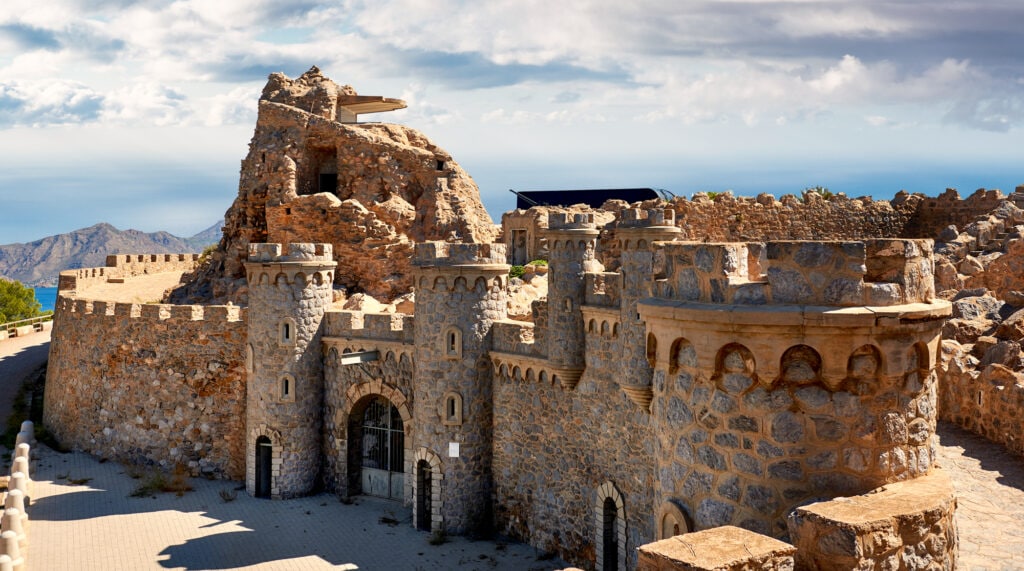
Cartagena is a stop along the way for most buses coming up from the south to the airport at Murcia or Alicante on Costa Blanca . Murcia San Javier airport is only 20km north of Cartagena. There are a few buses direct from Granada and Valencia and Alicante and if you want to add a road trip to your Alicante holiday on the Costa Blanca Cartagena is a fascinating place to visit
How to get from Murcia to Cartagena:
Bus: Take a direct bus from Murcia Central to Cartagena bus station(45min). Train: Take a direct train from Murcia del Carmen train station (50min).
How to get from Almeria to Cartagena:
Bus: Take a direct bus from Almeria main bus station(4h). Train: There are no train connections between Almeria and Cartagena.
How to get from Alicante to Cartagena:
Bus: Take a direct bus from Alicante main bus station(1:50h). Train: Take a direct train from Alicante-Termino train station (2:12h).
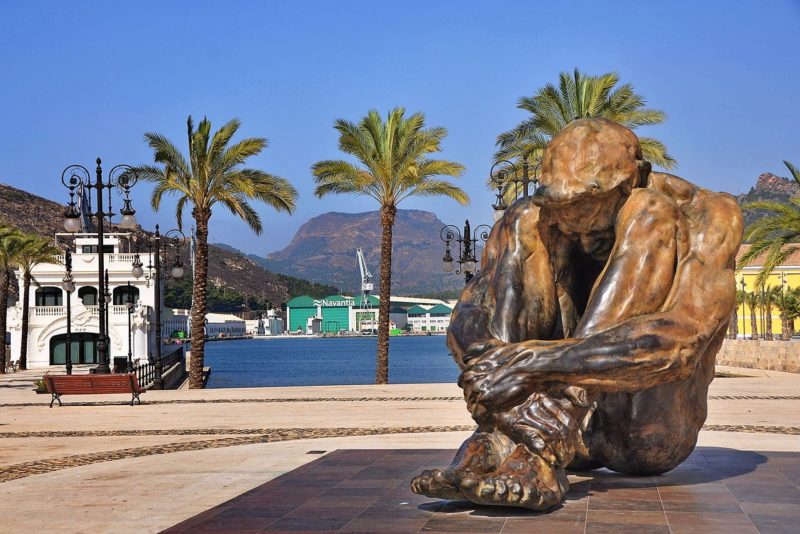
There is no direct bus from the airport to Cartagena Spain. The main Murcia-Cartagena highway, which is served by bus, is 3km away. Otherwise, a taxi will cost around €25.
You can book tickets online through Costasur the cost of a one-way ticket from Murcia to Cartagena is €4.75.
The Alhambra is on everyone’s bucket list here are some tips you need to know before you go
Best Things To Do In Cartagena Spain
The old town of Cartagena was constructed in 223 BC and was the great Hannibal’s capital city. Rich and full of character there is plenty to explore from Belle Epoque architecture to memorials of the Spanish Civil War and the Port has plenty to explore. If you arrive on a cruise ship then you do not need directions. If you are coming from the Roman Theatre or the Castillo simply keep heading south on Calle Mayor until you reach the port, it’s a nice easy walk.
Cartagena is one of the most important naval ports in Spain and has been the capital of the Spanish Navy’s Maritime Department since the arrival of the Spanish Bourbons in the 18th century.
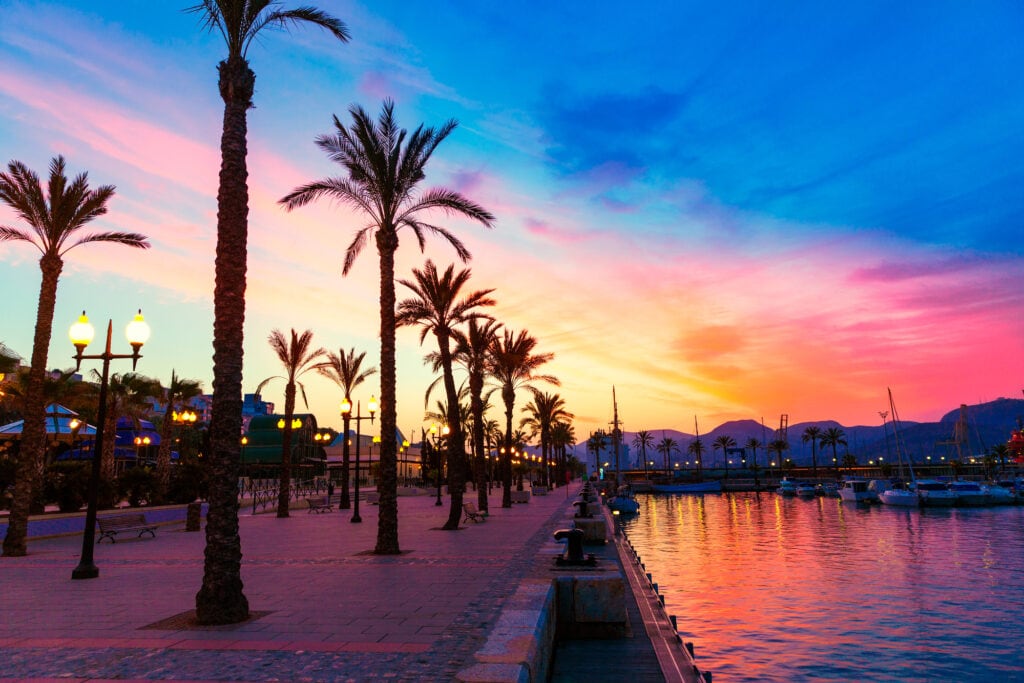
The perfect sunshine-filled holiday in Mojacer
There is a tourist boat tour of the harbour which takes around 40 minutes or so and takes you past some brilliant historic sites including the lighthouses, forts, castles and naval docks. The tours are conducted in both Spanish and English and the cost is around Tickets cost €5.75 or €8 if you also want to get off the boat and visit one of the forts.

The Tourist Boat leaves approximately every hour with reduced services during the low season. The ride lasts 40 minutes and takes you past several important historical sites including castles, forts, naval docks and lighthouses while also allowing you to enjoy nice views of Cartagena. There is commentary in both Spanish and English so you understand the significance of what you are seeing.
You can buy your tickets for the tour online here and it would probably be a good idea to do in advance as it can get very busy during the season.
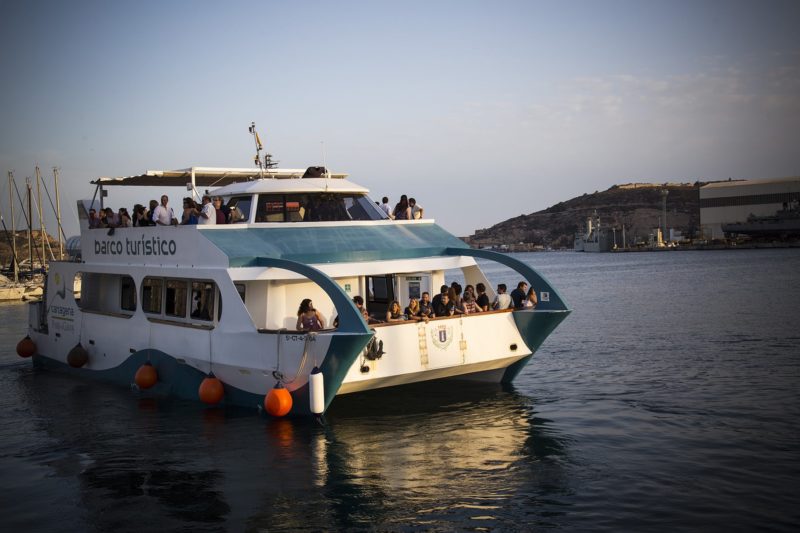
The port at Cartagena is quite nice compared to some of the ports cruise ships sail into. It’s a pretty area surrounded by hills and with some pretty damned expensive sailboats and cruisers on show. The cruise port overlooks the Mediterranean and contains mainly personal (read rich folks) pleasure boats. In fact, when we visited we had the chance to see the world’s most expensive yacht.
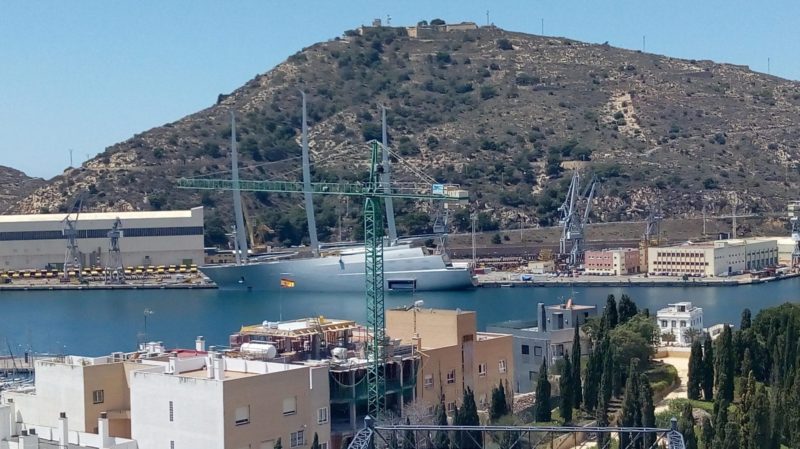
The Yacht which belongs to a Russian oligarch is undergoing a refit in the harbour. It is a £240 million priced superyacht and it has apparently been seized by harbour officials as the Russian has not paid his dock fees.
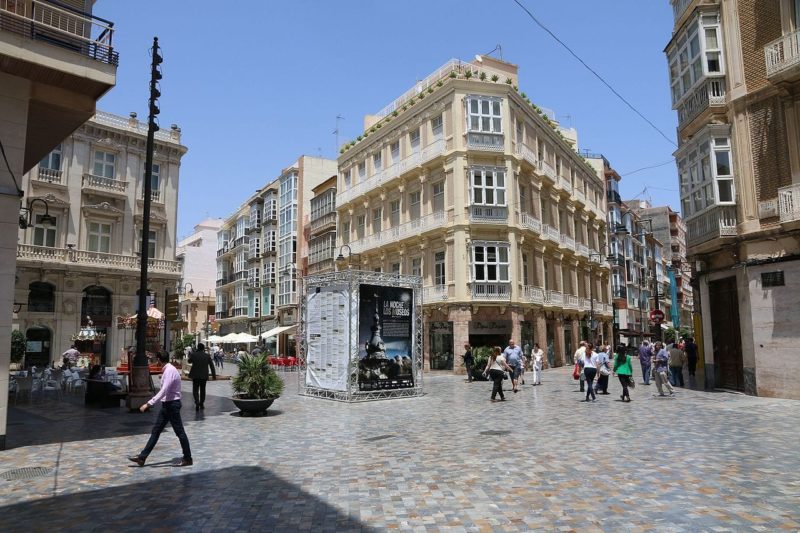
If you are on a cruise you will see a promenade when you disembark from the ship. The Paseo de Alfonso XII has a great array of bars and cafes on the terrace. It’s perfect for a walk from the ship and has some great views.
Things to see in the Cartagena Port
The whale’s tail opposite the naval museum.
If you visit the Naval Museum you will spot this sculpture of a whale tail close to the harbour. It honours the whales that navigate the waters of the Port throughout the seasons.
Situated within the port is the Naval Museum located in an 18th-century building that was a college for navy personnel who had joined the Spanish Navy until recently. The Museum highlights weapons, navigational tools and weapons and offers detailed accounts of the upheaval of the 1800s in Europe. Several revolutions, the loss of Spanish colonies and the heirs to the Spanish throne.
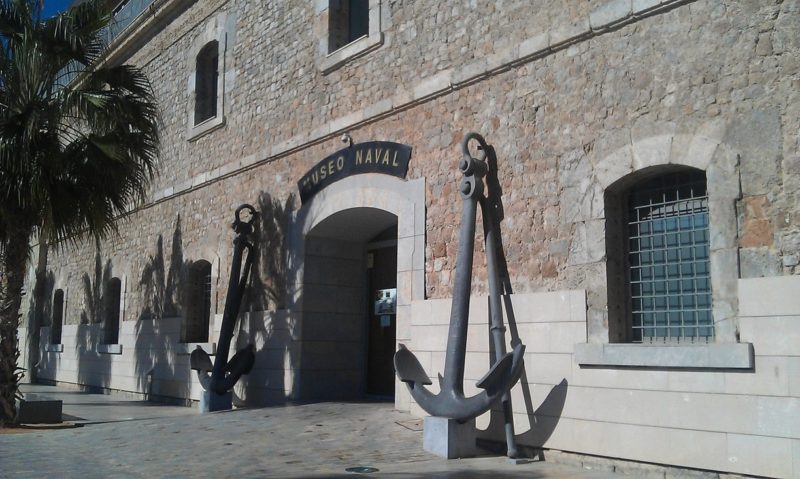
One of the most interesting sites is the Isaac Peral Submarine, the first battery-powered vessel launched in 1888. It was tested for 2 years but never fully developed.
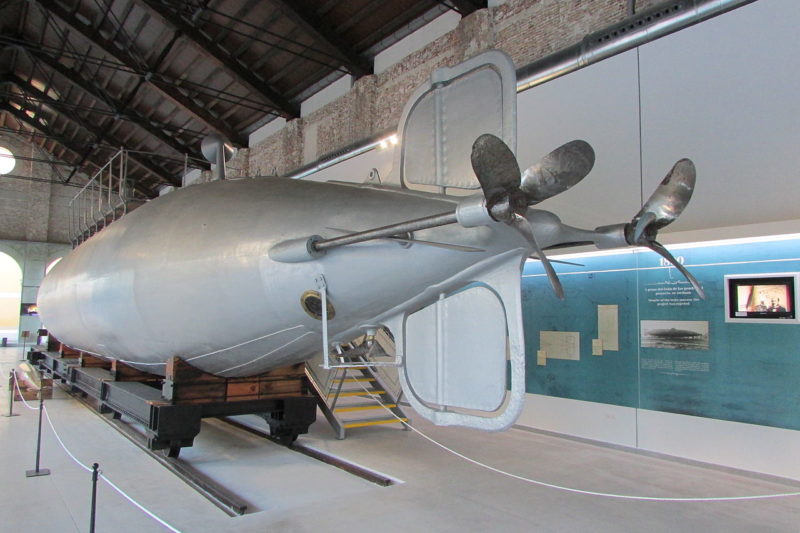
Arqua is the National Centre for Marine Archaeology and is located on the main paseo of the port Paseo Alfonso XII right next to the cruise ship terminal.
It contains some incredible historical artefacts and is also a research facility. Cartegena’s historical significance as the centre of the trade route linking Africa to the Middle East and the Mediterranean shows a treasure trove of antiquities in the Museum.
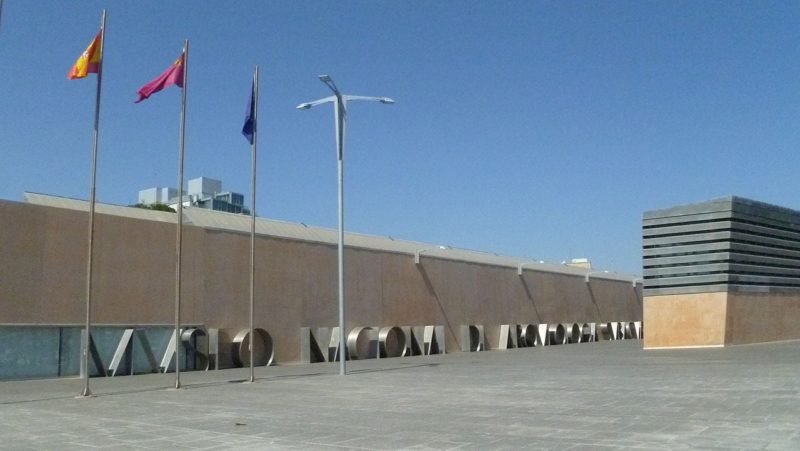
Phoenician vessels, Roman wrecks, the treasure of the Nuestra Señora de las Mercedes, a frigate that was sunk in the early 19th century with 14.5 tons of gold and silver coins. There are even laboratories where children can undertake archaeological research.
From Cartegena’s Port, it’s an easy walk down to the centre of the city. On Calle Gisbert, you will see a huge modern elevator that heralds the entrance to the Castillo and the Civil War Refuge Museum.
Cartagena was one of the most besieged cities during the Spanish Civil War. In 1878 a tunnel was opened on Gisbert Street that connected Conception Hill to the highest point of the city. This “tunnel” became an anti-aircraft shelter and in 2004 was converted into the Museum of the Civil War Giving tourists a glimpse into life in Spain during this period of time. Cartagena was one of the most besieged cities during the Spanish Civil War. In 1878 a tunnel was opened on Gisbert Street that connected Conception Hill to the highest point of the city. This “tunnel” became an anti-aircraft shelter and in 2004 was converted into the Museum of the Civil War Giving tourists a glimpse into life in Spain during this period of time. Found just over the road from the port, the square is full of palm trees and centres on the war memorial from the Spanish-American War. But around the plaza you’ll find some great Art Nouveau architecture, like that of the Palacio Consistorial de Cartagena.
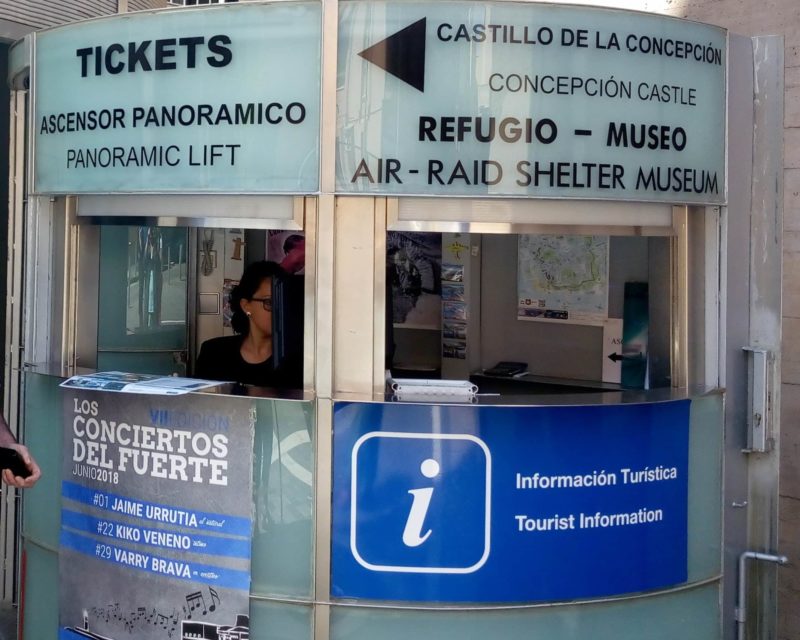
The Castillo dates back to Roman times when it was a Temple to Asklepio. Archaeological digs have discovered that the Castillo in Parque Torres was originally a Roman Temple and there are cisterns below the buildings that remain from that time.
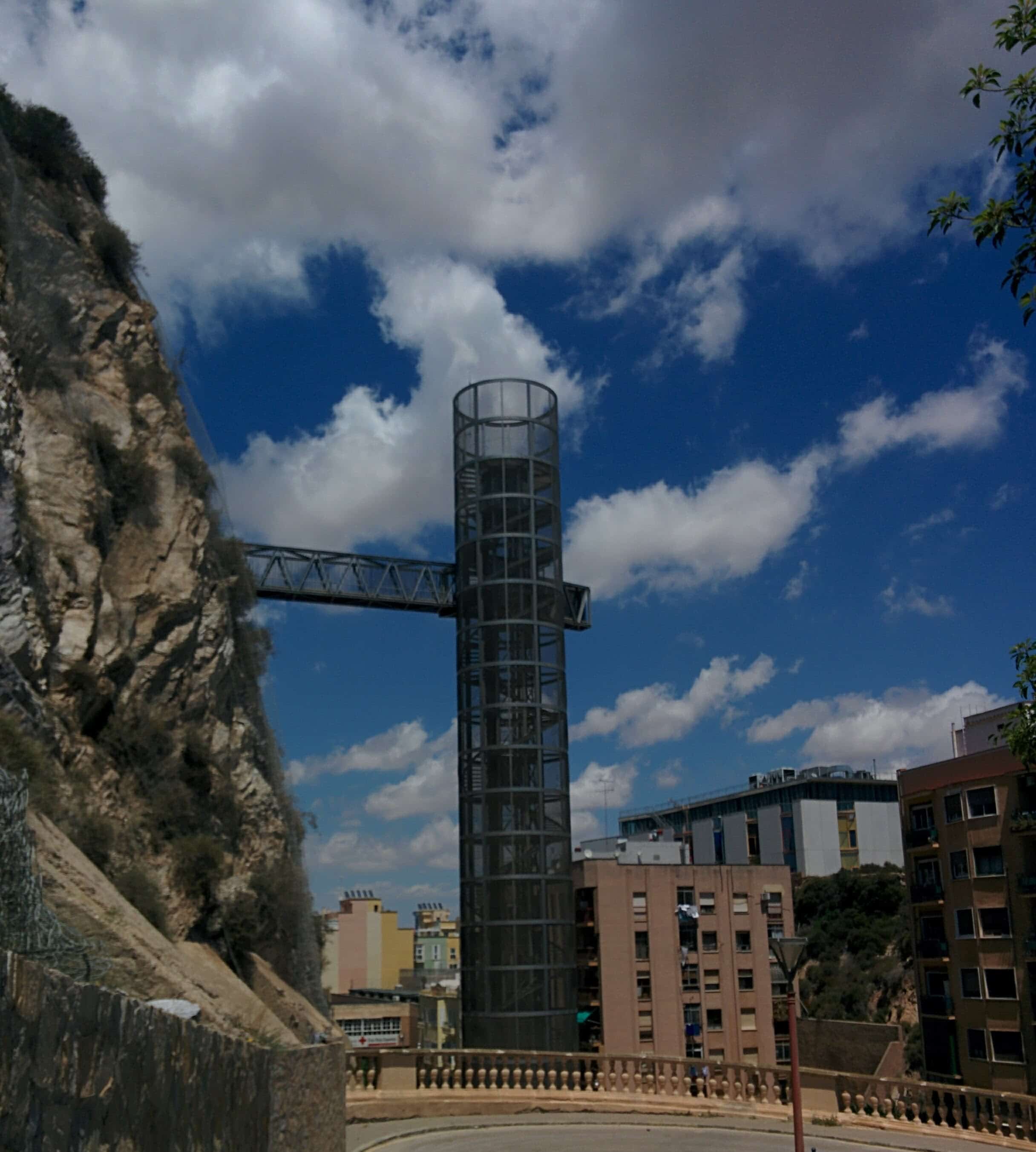
After the Romans, it was discovered that the Castillo was indeed an Alcazaba and occupied by the Moors of that time. Most of what remains within the architecture are from the 13th Century after the Christian reconquista.
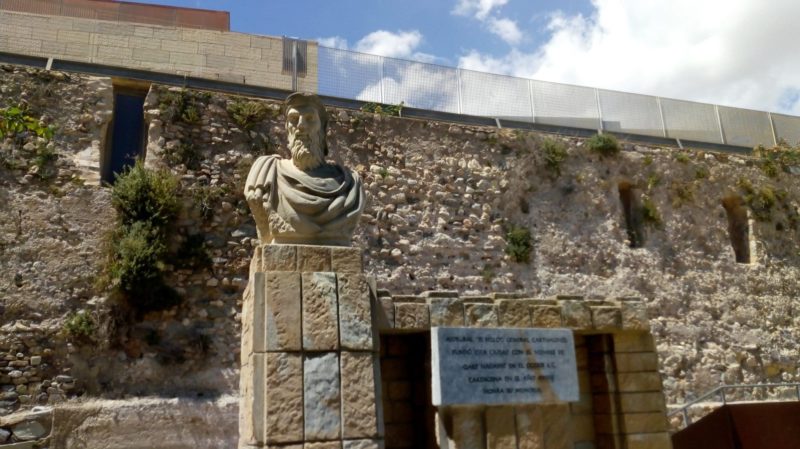
To get to the Castillo you can take the heart-pounding elevator or Panoramic Lift as it is called for €2, or you can take the 20-minute walk up the hill. You won’t regret either choice the views from the top are outstanding. You can see the Russian mega-yacht in the harbour and have views of the Roman theatre and much more.
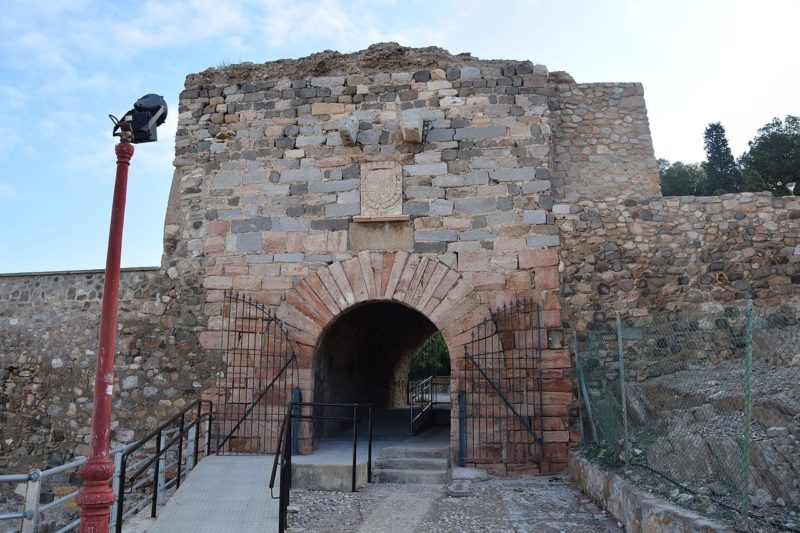
A ticket for the Castillo itself will cost €3.75. Once you have visited the Castillo and the grounds walk west down the hill and the path will go past the Roman Theatre.
If you are a castle fanatic (like me lol) you will love this article by Kevin about the 36 Best Castles in Spain. Kevin is a photographer and the photos are off the charts with fabulous information on these amazing Spanish Castles.
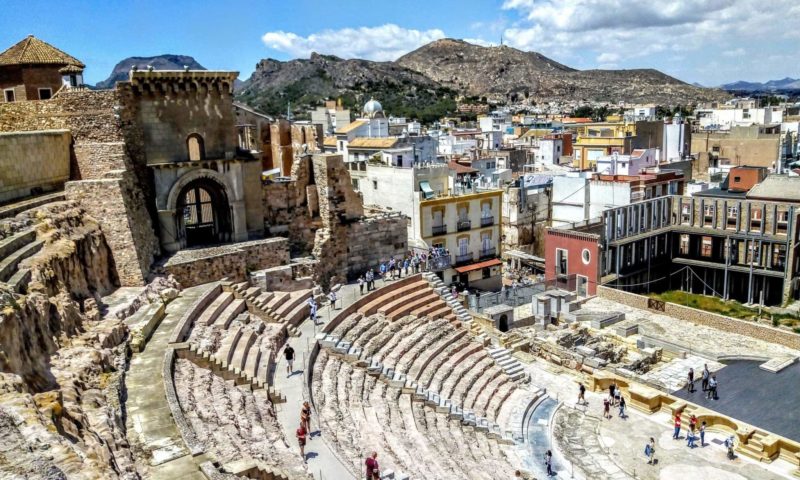
You can walk down the hill to the Roman Theatre or simply take the lift back down and walk over to it. This is one of the most historic places in Cartagena, Spain to visit.
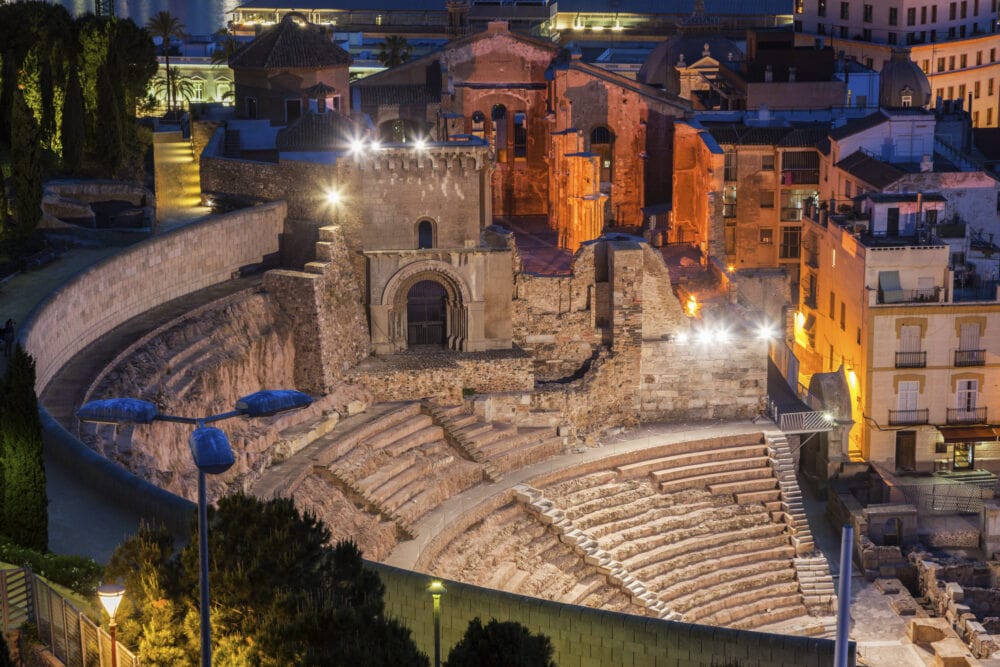
The Roman theatre in Cartegena was believed to have been built between 5 and 1 BC, and the builders dedicated the site to Gaius and Lucius Caesar who were the grandsons of Agustus and his successors to the Roman empire. After the fall of Rome in the 3rd century, a market was built over the theatre using the stones and bricks of the theatre. It is believed that the market was abandoned after a fire caused by a tribe of East Germans known as the Vandals. It became a market again in the 6th century when the Byzantines established a market quarter here.
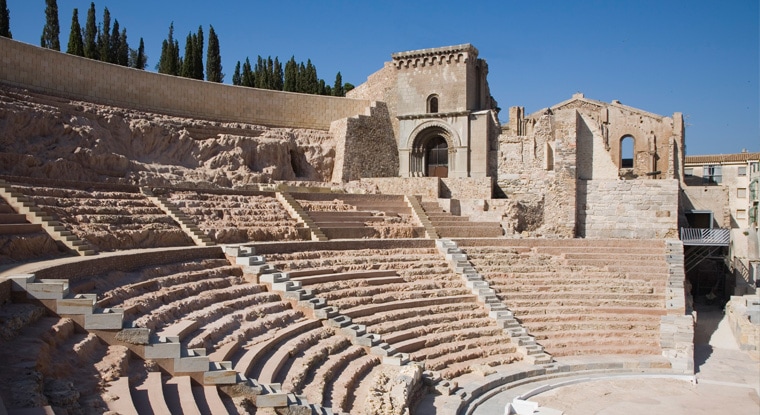
the theatre excavation in Cartagena Spain began in 1988 during the construction of the Centro regional de artesanía. There is a video presentation and then visitors are guided through the museum to see the artefacts found during the excavation. It was discovered beneath the ruins of the Old Cathedral, which had been destroyed during shelling in the Spanish Civil War.
The Roman Theatre is open daily except for Mondays and has shorter hours on Sundays. Tickets are €6 with discounts available for students and seniors.
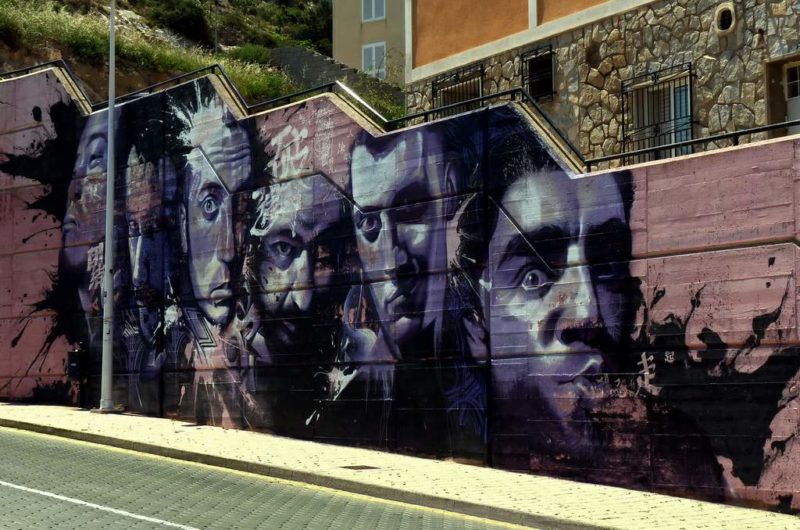
From the entrance on Calle Paraíso, you can roam across a hillside that includes relics of the Roman sanctuary, and take a closer look at the archaeological finds from the Roman Theatre. The archaeological park has a canopy over the skeleton of the thermal baths and the atrium, together with some outstanding mosaics. It opens from 10 am-7 pm daily except Tuesday.
There are several Roman ruins and sites in the city the archaeological site of El Molinete , the Morería Baja colonnade and the Byzantine Wall, which is also Roman. These are the Augusteum and the Decumanus. The Augusteum contains the remains of the old forum, whose importance as a public building can be seen from the amazing marble floors at the site. The second can be visited on the site adjoining the Roman Forum quarter which contains the different rooms in the city’s Roman baths. The Casa Fortuna, built in the first century B.C. and belonging to a wealthy family, shows what daily life was like at the time of the Roman Empire.
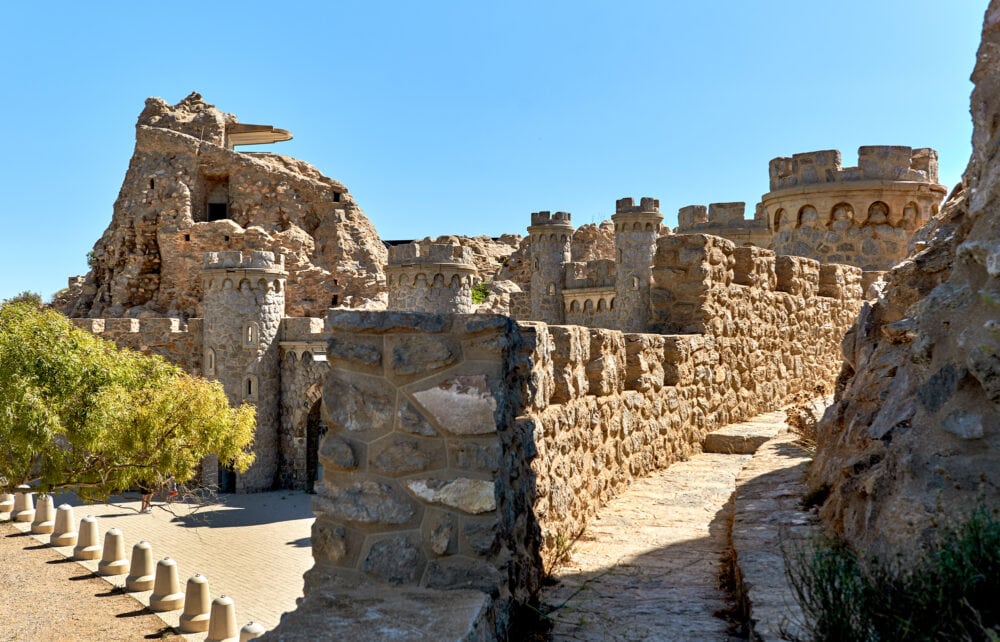
The Augusteum Museum of Cartagena is dedicated to the first Roman emperor Octavius Augustus. In the Augusteum you can learn about the rites performed by Roman priests in honour of Augustus. Within the Augusteum there is a statue of Augustus surrounded by marble sculptures.
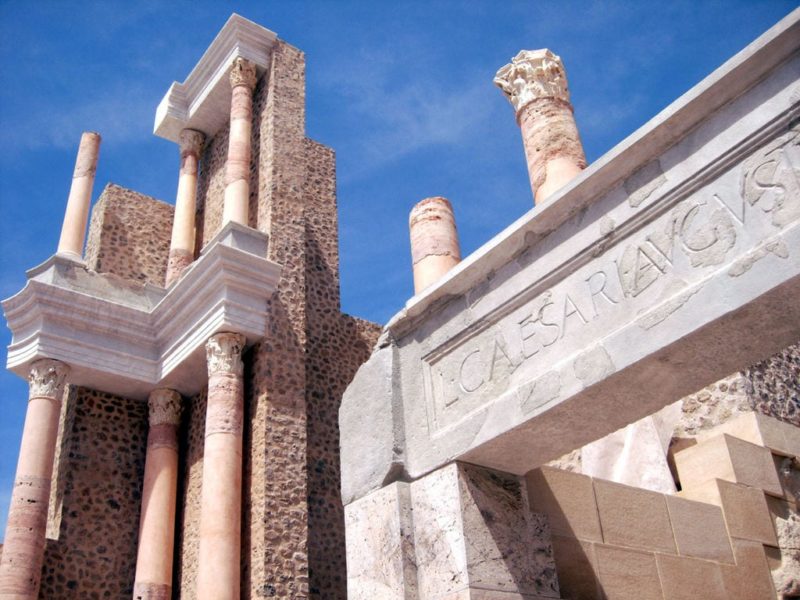
The House of Fortune was discovered in 2000 and is the home of a very rich Roman family. In the Museum you can see the triclinium or dining room, the tablinum or representation room where visitors were received and the bedrooms.
The House also has artefacts including lamps, personal items, dishes and amphoras. You will see beautiful mosaics and wall paintings that are simply stunning.
This stretch of road from the old Carthagonova, from east to west, links the Port with the forum, and it is one of Cartegena’s main historic sites. It is situated in the Plaza de los Tres Reyes. There are taverns and a main central sewage system. Roman baths with a “praefurnium”, which is an oven from which hot air for the baths came, a room paved in pink marble, three “hypocausts” and the “frigidarium” or cold water pool.
The Punic Rampart is the remains of a wall built in the 3rd century BC by the Carthaginians, and a 17th-century Crypt. The Rampart can be seen from the top of the Castillo. The Punic Wall stands on Monte Aletes, one of the five hills surrounding Cartagena.
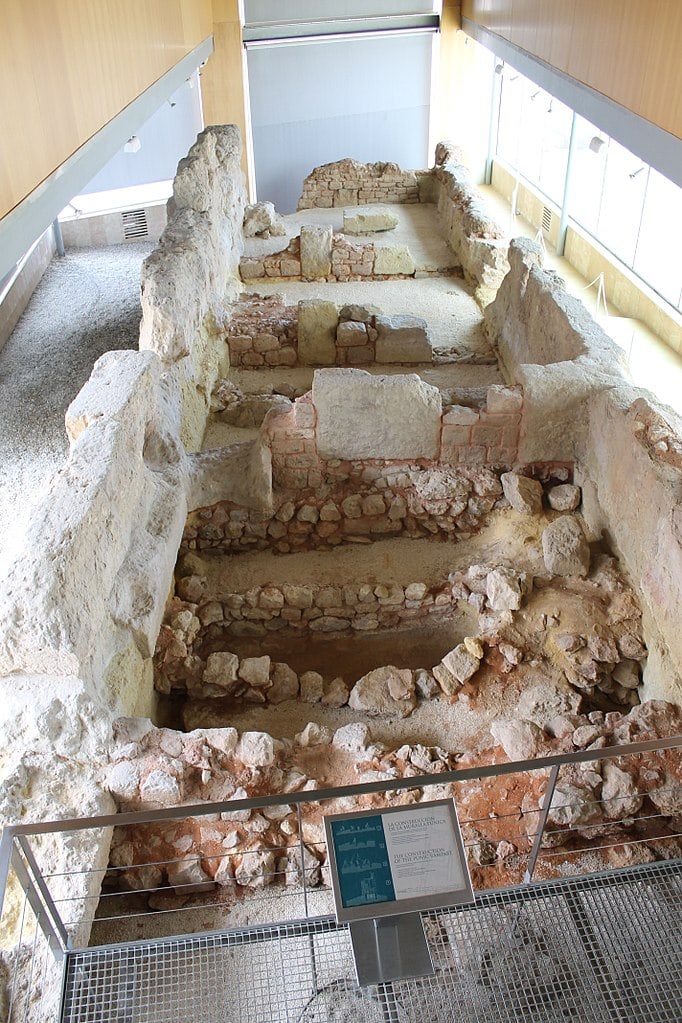
These remains were discovered in 1987 these were the walls that protected the city from attack by Moors and outsiders. It is one of the few remains of the Carthaginian civilization in Spain.
Cartagena has had a large military presence for thousands of years, and in modern times several Spanish army units have been based in the city.
You can see a great deal of this heritage in one place, and it’s an attraction that will blow your mind if you’re into military hardware.
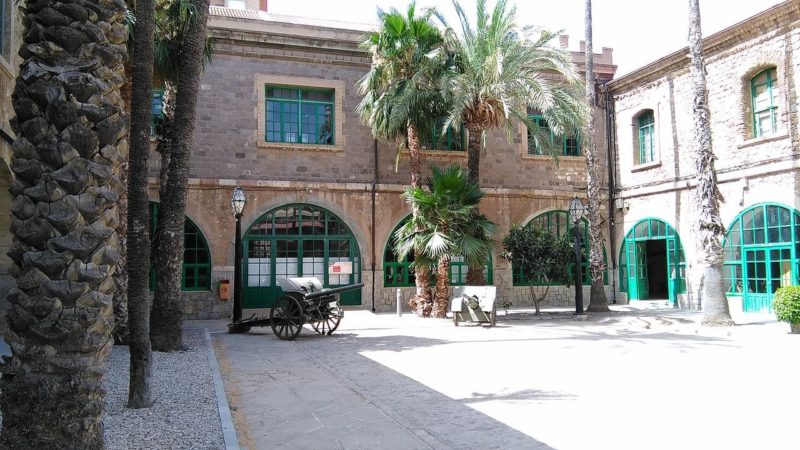
The museum building was constructed in the late 18th century and in the courtyard, you’ll spot an undetonated shell wedged in a wall from the insurrection in 1874. On show are tanks, missiles, field telescopes, light arms, several heavy-duty guns and all kinds of other military equipment.
The museum also has the largest collection of hand-made military models in the world, with a Guinness certificate to prove it!
This is believed to be the burial place of the Guild of St. Joseph. The walls and the crypt are relatively well preserved and they are quite small. The murals have as their theme “Dance with the Dead” and there are some skulls and bones left for visitors to see.
San José´s Hermitage is part of the funeral crypt is dedicated to San José and San Juan Nepomuceno. Several statues, carvings, stained glass windows and altarpieces were destroyed in an earthquake in 1829 soon after is was demolished and was supposed to be rebuilt but it never took place.
City of Cartagena
The main pedestrian street in Cartegena is Calle Mayor. A busy and vibrant area during the morning and evening it is a great place for people watching and checking out the Modernist architecture that stands in Cartagena.
Cartagena was the centre of the great mining industry in the late 1800s which made many residents very rich. The residue of this wealth can be seen in Cartagena’s historic centre. Due to a federalist revolution in 1874 that wiped out half of the city the centre needed rebuilding and it was done with great Modernist Style. There are some phenomenal art nouveau buildings including the Casino de Cartagena, The Palacio de Aguirre, the Gran Hotel, Palacio Pedreño, the Casa Cervantes.
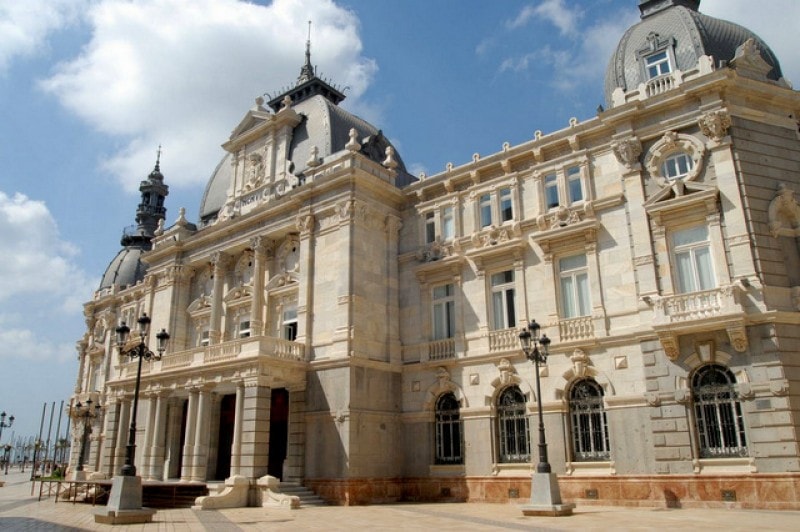
You can enter one of Cartagena’s most impressive modernist wonders, the 100-year-old town hall on In the Plaza del Ayuntamiento you can visit the Palacio Consistoria which was built during the mining boom of the late 19th century. A Belle Époque building was restored around 10-15 years ago. The facade is white marble and the domes are coated with zinc. If you get close enough you can spot some of the bullet holes from the civil war.
There are English-speaking guides who will explain the architectural and historical importance of the building and its contents.
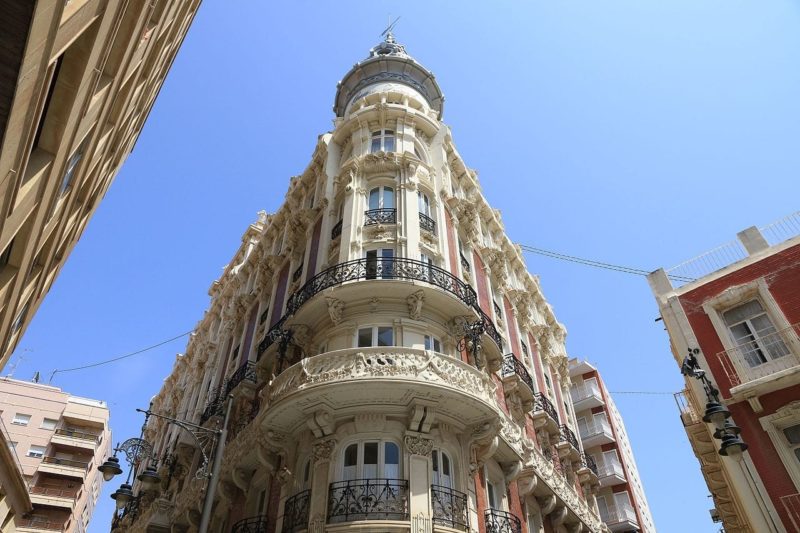
The Gran Hotel is considered the most representative work of modernism in Cartagena and was begun in 1907 but not finished until 1916. This luxury hotel continues to operate today with 70 rooms and 4 luxury suites.
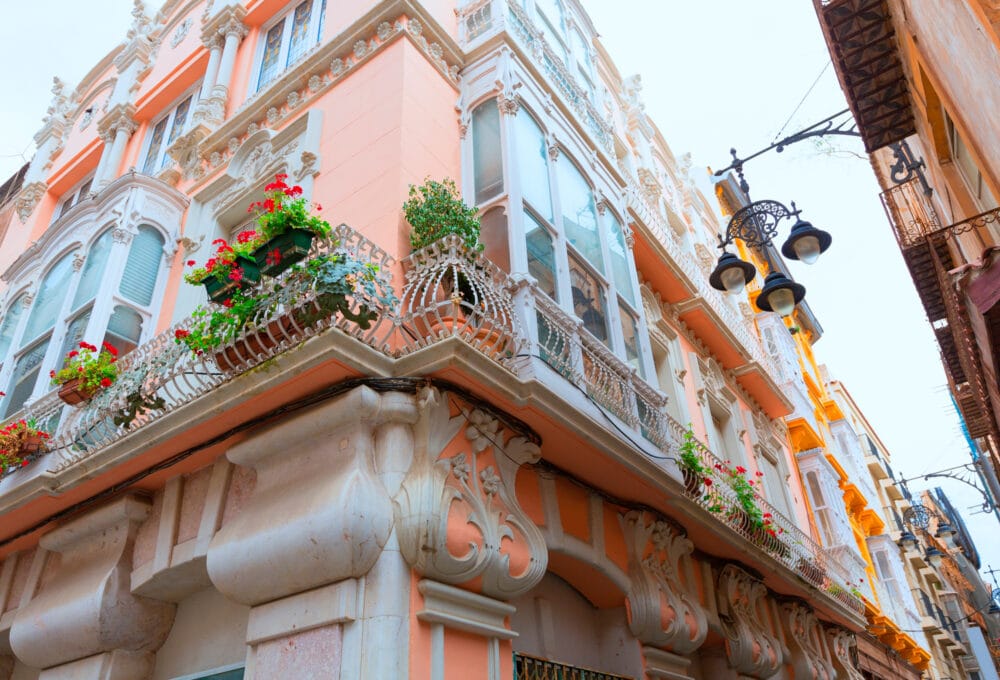
A thoroughly Modernist building Casa Cervantes is now a bank but only the facade remains.
Is there a beach in Cartagena Spain?
Best beaches Cartagena Spain ? Cartagena beaches are not as common as in other areas of the Mediterranean coast, but it does have a Beach.
Cala Cortina is in a sheltered bay between the deepwater commercial port and the city port, marina and cruise ship terminal. A very pretty beach that is almost a secret except to the Spanish who live in Cartagena. There is a restaurant, Mares Barvas which serves, workers from the deep commercial port, businessmen and people off the beach.
Cala Cortina is a Mediterranean coastal beach and is unusual in that it has protective netting, screening it off from the Mediterranean to create a safe swimming area that is protected from jellyfish.
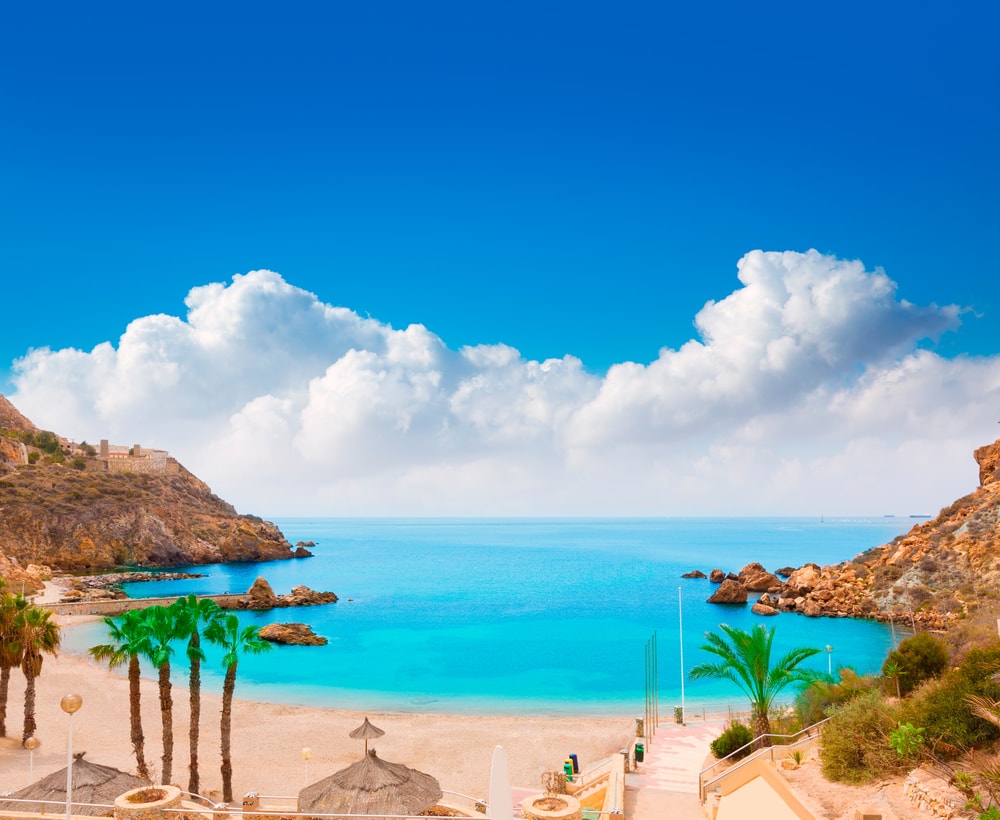
Cala Cortina is a man-made beach that was created in the 1980s. The beach consists of two bathing bays, the first one you come to is bigger and holds all the facilities you may need from restaurants to showers. The second is a little way along the coastal path and it is a protected bay perfect for children.
What to eat in Cartagena Spain and where
I will always visit the local market as the first stop on any trip. It is always the best place to get a feel for a city or village. In Cartagena, the local Mercado de Santa Florentina is the place to see.
The Murcia area is called Europe’s Orchard because it is dominated by farms, not only are there plentiful fruits and vegetables but Cartegena’s location near the sea provides a bounty of fresh seafood.
Spanish Food: 43 of the best foods in Spain
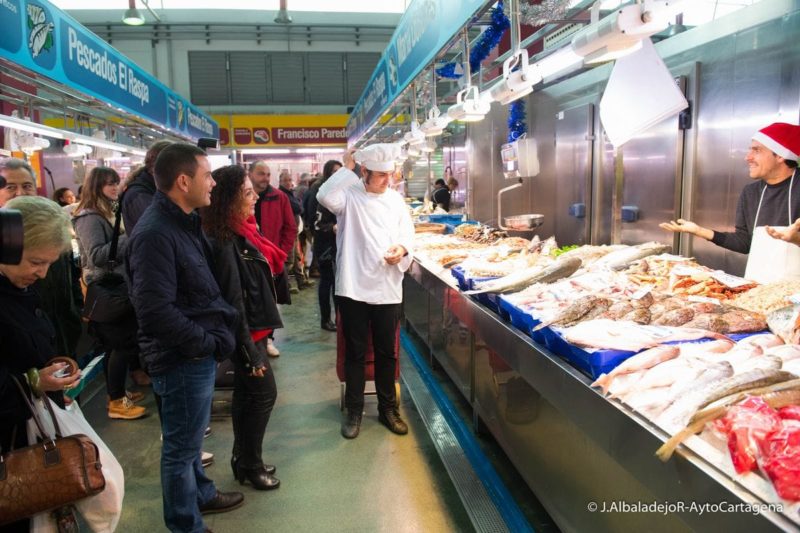
It is open every day but Sunday and hosts a superlative range of fresh produce, picture-perfect fruits, olives, fish meat, and Spanish Jamons and is a fabulous location to enjoy a coffee, people watch and have a snack. Don’t forget to pick up some of the famous Spanish Olive Oil at the market.
Tip: don’t forget the Spanish siesta period which takes place 12.15-5.15pm each afternoon so many places including restaurants will be closed.

Cartagena’s famous Cafe Asiatico
Cartagena is quite well known for a local speciality coffee called a Café Asiatico. Similar to Vietnamese coffee, this drink can only be found in Cartagena and some surrounding towns and villages in Murcia. It is made by mixing coffee, condensed milk, and cognac and topped with a local liquor known as Licor 43. Many cafes serve it along the main pedestrian streets of Cartagena.
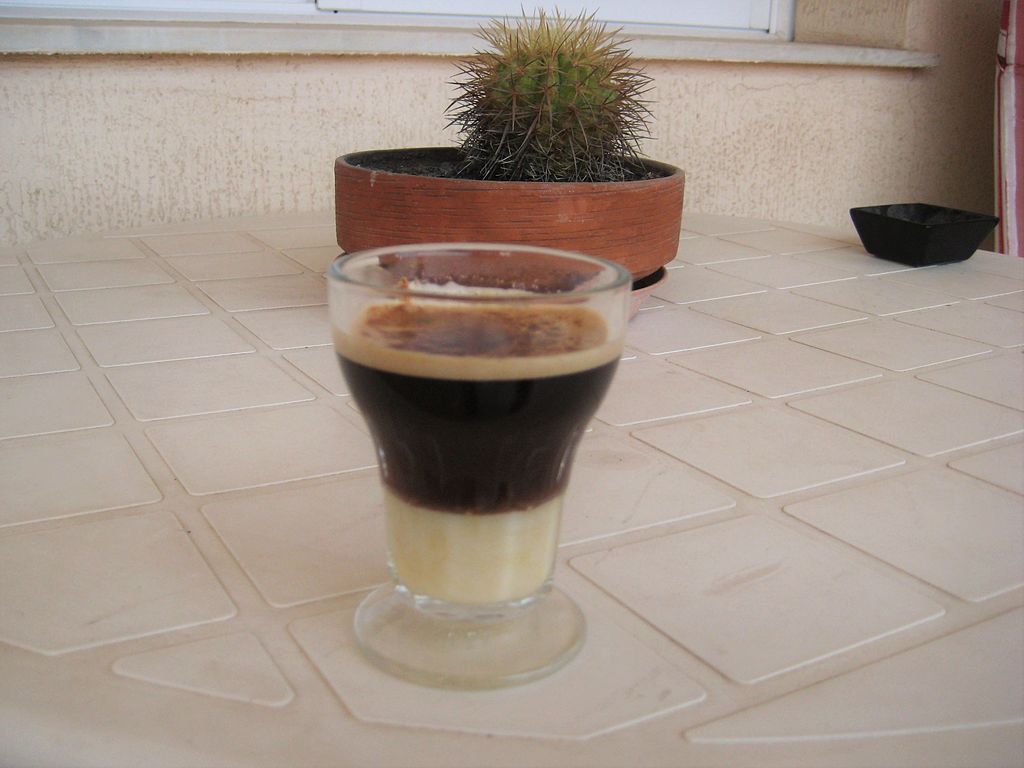
Licor 43 is a Spanish liqueur. Its 43 different ingredients include citrus and fruit juices, flavoured with vanilla and other aromatic herbs and spices.

I love the smell of fresh churros frying away, and then dipping these tasty fried treats into a cup of thick chocolate. The best place in Cartegena for churros is Churreria Tofi.

A local favourite it is to be found just north of the main centre on the corner of Calle Angel Bruna and Muralla de Tierra and it serves up Porras which are thicker churros as well as traditional churros con chocolate. Churros will set you back around €3.00
The food in Spain is outstanding and Cartagena has lots of very tempting and great value restaurants and cafes. Most of them have a menu del dia for €10-€12.
These are some locals favourites
The Cafetería El Molinete at Calle Balcones Azules has offered good-value seafood and meat dishes.
The Cibus gastrobar Plaza Jose Marias Artres has an €18 menu including gazpacho, bacalao (cod) and dessert.
Cerverceria La Mejillonera Calle Mayor is another local favourite great value tapa with a wide selection of choices.
In need of something more substantial? Check out Taberna A La Brasa which offers a €20 tasting menu that includes salad, paella, a mixed grill and a drink.
Or El Encuentro offers a range of paellas, and apparently the best steak in town
If you want to try a classic Murcian dish you need to find caldero which is the Murcian equivalent of a paella. This rice dish is very typical of the region and is usually presented in its own flat two-handled pan The rice should be cooked over an open wood fire and the fish is served separately with an aioli style sauce.
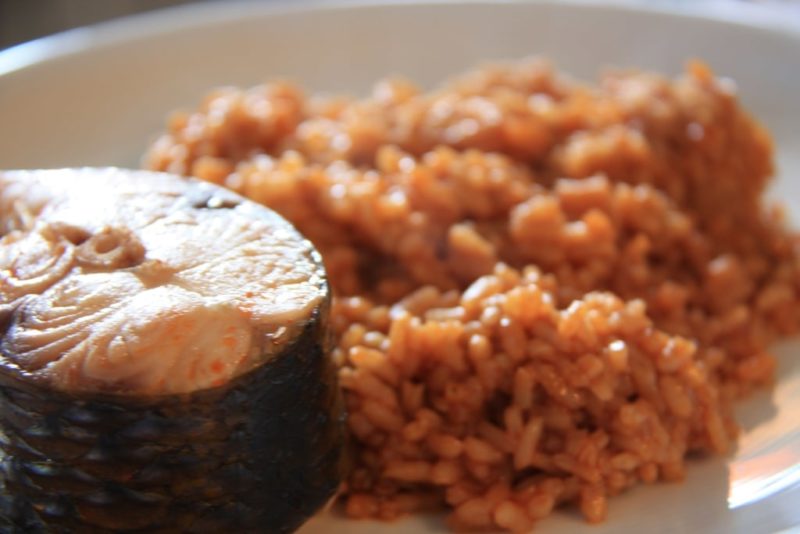
Casa Del Pescador on the Plaza de la Isla near the Marina is said to be an unobtrusive almost shabby little place but the locals love it for their caldero.
You simply can’t visit Cartagena or any place in Spain without enjoying some tapas. Cartagena is no different from any other area in the south of Spain and offers some amazing value tapa restaurants.
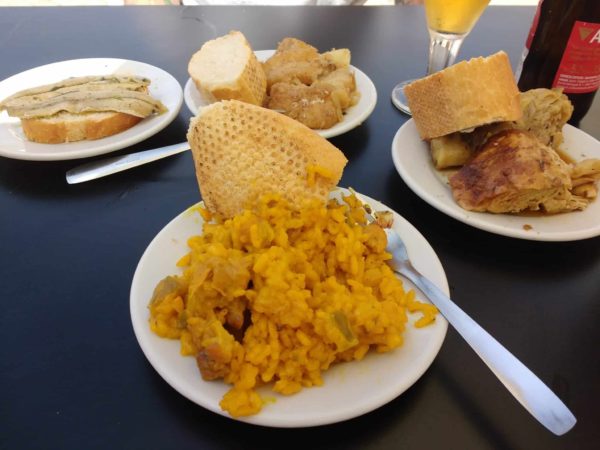
El Tranvia has two locations along Calle Mayor with plenty of outdoor seating. Enjoy some local wines with your free tapa – one tapa per glass of wine or beer. You can also choose from a full menu where you can order larger portions of the tapa you tried or a range of traditional southern Spanish dishes.
La Tapa – 13 Plaza Flores. Possibly one of the best tapas bars in Murcia! Try the caballitos (battered prawns – another local speciality) and come back later to get paparajote for dessert (don’t eat the leaves)!

Las Viandas – 2 Calle Pascual. A local favourite! The palitos de berenjena(aubergine sticks) come highly recommended.

La Uva Jumiliana is renowned for its patatas bravas a dish of diced potatoes with a spicy paprika sauce and cheap at €1.80 each. Locals also recommend the Pollo Kentucky tapa.
If you’re planning to spend the night in Cartagena or have a few extra days in the city, here are some recommended places to stay.
The NH Cartagena Plaza Héroes de Cavite . A first-class hotel with great ratings the hotel is in an old Naval building. The property brings boutique touches to an old naval building. The hotel is just a short walk from the port and 200 m from the Roman Theatre. It offers free Wi-Fi access throughout the hotel. The hotel is set in a quiet pedestrian area next to Cartagena Town Hall. Concepción Castle is also nearby. The beaches of Costa Calida are just 3 km away.
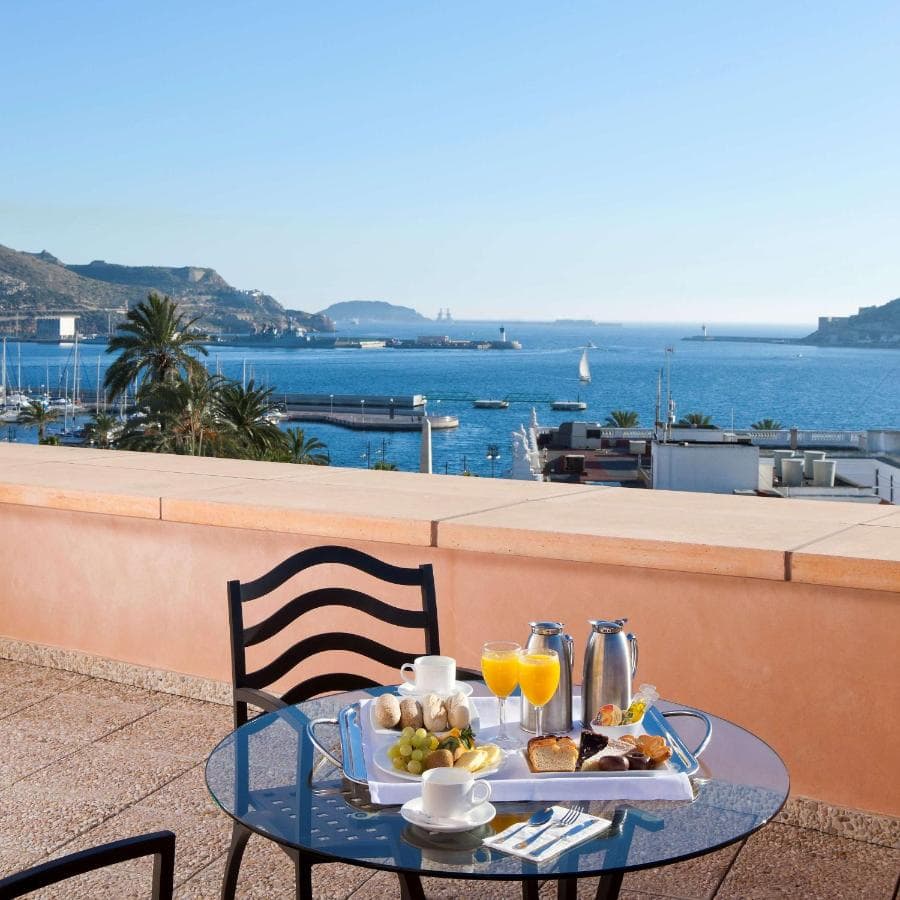
Hotel Los Habañeros Calle San Diego this is a budget hotel that is located close to the port bus and train stations and near the Roman Theatre and the Port of Cartagena. The rooms are clean and spacious with accommodating staff.
The hotel offers additional services such as free wifi, a bar, bicycle rental, paid parking and a meeting room.
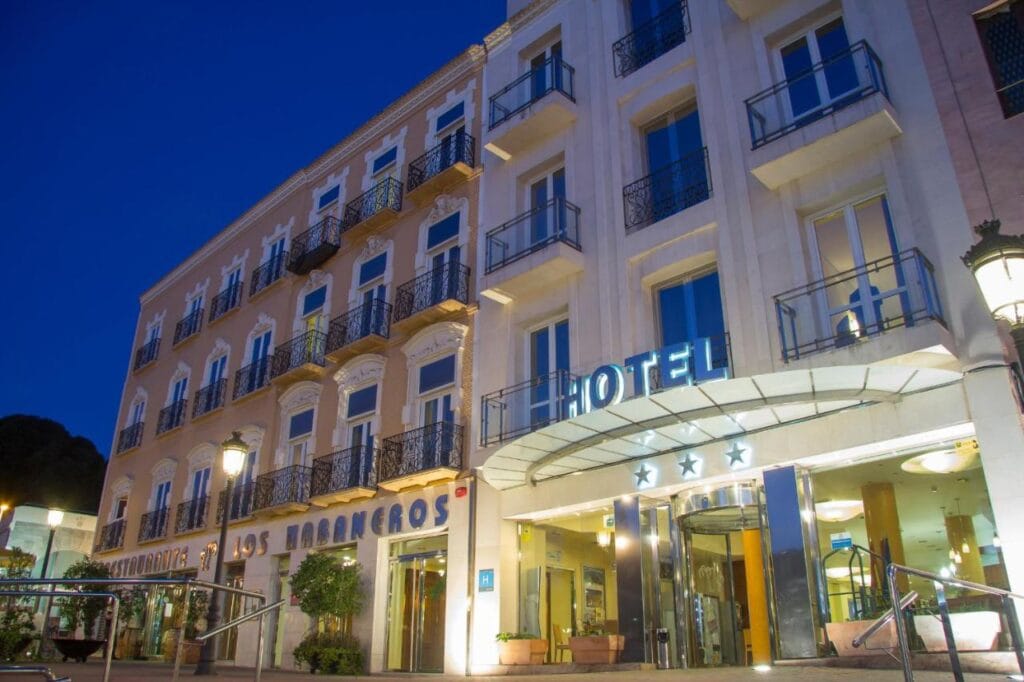
Pensión Balcones Azules is ideally located in the old city on the corner of Calle Balcones Azules and Calle Ignacio García. A basic clean and simple hotel.
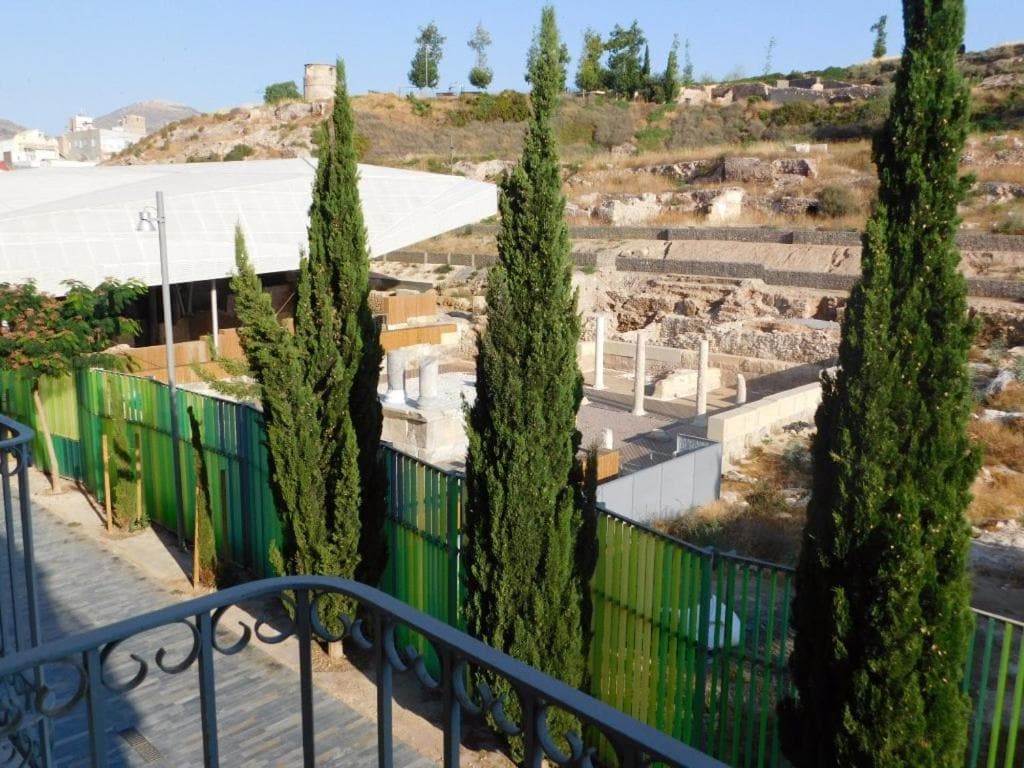
So as you can see Cartagena Spain and Cartagena Columbia are two very different cities and Cartagena Spain is well worth a visit.
When it comes to things to do in Cartagena and around the region, there is no shortage of activities to keep you busy. From exploring the Cerro del Molinete to visiting the Naval Base, there is so much to see and do in Cartagena. The city, known as Carthago Nova in ancient times, has a rich history that dates back to the Romans in the Second Punic War.
Today, visitors can explore the fortress at the Highest Point of Cartagena or take a stroll through the town hall square. For panoramic views of the city, be sure to visit Cerro del Mar. If you’re interested in the history of Cartagena, don’t miss the Collections of Artillery in Spain or learn about the Reconquest at the Heart of Cartagena.
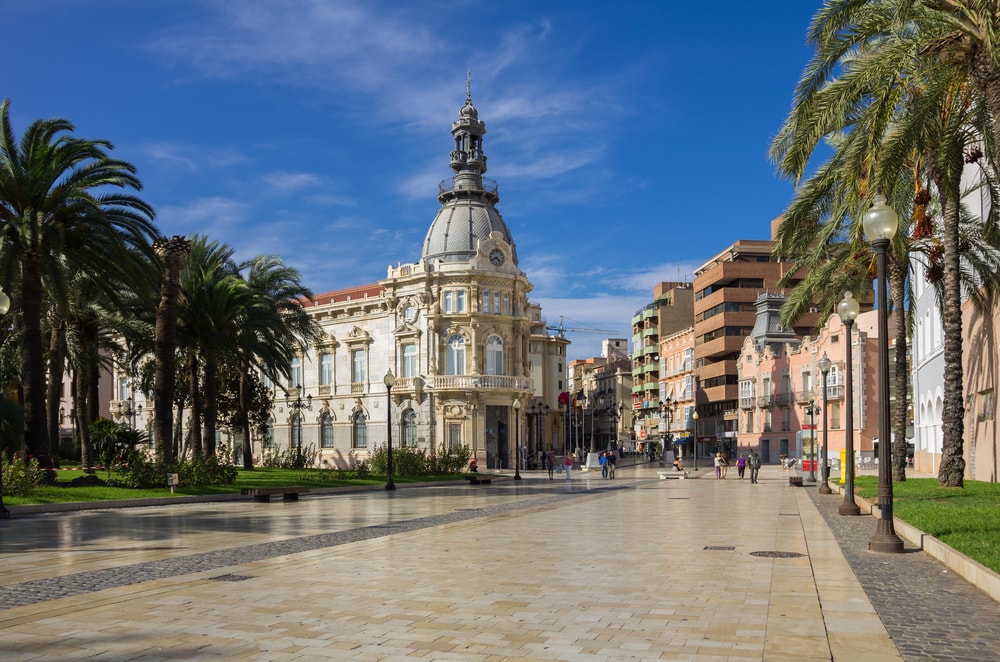
For those looking to explore beyond the city limits, Cartagena Tours offer excursions to the surrounding area, including the nearby beaches and countryside. When visiting Cartagena, make sure to stroll through the town hall square and immerse yourself in the history of the city. Don’t miss the opportunity to explore the highest point of Cartagena and marvel at the del Mar for a glimpse into the past. You can also take a tour of Cartagena by bus to see all the sights the city has to offer.
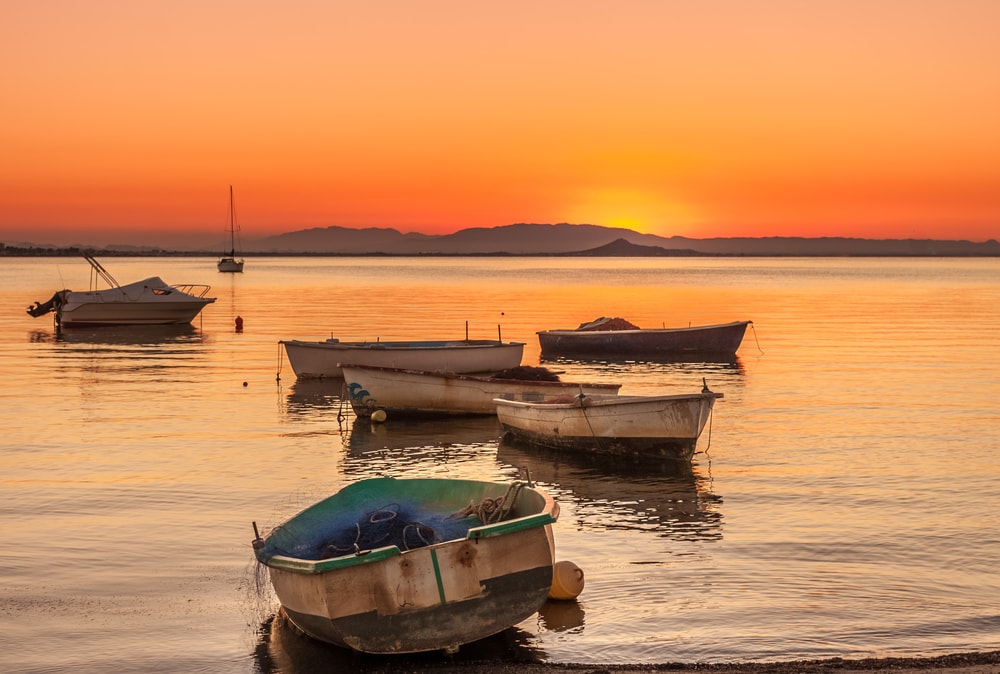
In Cartagena, you can explore a range of attractions, including the old town , the Naval Museum , Castillo de la Concepción , and the Archaeological Museum . Don’t miss the opportunity to visit the Roman Theatre and the Punic Wall for a glimpse into the city’s rich history and culture.
Some of the must-see attractions in Cartagena include the Roman Forum , Calle Mayor , Naval Museum , Castillo de la Concepción , and Molinete Hill . These sites offer a perfect blend of history and architectural beauty for visitors.
To make the most of your day in Cartagena, you can start by exploring the old town with its charming streets and historic buildings. Visit the Naval Museum and the Archaeological Museum , then head to Cala Cortina for some relaxation by the sea.
While in Cartagena, you can engage in activities such as exploring the underwater archaeology at the Museum of Underwater Archaeology, browsing art nouveau architecture, and learning about the city’s military history at the Military Museum.
Cartagena is easily accessible by various means of transportation. You can reach the city by car, train, or bus from major cities in the region of Murcia. If you prefer flying, the nearest airport is in Murcia, with connections to Cartagena.
If you want to explore much more of Spain but only have a couple of weeks here’s a Spanish Itinerary – Explore Spain in 12 days that will come in very helpful for you. And some more posts on Spain to enjoy.
Tips on what to see in Barcelona for 1 day
Ultimate Guide For Visiting the Alhambra Granada 2023
Gaudi in Barcelona – all his major works to visit
Ultimate Southern Spain Road Trip
Visiting Caravaca and attending the Wine and Horses Festival
What to experience in Salobrena in Granada Province
Visit the only inland desert in Europe – Tabernas Spain
Pin it for later
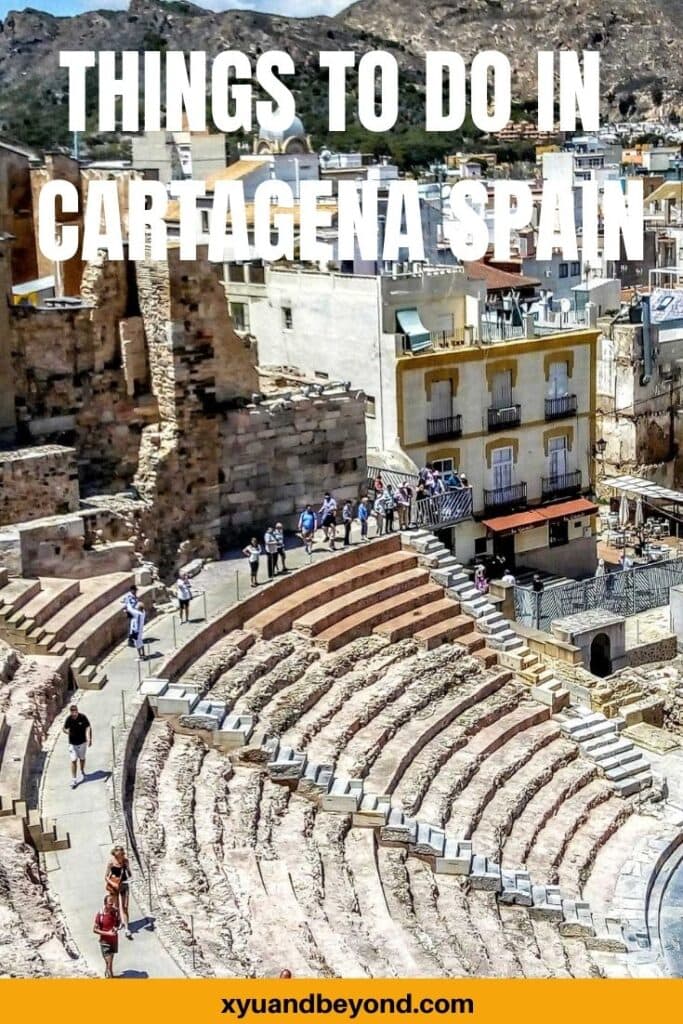
Faith was born in Ireland raised in Canada and has lived in over 10 countries in Europe including England, Ireland, Scotland, France, Spain, Northern Ireland, Wales, along with Mexico, Antigua, the US and has slow travelled to over 40 countries around the world. Graduating with a degree in Anthropology and Women's Studies Faith is a student of history, culture, community and food and has written about these topics for over 40 years.
View all posts
Visit Cartagena; a fascinating town in Spain

Visit Cartagena
Cartagena is in the province of Murcia in the region of Valencia and Murcia . Cartagena has been an important site for centuries due to its deep natural harbour.
Explore Cartagena
The old town of Cartagena is full of character. Constructed by the Carthaginians in 223BC it was Hannibal's capital city on the Iberian Peninsula. It was conquered by the Romans in 209BC.
The main archeological sites in Cartagena date from the Roman era and the key site is the Roman Theatre called the Carthago Nova. This has recently undergone a major renovation project and is an impressive monument. Building of the theatre began in the second century BC. Making the site even better are the attached ruins of the Santa Maria Cathedral, destroyed in Spain's Civil War.
Other Roman sights include the remains of an ampitheatre which was once incorporated into the bullring, a Roman street and ruins of a temple and a Bizantine wall. Visit the Museo Archeologico to view the Roman artifacts uncovered in the area.

Good views of the city can be seen from the ruins of the Castillo de la Concepcion. This castle was used by Carthaginians, Romans, Visigoths, Arabs and Castilians - all eager to defend this important port, which even today is Spain's main naval base.
Cartagena is undergoing something of a re-invention as a tourist town and a lot of money is being spent to this end. Walk through the harbour and along the sea walls. The impressive town hall is on the seafront and this area is full of bars and restaurants and you can enjoy your drink or meal whilst looking out over the harbour and the coastal forts.
Another good area for eating is in the old town at the Plaza del Ayuntamiento and Plaza Maria Jose Artes and the streets surrounding them.
Cartagena also has some fine Modernist architecture. Victor Beltri was one of the key architects in Cartagena and his works include Casa Cervantes and Casa Llagostera on Calle Major, the main shopping street. Also look out for the old Hotel Zapata on Plaza de Espana and the Casino, the Gran Hotel and the Railway Station.
Museums in Cartagena
The Navidad fortress built in the 19th century is in use now as a visitor centre for the 'Defensive Architecture of Cartagena and the Mediterranean'. This is closed to the public but the Naval Museum and National Museum for Underwater Archeology can be visited.
The Museo Archeologico has a collection of Roman artefacts and details of Cartagena's history.
Places to visit nearby
The Gulf of Mazarron south of Caragena is a scenic stretch of coast with lots of small coves and a backdrop of dunes and hills.
Orihuela is nearby and has a lovely old quarter and a Gothic cathedral with Renaissance cloisters. The charming port and seaside town of Aguilas is also nearby and worth visiting. Aguilas has a carnival which has been going for 200 years now and is included in Spain's official tourist calender (events of National tourist interest).
You can find more local travel ideas in the Valencia and Murcia guide .
Map of Cartagena and places to visit
Cartagena places to visit.

Puerto de Mazarron
Puerto de Mazarron is a pleasant beach resort on the Costa Calida which has miles of long sandy beaches protected by the Sierra de la Almenera mountains.

Orihuela is an attractive town with a restored old quarter and a wealth of historic buildings to admire.

A seaside town with an attractive port and a beach dominated by a 17th century castle.
...or see all our recommended places to visit in Valencia and Murcia
Select your language
Spain This Way - copyright 2009 - 2024
- privacy policy
- Skip to primary navigation
- Skip to main content
- Skip to primary sidebar
- Skip to footer
TravelAwaits
Our mission is to serve the 50+ traveler who's ready to cross a few items off their bucket list.
Why Cartagena Is One Of Spain’s Hidden Gems

Hakat / Shutterstock
- Activities and Interests
- Destinations
- Food and Drink
- History and Culture
- Outdoor Activities
- Ruins and Archaeology
- Sightseeing
After studying abroad in Seville and teaching English for one year in Madrid after graduation, I was pretty disappointed when I was assigned to teach in Cartagena the following year. I had never even heard of Cartagena, and it was located in Spain’s Region of Murcia, less glamorous and fast-paced than the world-renowned cities of Seville, Madrid, and Barcelona.
Despite being upset about my teaching placement, I did a quick Google search and thought the small port city looked nice enough. I was soon headed there to teach in Spain for a second consecutive year.
Looking back on my time in Cartagena, I feel terrible for ever having had those negative feelings. I quickly realized that I was fortunate to have been placed in one of Spain’s loveliest hidden gems. Cartagena was the pleasantest of surprises, and I’ll never forget its charm that captivated locals and visitors alike.
Cartagena was historically one of the most important defensive ports of the western Mediterranean. Despite this, and despite the recent spike in cruise ships making pit stops at the city’s famous port, the city remains practically unknown to tourists.
It shouldn’t be that way, though — Cartagena is a city teeming with rich traditional culture, outdoor adventures, ancient architecture, perfect weather, and stunning beaches. Here are some reasons why Cartagena is one of Spain’s best hidden gems.

NikKulch / Shutterstock
It Sits On The Mediterranean Sea
As part of the Iberian Peninsula, Spain has one of the longest coastlines along the Mediterranean Sea, stretching nearly 1,000 miles.
Cartagena is one of many Spanish cities located on the gorgeous Mediterranean coast, making it a perfect destination for a seaside getaway. Palm trees line its streets, and the city is home to numerous beaches.
A city located on the Mediterranean will inevitably offer some delicious seafood and provide some beautiful year-round weather (we’ll discuss that in detail later on).
You Can Get Free Tapas
Believe it or not, “free” tapas in Spain are harder to come by than many people believe. This often comes as a shock to travelers who expect complimentary tapas throughout their Spanish holiday.
While Granada is probably the last major Spanish city that offers an abundance of “free” tapas (I say “free” because you still have to order an alcoholic beverage in order to receive one), Cartagena is a diamond in the rough that still has a handful of free tapas bars — you just have to know where to look.
El Tranvía is located in the heart of Cartagena on Calle Mayor, with ample outdoor seating and friendly staff. Order a caña (small beer), doble (medium beer), tanque (the biggest beer), or tinto de verano (think refreshing, carbonated sangria), and you’ll receive a delicious, fresh, and free tapa!
If you’ve done your research on Spain, you probably know that the service industry there doesn’t function the same way it does in the United States. Servers don’t rely on tips, and eating out in Spain is a time to enjoy being with friends and family, not a time to rush to finish a meal.
When visiting El Tranvía, you might not be immediately acknowledged by your waiter, but don’t let this ruin your experience. Live like a local, sit back, relax, enjoy the weather, and people-watch while you’re waiting. When in Spain, do as the Spaniards do. ¡Olé! The Weather Is Perfect Year-Round
As I previously mentioned, Cartagena boasts a Mediterranean climate with perfect year-round weather. Don’t believe me? During my year in Cartagena, the temperature rarely went below 60 degrees or above 85 degrees, and it almost never rained. Could you ask for anything more perfect than that? I didn’t think so.
With such delightful weather, there’s never a bad time for a dip in the sea, a snorkel in one of the shore’s numerous coves, a nice dinner on an outdoor patio, or a stroll through the city center with an ice cream in hand.

Alex Tihonovs / Shutterstock
There Are Amazing Beaches And Coves
Some of Cartagena’s biggest draws are its beaches and coves.
Less than a 10-minute drive from the city center is Cala Cortina , one of Cartagena’s best beaches. This quaint cove beach features crystal clear waters, ample parking, a snack bar, warm white sand, and plenty of snorkeling opportunities. The picturesque spot is a local favorite, especially during the summer months.
Situated just 20 minutes east of Cartagena is Cabo de Palos , one of Spain’s most famous snorkeling destinations. Travelers can either drive or take the number 20 bus to Cabo de Palos from Cartagena’s main bus and train station. The 1,300-foot beach is home to secret coves and pristine waters, making it a popular snorkeling and diving spot in Spain.

lunamarina / Shutterstock
It’s Home To Incredible Hikes
Adjacent to Cartagena is Algameca Chica, a Hong Kong-style shanty fishing village that’s virtually unknown to tourists.
Near Algameca Chica is an abundance of stunning hiking areas along the Mediterranean with rugged cliffs and unparalleled views of the sea. Head south from Algameca Chica, and you’ll run into several fascinating hiking trails, including Cueva de la Cala, Cima Arco de la Amalia, Arco Amalia, and Reflector.

Philip Lange / Shutterstock
You Can Tour An Ancient Roman Theater
One of Cartagena’s most popular historic attractions, the Roman Theater was hidden beneath the city for centuries; it was rediscovered during excavations that began in 1988.
Believed to have been built between 5 and 1 B.C., the theater can seat 7,000 spectators and is divided into three horizontal sections. A semicircular space in front of the stage once served as an orchestra — and still does! Performances are held in the ancient arena today.
Visitors can wander through the theater and adjacent museum at no charge. Audio guides are available in English, French, and Spanish.

Primochep / Shutterstock
There Are Free-Roaming Peacocks
If you continue uphill from the Roman Theater on either Calle Concepción or Plaza Puerta de la Villa, you’ll reach another popular attraction in Cartagena, Castillo de la Concepción . Located within Torres Park, this green space offers incredible panoramic views of the city.
The views aren’t the only spectacular feature of the park, however. An abundance of wild peacocks roam freely about the park, an unexpected yet delightful sight that only heightens the area’s picturesque qualities.

It Has Its Very Own Liqueur (And Its Very Own Specialty Coffee Drink)
Spain’s top-selling liqueur, Licor 43, is a sweet, vanilla-flavored liqueur that allegedly dates to 200 B.C. — and it’s only made in Cartagena.
Produced by the Diego Zamora family and company, the drink gets its name from the fact that it’s made from 43 different ingredients.
In Cartagena, the most popular way to drink Licor 43 is by ordering an Asiático , a shot of coffee with condensed milk, Licor 43, hot milk, and a hint of cinnamon.
In Cartagena, you can even take a Licor 43 tour , a 2-hour experience that highlights the flavors, history, and culture of Licor 43.
There Is A Beatles-Themed Bar
As a diehard Beatles fan with a John Lennon tattoo, I might be overly excited about this discovery, but Cartagena is home to a Beatles-themed bar and restaurant fittingly named Yellow Submarine .
While the restaurant caters to tourists and is mostly Western-inspired, the quirky Beatles bar offers a wide selection of international beers, including some that are quite hard to come by, such as the famous Belgian beer Delirium Tremens. Inside, the bar is decked out in Beatles memorabilia from floor to ceiling, a sight that any Beatles fanatic will love.
With ample outdoor seating, Yellow Submarine is a great place to kick back and relax, enjoy a cold cerveza , and bask in the warm Mediterranean sun.

alexilena / Shutterstock
It Makes A Great Road-Trip Stop
Not only does Cartagena lie on the Mediterranean Sea and have perfect year-round weather, but it also serves as a great road-trip stopping point.
If you’re renting a car and driving through Spain, you should know that Cartagena is centrally located between several major Spanish cities; it’s only a 3- to 6-hour drive from Barcelona , Madrid , Granada, Seville , Málaga, and Valencia.
Many travelers decide to stop in Cartagena for one or two days, and since the city is rather small, it makes a perfect halfway point.

Kurbanov Vener / Shutterstock
It Hasn’t Been Discovered By Tourists… Yet
When I tell people that I lived in Cartagena for one year, their reaction is usually, “Oh, you lived in Colombia?”
Not many people are aware that there is another fabulous Cartagena in Spain!
What I love most about the city is its pure authenticity. Unlike many bigger Spanish cities, it’s managed to avoid becoming a tourist trap and provides a unique experience that is difficult to find in the more-visited areas of Spain.
While this lovely port town is becoming a more popular stop for cruise ships, it still upholds its vital and rich Spanish culture, something you won’t find in Madrid or Barcelona.

Alexandra was first bitten by the travel bug when she studied abroad in Seville, Spain, in 2013. Since then, she graduated from Indiana University with a bachelor of arts in journalism and a double minor in Spanish and music. After graduation, she taught English abroad for four years in Spain and Thailand. Besides being a contributing writer for TravelAwaits, Alexandra has turned her passion for travel into a career as an expedition manager at National Geographic Expeditions, overseeing trips throughout Southeast Asia, Europe, and Africa.
Visit Cartagena, Spain, in September for ancient battle reenactments and costumed revelry
Aug 18, 2023 • 6 min read
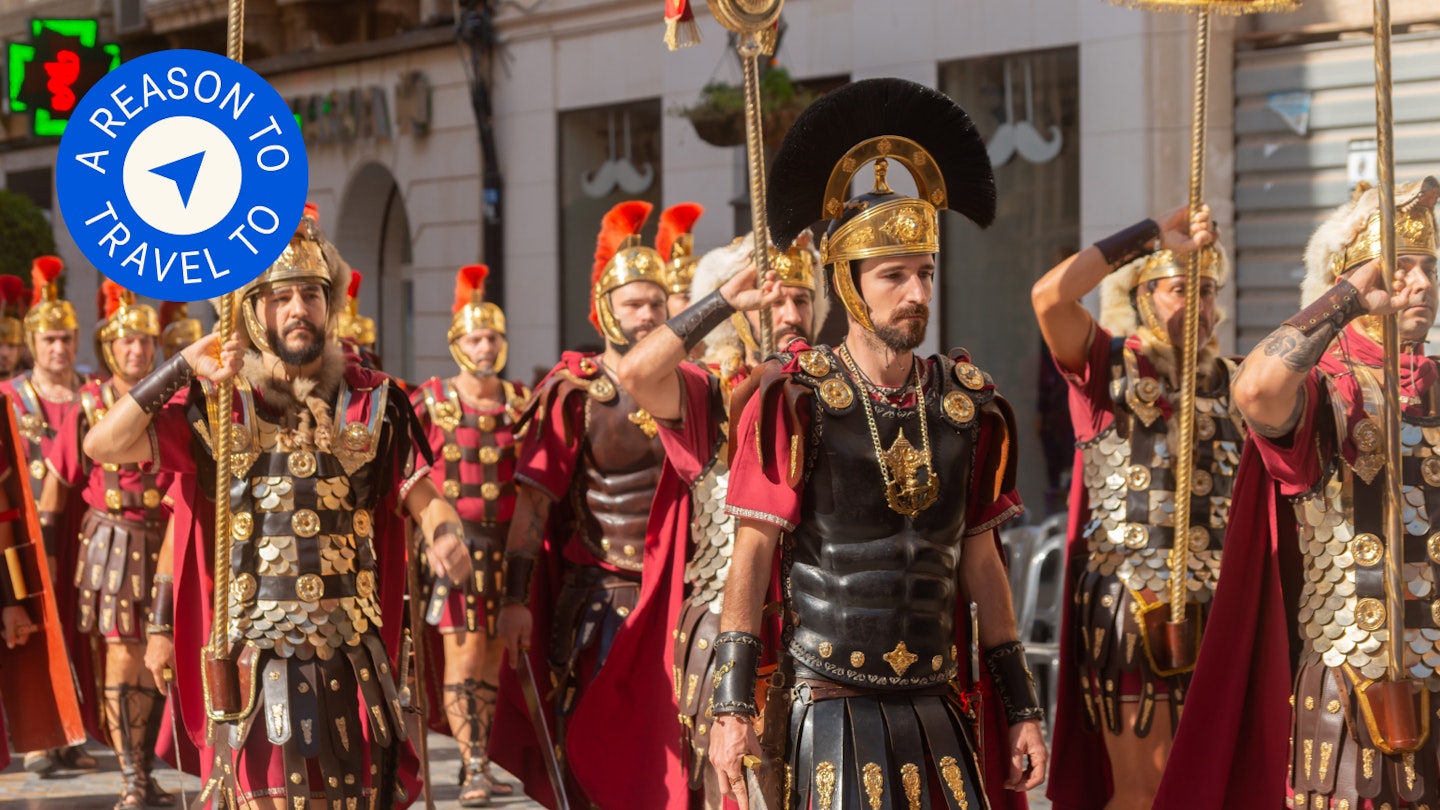
Each September, the Fiestas de Carthagineses y Romanos bring historical reenactments and festive parties to the city of Cartagena, Spain © Q77photo / Shutterstock
The slope of the Batel, by Muralla de Carlos III, is a sea of blue and red tunics as the Carthaginian and Roman armies face off against one another.
The first group of fighters – armed with spears, their faces fearsome painted masks of blue and white – let out a tremendous roar, their archer women ready to let loose a cloud of arrows. The red-cloaked Romans stand impassively in formation, their crested helmets glinting in the sun, waiting for General Scipio to give the Spanish equivalent of the order, “On my signal, unleash hell!”
The audience watches, rapt, as the hillside becomes a melee of swords clashing against shields, the air thick with war cries, until the outnumbered Carthaginians are finally defeated. The Roman troops march in triumph to the Festival Camp, whose name is then changed from Qart-Hadasht to Carthago Nova to mark their victory.
The festival is in full swing.
The reenactment of the Battle for Qart-Hadasht from the Second Punic War (218–208 BCE) is one of the highlights of the Fiestas de Carthagineses y Romanos (Festival of Carthaginians and Romans) that take place in Cartagena , Murcia , in the second half of September. The festivities put the Spanish city in full party mode, as it celebrates its historic roots.
The second-oldest settlement on the Iberian Peninsula, the port of Qart-Hadasht was founded by the Carthaginians in 223 BCE. Yet the Carthaginians only managed to hold on to it for 18 years: when the legendary Carthaginian commander-in-chief Hannibal set off to march across the Alps toward Rome , elephants and troops in tow, the Roman general Scipio took advantage of his absence and attacked the city from the sea in 209 BCE, scoring a surprise win. Every year, the clash is reenacted – minus the elephants.
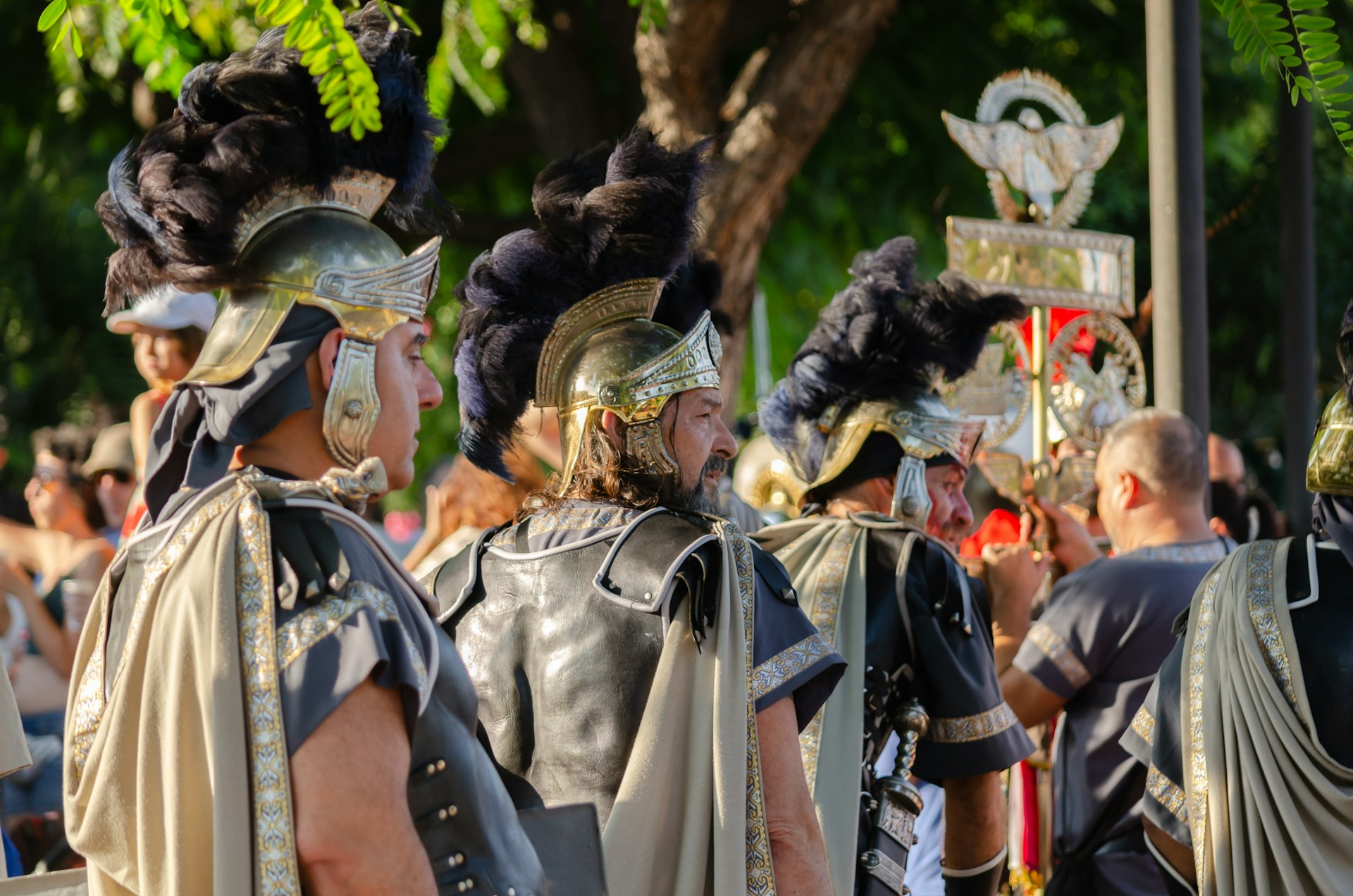
The festival is a wonderful time to experience Cartagena, when its dense concentration of historic sites come to life. Most of all, it’s a riveting spectacle, with hundreds of Roman and Carthaginian troops in full battle gear parading past the fashion boutiques, bars and beautiful art nouveau buildings along Calle Mayor; fun historical reenactments; and plenty of non-historical audience participation in games and contests at the Festival Camp next to the Estadio Cartagonova (home to FC Cartagena).
Attendance doesn’t require much advance planning, since most events are free (while there are charges for seats at some events, you can always stand for free). The festival kicks off on the third Friday in September with the Arrival of the Sacred Fire by boat, which is then lit on by a Roman priestess on the Cerro del Molinete, one of Cartagena’s five hills.
If you can’t come for the full 10 days, memorable events take place over the course of the festival. On Monday, the wedding of Carthaginian general Hannibal and Iberian princess Himilce is celebrated with gusto at the Festival Camp. Revelers can also choose to “get married” in a Carthaginian or Celtic wedding. The Carthaginian and Roman streets of the Festival Camp host competitions and games for children on Wednesday; at night, the Roman part of the camp parties late into the night during the Feriae Latino. Thursday sees the Carthaginian armada disembark at the port and the Carthaginian troops parade towards the Festival Camp, marking Hannibal’s march on Rome.
The festival saves the best for last: on the second Friday, the (non-historical) rowing race in the harbor between Carthaginians and Romans is followed by the arrival of the Roman Armada and the epic Battle for Qart-Hadasht. The second Saturday is your only chance to see the Romans and Carthaginians march together in their battle finery, while the final day – the second Sunday – is dedicated to the Great Roman Circus (the only event for which you need advance tickets), with chariot races and gladiatorial fights held in a portable bullring. Afterward, the Victory of Rome is staged, the priests and priestesses extinguish the Sacred Fire, and a grand fireworks display over the harbor signals the end of the festival.
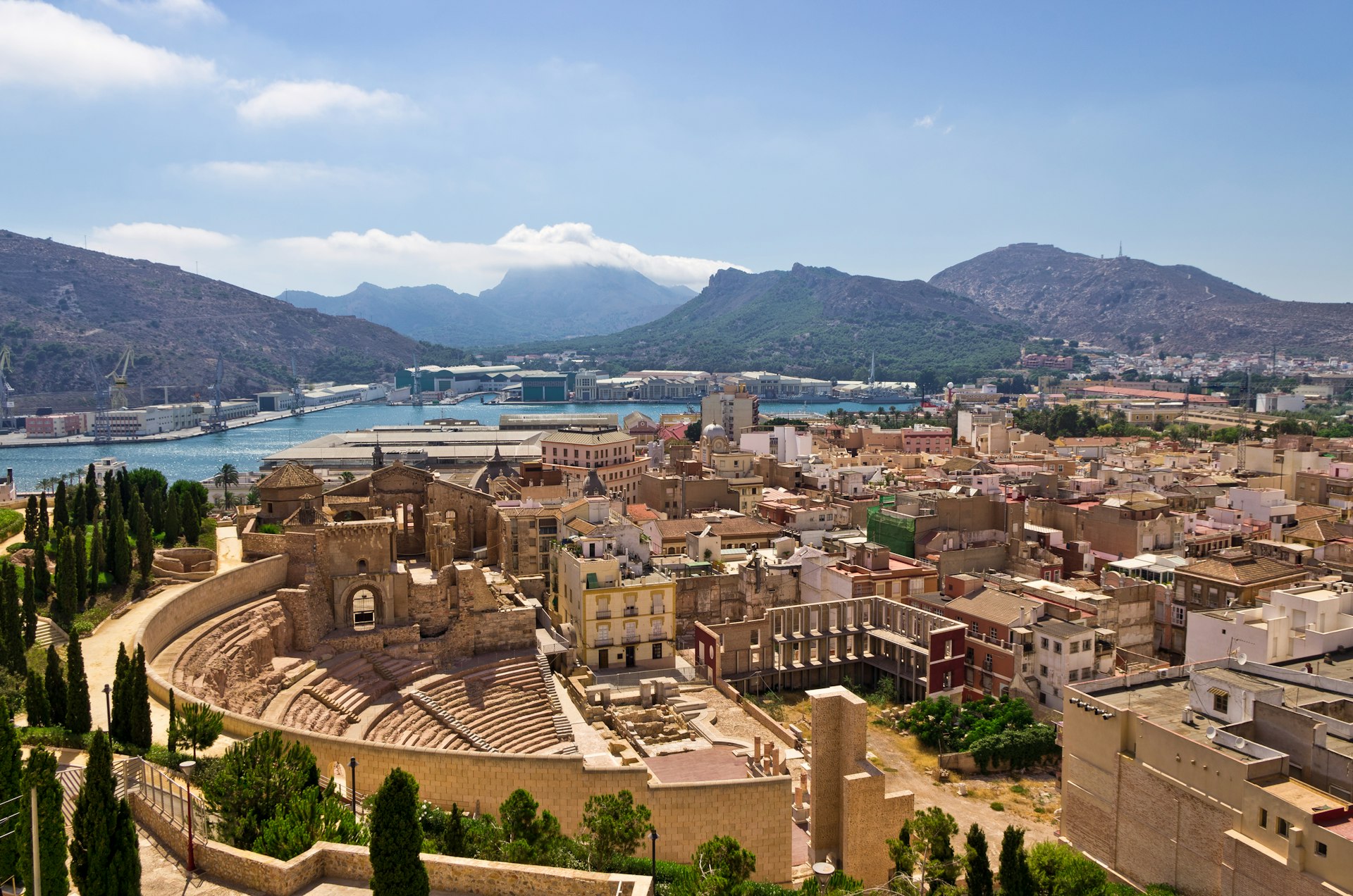
What to see in Cartagena, Spain
In between joining festive processions while dressed in your finest Roman or Carthaginian dress, it’s well worth exploring Cartagena’s rich palimpsest of historical remains, which date back to the Roman and Carthaginian eras. Start with the Teatro Romano – one of the largest amphitheaters in the Roman world, excavated in the 1990s, and accessed via a well-designed, minimalist museum on Plaza del Ayuntamiento that displays a careful selection of statuary, ceramics and ritual objects.
Head north to the Foro Romano on Molinete hill for a stroll around the Roman forum, dating from the 1st century BCE, past remains of wealthy Romans’ villas, complete with fragments of wall paintings, and the thermal baths. Several blocks east, peruse an intact section of the old Punic wall at Muralla Púnica , part of the city’s Carthaginian legacy. Finally, head south to the port that led the Carthaginians to establish a city here in the first place, and marvel at a wealth of amphorae, coin hoards and other ancient treasures recovered from the depths at the striking National Museum of Underwater Archaeology .
Where to stay in Cartagena, Spain
It's easy to arrange your stay in Cartagena so that you’re in the thick of the action, especially since the vast majority of the hotels are conveniently clustered in the compact Old Town. Most festivities take place in the Old Town’s Plaza del Ayuntamiento and Plaza de San Anton before proceeding to the Festival Camp across the river.
Stay at the contemporary, business-style NH Cartagena to be a stone’s throw both from the harbor and the Plaza del Ayuntamiento; in the boutique La Casa de las Flores for a blend of historical features and creature comforts; or wallet-friendly B&B Hotel Cartagonova for quick access to Plaza de San Antón.
Where to eat in Cartagena, Spain
For full immersion, there are Roman-themed food tents at the Festival Camp where you can fill your belly with grilled meats and wine. Aside from that, Old Town has a dense concentration of restaurants and tapas bars. Many are just off the Calle Mayor procession route, including the atmospheric El Barrio de San Roque , which excels at fresh fish dishes and stews. CafeLab serves the city’s best coffee, plus brunch dishes in a spectacular centuries-old building, while the traditional tapas ( tortilla de camaron , gazpacho, cazón adobo , sardinas ) at Albedrío really shine. For a truly special meal that makes the most of locally sourced, seasonal ingredients, complemented by a superb wine list, seek out Michelin-starred Magoga .
Explore related stories
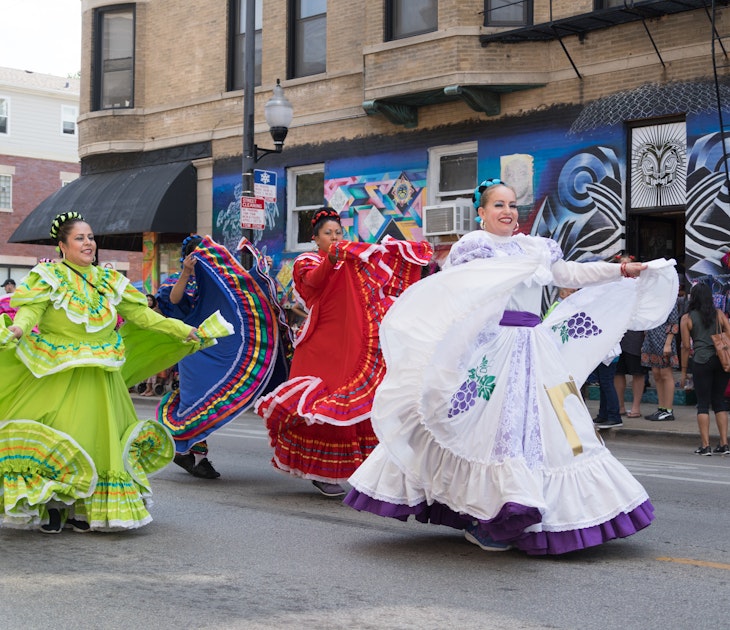
Sep 2, 2022 • 5 min read
A nationwide guide to the best neighborhoods, museums, festivals and more places to celebrate Latin culture.
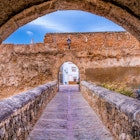
Nov 1, 2021 • 7 min read

Feb 12, 2021 • 6 min read

Jan 14, 2020 • 4 min read
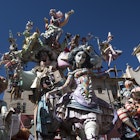
Jan 5, 2020 • 4 min read

Nov 20, 2019 • 3 min read

Oct 10, 2019 • 6 min read
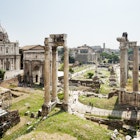
Apr 19, 2024 • 4 min read

Mar 25, 2024 • 6 min read

Mar 22, 2024 • 5 min read

7 Best Cartagena Spain Shore Excursions
Are you looking for the best cartagena, spain shore excursions so you can make the most of your time in this vibrant port city.
Whether you’re seeking cultural adventures, shopping, or plenty of sunshine and relaxation – there is something for everyone to enjoy.
Don’t feel like reading this whole post? I gotcha covered ⤵️
Private Roman Walking Tour
⭐️ Rating: 5/5 ⌛️Tour Time: 4 hours (approx.)✅
Nestled within the southeastern corner of Spain is Cartagena, a coastal town with an interesting history.
Wandering through this charming town, evidence of the town’s past is all around you, including a host of Roman monuments as well as museums.
Cartagena, Spain, is often overlooked in favor of larger, more well-known Spanish cities. However, I believe that Cartagena is a gorgeous town that is well worth visiting.
Being a relatively hidden gem, you don’t have to contend with huge crowds, which is a real bonus!
In this article, I’m going to help you choose the best shore excursion in Cartagena so that you can really make the most of your day in this delightful town.
My Top picks for the Cartagena Spain Shore Excursions.
Full-day cartagena and murcia.
⭐️ Rating: 5/5 ⌛️Tour Time: 6 to 8 hours (approx.)
Private Coves and Beaches Explorations
⭐️ Rating: 5/5 ⌛️Tour Time: 5 hours (approx.)
Top Cartagena Spain Shore Excursions for Cruisers
1. private roman walking tour, including the roman theatre.
⭐️ Rating: 5/5 ⌛️Tour Time: 4 hours (approx.)✅ Book it Here
Cartagena is fantastic if you’re a history buff, as dotted throughout the town are a number of Roman monuments.
The most striking attraction within Cartagena has to be the Roman Theater , a restored Roman amphitheater that was built sometime between 5 and 1 BCE.
The spectacular amphitheater was discovered by accident in 1988 during the excavation of a basement. The amphitheater had lain buried beneath Cartagena for centuries until this point.
Today a visit to the Roman Theater is one of the most popular things to do in the town.
The Theater is just one of many Roman sites. Another must-visit Roman site, Casa de la Fortuna (the House of Fortune) , is the underground ruins of a 1st-century Roman house.
Within this resorted house are a number of rooms furnished with discovered artifacts. The house offers a great snapshot of Roman life.
Both the Roman Theater and Casa de la Fortuna can be visited as part of a private walking Roman tour through Cartagena.
A walking tour also offers the opportunity to see more of Cartagena, taking you down quaint streets which are lined with characterful buildings.
You will also get the chance to do a bout of shopping on your tour.
Great Tour to Understand Cartagena!
➡️ Check Rates and Availability of Private Roman Walking Tour, including the Roman Theatre, here!
2. Highlights of the Cartagena Half-Day Private Tour
⭐️ Rating: 5/5 ⌛️Tour Time: 4 hours (approx.) ✅ Book it Here
If you want to soak up all of Cartagena’s highlights in one morning, a half-day tour of Cartagena may just be what you’re looking for!
On this private tour , you will visit all of Cartagena’s highlights, starting with the Cabo de Palos lighthouse, which sits just outside Cartagena on a 600-meter-wide peninsula.
Built-in 1865, this lighthouse has been declared a Site of Cultural Interest due to its neoclassical architecture.
On your excursion, you will also get to admire the Punic Wall, an archeological site that dates back to the 3rd century BC, showing the first-ever defensive wall of Cartagena, built by the Carthaginians.
You will get to marvel at other notable attractions, such as the Roman Theater, Castillo de la Concepción (a grand castle on a hill), and Museo Naval (the Naval Museum).
Highly recommended!
➡️ Check Rates and Availability of Highlights of the Cartagena Half-Day Private Tour here!
3. Murcia Full-Day Private Tour
⭐️ Rating: 5/5 ⌛️Tour Time: 6 hours (approx.)✅ Book it Here
A 40-minute drive or 1-hour train ride north of Cartagena lies Murcia, the sprawling capital of the region .
Home to a historic center, leafy boulevards, and a delicious culinary scene, a visit to Murcia makes a fantastic day trip for cruisers!
On a private guided tour of Murcia , you will get to meander down charming city streets, soaking up the electric ambiance of Murcia whilst admiring some of its most famous landmarks.
You’ll visit the Cathedral Church of Saint Mary in Murcia, a gorgeous Roman Catholic cathedral that dates back to the 14th century.
Also on your itinerary is Real Casino de Murcia , one of the most beautifully designed buildings in the city.
Spanning 6 hours, the tour will also take you to some must-visit attractions in Cartagena, including the Punic Wall .
Excellent Tour
➡️ Check Rates and Availability for the Murcia Full-Day Private Tour here!
4. Full-Day Cartagena and Murcia
⭐️ Rating: 5/5 ⌛️Tour Time: 6 to 8 hours (approx.)✅ Book it Here
If you simply can’t decide between visiting Cartagena and Murcia, you don’t have to! This full-day shore excursion takes you to the highlights of both destinations.
Your time will be split equally between Cartagena and Murcia, allowing you 3 hours to explore each alongside your guide.
Within each settlement, you will visit the highlights, including the Roman Theater and Cervantes House in Cartagena and the Cathedral Church of Saint Mary in Murcia.
As well as visiting the key attractions, you will have time to sample some local cuisine.
Your tour guide will pick you up and drop you off right outside your cruise ship.
Wonderful tour
➡️ Check Rates and Availability for the Full-Day Cartagena and Murcia here!
5. Private Coves and Beaches Explorations
⭐️ Rating: 5/5 ⌛️Tour Time: 5 hours (approx.) ✅ Book it Here
If history isn’t your thing, then perhaps a shore excursion to some of the best beaches and coves in Cartagena is more in line with your interests.
This private shore excursion with an English-speaking driver and guide takes you directly from your cruise ship to some of the best beaches in the area.
First, you’ll visit Cabo de Palos , the entrance to Las Islas Hormigas , a spectacular protected marine reserve.
From there, you will journey to the lighthouse at the tip of the peninsula, a spot that yields absolutely breathtaking views of the surrounding area.
Next on your itinerary is La Manga del Mar Menor , which is just north of the lighthouse.
It’s a 21-kilometer-long sandbank that separates the Mediterranean Sea from Mar Minor (Minor Sea), which is, in fact, the largest saltwater lagoon in Europe.
Perched on the shores of the sandbank are a host of beach bars and restaurants, the perfect place to unwind and grab a bite to eat.
You will also get to visit Salinas de Marchamalo , salt flats which form part of a protected nature reserve, and Cala Cortina, a beach nestled in a cove that is a relatively hidden gem in Cartagena.
Sunset sensation!!!
➡️ Check Rates and Reviews of the Private Coves and Beaches Explorations here!
6. Luxury Rewaco Trike Ride through Cartagena
⭐️ Rating: 5/5 ⌛️Tour Time: 4 hours (approx.)✅ Book it Here
If you fancy exploring Cartagena in style, why not consider a trike ride through the gorgeous mountains that sit behind Cartagena?
A motorized trike tour allows you to feel the wind rushing through your hair as you enter the vast Spanish countryside.
Characterized by winding roads that hug the hillside and yield panoramic views into the nearby valleys, this stretch of countryside to the east of Cartagena is perfect for those who love natural scenery.
On this unique sightseeing tour, you will ride through traditional villages, get the chance to gaze at vibrant lemon groves, and even visit an old mining area.
On your mesmerizing journey, you will hear stories from your local guide about the area’s unique history and heritage.
➡️ Check Rates and Availability of the Luxury Rewaco Trike Ride through Cartagena here!
7. Horseback Riding Tour
⭐️ Rating: 4.5/5 ⌛️Tour Time: 2h 30 min. (approx.)✅ Book it Here
Just outside Cartagena is Calblanque Regional Park, a vervent area of outstanding natural beauty which houses rolling hills and secluded coves.
There are a number of hiking trails that you can take through this protected area. Alternatively, why not explore the countryside on horseback?
This horseback riding tour in Cartagena takes you through the beautiful hills, allowing you to feel at one with nature as your well-trained horse meanders through the wilderness.
Giving you a unique vantage point from which to admire the natural landscape. You will be accompanied by a guide throughout.
The trail ride typically takes just over an hour. However, there are opportunities available to arrange a longer ride which includes riding on a beautiful stretch of beach.
Fantastic experience!
➡️ Check Rates and Availability for the Horseback Riding tour here!
Cartagena Spain Shore Excursions Guide & FAQ
Free packing list.
Download a free Mediterranean Cruise Packing list with shopping link!
It’s all yours!
Your list will be in your email! (Check your spam folder if you do not see it)
Can you walk from your cruise ship to Cartagena, Spain?
Yes! It’s a mere 5-minute walk from your cruise ship into Cartagena city center. Many of the key sights in Cartagena are within walking distance from Cartagena Cruise Port, including the Roman Theatre (a 10-minute walk) and Castillo de la Concepción, a beautiful castle on a hill (a 20-minute walk).
Where do cruise ships dock in Cartagena, Spain?
Cartagena Cruise Port can be found at the southernmost tip of Cartagena Marina, on a long pier known as the Cruise Ship Dock. It’s within walking distance of the city center and Cartagena’s key attractions.
What is the best way to get around Cartagena?
Cartagena is a relatively compact town, with most of the key attractions only a short walk away from one another. Therefore the best way to get around, in my opinion, is on foot. The Old Town and Cartagena’s main attractions are all within walking distance of each other.
If you wish to venture outside the Old Town, into the modern surroundings, then a taxi would be easier as the modern city is further away from the cruise port.
Is it worth visiting Cartagena, Spain?
In my opinion, Cartagena is definitely worth visiting! It’s one of the best cruise ports in Spain . The town is beautiful and hosts a number of fascinating historical monuments. Additionally, the nearby beaches and stretches of countryside make the town equally perfect for those who wish to be surrounded by nature, whether that’s relaxing on a beach or taking a hike through the hills.
Another good thing about Cartagena is that it doesn’t get anywhere near as busy as Spain’s large cities, perfect if you want to beat the crowds.
What is the best time to visit Cartagena?
Cartagena can be visited throughout the year. The best time to cruise the Mediterranean Sea and visit Cartagena is between May and mid-October, when the temperature is hottest and you are less likely to encounter rain. It’s a peak season, so you can expect to contend with crowds more crowds at this time of year.
The best balance between having pleasant weather and fewer crowds is May, September, and October.
What is the currency in Cartagena?
The currency in Cartagena, Spain, is the Euro.
Final Thoughts on Cartagena Spain Shore Excursions
Cartagena is a picturesque town that holds a fascinating history. With ruins, ancient monuments, and museums positioned at pretty much every corner of the town, it’s particularly great for history buffs.
However, even if you’re not into history, Cartagena still has a lot on offer, from pristine beaches to a delicious food scene.
There really is a shore excursion for everyone! Which Cartagena shore excursion has caught your attention?
If you need any help at all planning your European Cruise, please reach out! I help at no additional cost to you!
Cruise Resources
These are my tried and true, favorite cruise-planning helpers:
➡️ Cruise Critic – for reviews, deck plans, and cabin choices
➡️ Parking – for saving on your long-term parking
➡️ Travel Insurance Master – Because, yes, you do need insurance
➡️ Trip Advisor –
For Reviewing Tours and Excursions
➡️ Viator – For Shore Excursions
➡️ Shore Excursions Group – More choices for small group excursions
➡️ Resort for a day Passes in Mexico, the Caribbean, and the Bahamas
➡️ Atlantis Day Pass
➡️Cruise Packing List for Caribbean or Alaska
➡️ Cruise Tips
➡️Also, if you don’t want the hassle and stress of booking your own cruise, I can do it for you at no additional cost! You can read more about
These products are services I have used myself and trust. Purchasing through the links above, helps me continue my blog at no additional cost to you, and I appreciate it so much!
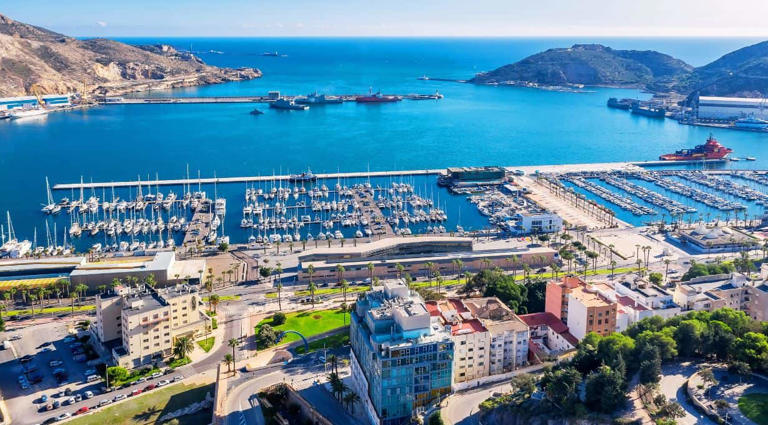

7 Best Things To Do In Cartagena Cruise Port (Spain) | Port Overview

Welcome to Cartagena cruise port, Spain! (Post updated: March 2024)
Nestled on the southeastern coast of Spain, in the Murcia region, Cartagena port (Puerto de Cartagena) boasts a rich Roman historic heritage and is often included in the Western Mediterranean cruise itineraries.
I’ve had the chance to visit Cartagena a couple of times on a cruise and I loved the city’s vibe, incredible history, stunning architecture, amazing shopping and food. The cruise terminal is located in the heart of the city, so you can easily explore the city landmarks on foot. In this article, I share with you the insider information on:
- Cartagena cruise port (Cartagena cruise terminal, getting around)
- Top 7 things to do in the port of Cartagena and the Cartagena shore excursions
Visit our cruise port guides for Alicante , Vigo , Barcelona , Valencia , Malaga , Cadiz , Palma de Mallorca
Cartagena Cruise Port
Cartagena cruise terminal is located within a 5-10 minute walk from the city center and the main shopping street Calle Mayor. It can accommodate one ship at a time.
There is no terminal building. Cruise ships dock at Cartagena Promenade (aka Cartagena’s marina) where you’ll find facilities such as a taxi rank, a tourist information booth, and large parking for tour buses.
Taxis usually offer tours of the city and to Murcia at an affordable price that you can check at the tourist information kiosk available on the pier.
To get to the city center, turn left and walk along the Muelle de Alfonso XII quay, a beautiful tree-lined boulevard until you reach Plaza Ayuntamiento , a large square where the main pedestrian street Calle Mayor starts.
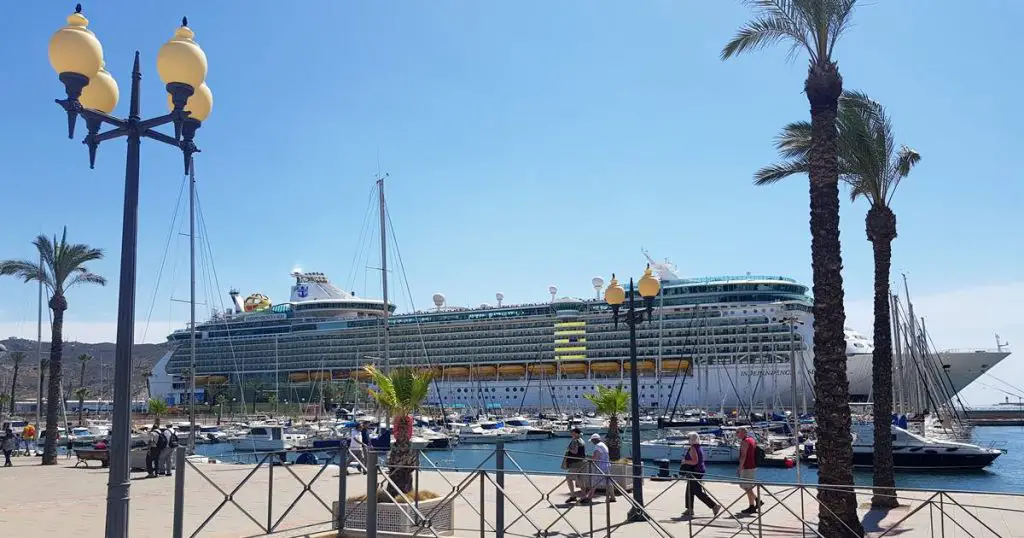
Getting Around Cartagena Spain
- Cartagena Promenade and the area around the marina are flat and wheelchair-friendly , as well as the main shopping street.
- The currency in Spain is EURO (€). The exchange offices and ATMs are available in the city.
- Taxis are inexpensive and available on the pier. If you want to use public transport, the bus stops are located along Muelle de Alfonso XII quay, right in front of the ship. The single bus ticket costs 1,20€ and you can check the timetables at https://www.cartagena.es/
- Cartagena train station is located a 20-minute walk north of the port. You can check the schedules and fares at https://www.renfe.com/
- The Tourist Bus is available and it will allow you to enjoy both modern and the old Cartagena with its walls, buildings and archaeological remains. The buses run every hour, and the bus stop is located across the street from the terminal.
- Free Wi-Fi is available in cafes and restaurants on the promenade and the city center.
- When in Cartagena, keep in mind the Spanish siesta time. The majority of shops and pharmacies are closed every day from 13:30 h to 16:00 h, however, some big department stores and shops on the main street are fully open, especially during the cruise season. The museums and landmarks are usually closed on Monday.
- The nearest airport is Región de Murcia International Airport, located 32 km/20 miles (a 25-minute drive) north of the city of Cartagena.
- Murcia , the capital of the region and the city where the majority of the cruise lines offer shore excursions is located approximately 56 km/35 miles (a 35-minute drive) north of Cartagena port. Book a private transfer to/from Cartagena cruise port
- Explore Cartagena tours and activities
- Search for the best Cartagena hotels
7 Best Things to Do in Cartagena Cruise Port
Before I share the best things to do in Cartagena, I invite you to grab your copy of the “ Mediterranean Cruise Port Guide” , the most comprehensive guide to 45 Mediterranean cruise ports (including Cartagena) , packed with practical information, expert tips & unforgettable experiences! (PDF format/200 pages)

1. Calle Mayor
Calle Mayor is the main pedestrian and tourist street, packed with shops, restaurants and bars. Around here you can find banks, pharmacies, tobacco shops, ATMs, exchange offices, supermarkets, hotels, administrative buildings and historical landmarks.
Some of these are the Roman Theater and its museum , Old Cathedral of Cartagena (Catedral de Santa María la Mayor), Iglesia Castrense de Santo Domingo , Foro Romano , Parque Arqueológico Cerro del Molinete and others.
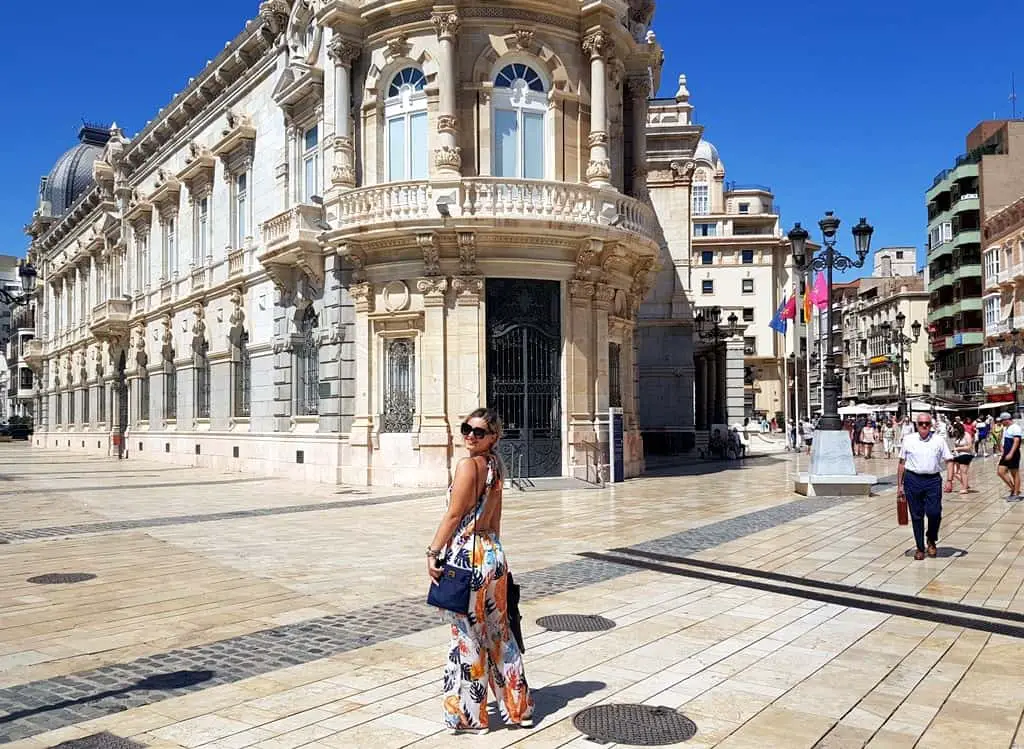
If you continue walking straight, you will reach lovely squares surrounded by shops and tapas bars where you can have a meal or lunch at very affordable prices. Some of these squares are Plaza de San Sebastián, Plaza Icue and Plaza de España, with its beautiful park and playground located in the center of a roundabout.
What I love about Cartagena is that everything is close to the dock and you can explore the majority of attractions on foot. However, some parts of the city are uphill so be mindful of that when booking a shore excursion or going there on your own.
Cartagena is also one of my favorite cruise ports for shopping , as the choice is amazing and the prices even better. I suggest you check out the local brand stores that you’ll find in Calle Mayor and the neighboring streets.
Explore Cartagena walking tours
2. Palacio Consistorial
Built in the eclectic style at the beginning of the 20th century, Palacio Consistorial de Cartagena houses the City Hall and dominates Plaza del Ayuntamiento, the central square. It is the administrative home of the Council of Cartagena however the main public offices are in another building.
The impressive building has a triangular shape (in the picture above) and is ornated with extravagant decorative elements. It is lavishly decorated inside and consists of two exhibition halls used for protocol activities, concerts and other public functions. It is possible to visit the City Hall and guided tours are offered.
3. Roman Theater
Teatro Romano de Cartagena is a restored Roman amphitheater dating from the 1st century BC. It is nestled at the foot of the hill where the medieval Conception Castle (Castillo de la Concepción) is located and is best viewed from there.

The Roman Theater was built during the government of Emperor Augustus who dedicated it to his grandchildren, Gaius and Lucius Caesars. The magnificent theater could host 7.000 spectators and is nowadays fully restored, with a modern museum featuring outstanding collections and archeological artifacts.
The Old Cathedral of Cartagena was built over the upper cavea (seating sections of the amphitheater) in the 13th century, whose ruins nowadays make this architectural set spectacular and one-of-a-kind.
The entrance to the Roman Theater is located at Plaza Ayuntamiento, at the beginning of Calle Mayor. You may face lines at the entrance. The Roman Theater and its museum are partially wheelchair-friendly.
Check out The Roman Theater tours and activities
4. Concepción Castle
Castillo de la Concepción sits on a hill overlooking the port of Cartagena and represents one of the most iconic city landmarks. Situated in the heart of Parque Torres, it is the perfect spot to admire the panorama of Cartagena and learn about the city’s impressive, 3000 thousand years old history.
Built on the place of a former Alcazaba (a Muslim palace-fortress), the construction of the castle started in the second half of the 13th century when the city was taken from the Moors by Alfonso X of Castile. Throughout history, the castle had defensive purposes until the end of the 18th century when it lost its military importance.
In the first half of the 20th century, it was transformed into a city park that nowadays houses a small museum that can be visited for a small fee.
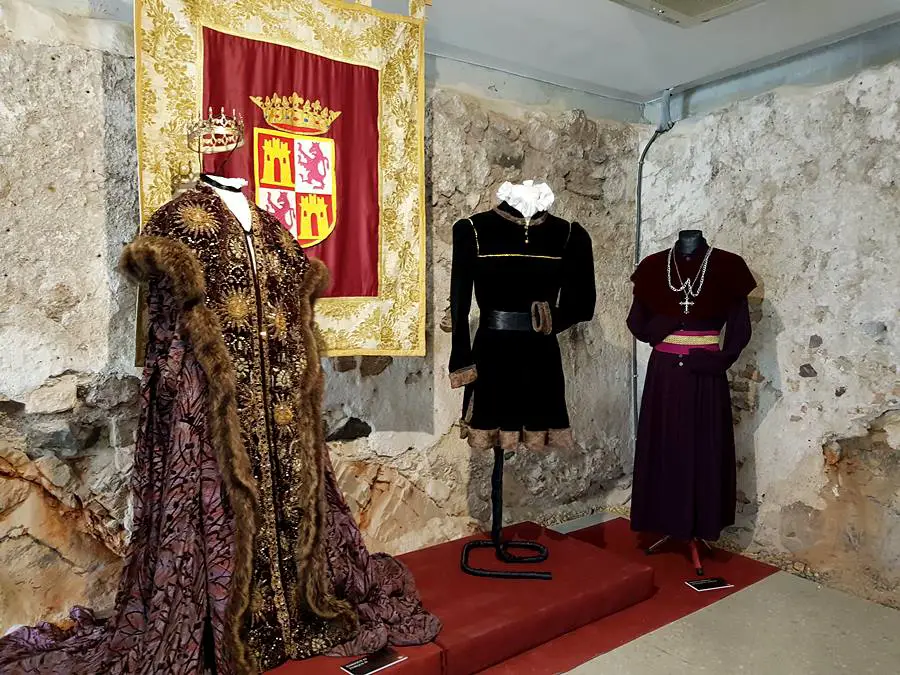
Castillo de la Concepción is quite small and can be visited in an hour. It is located on top of the hill and there is a well-maintained road taking you there, however, the vehicles can take you only to a certain point and not to the entrance.
If you decide to walk to the castle from the port, be prepared to walk uphill for at least 15 minutes and if you go there by car, still there is a portion of the road that needs to be handled on foot (approximately a 10-minute walk).
There may be a panoramic elevator available (the most convenient option for wheelchair users) on Calle Gisbert Street, however, make sure to check that with a tourist office booth that you’ll find on the pier. The entrance to the castle is wheelchair-friendly.
Check out Conception Castle tours and activities
5. Punic Wall Interpretation Center
Cartagena was founded in the 3rd century BC by the Carthaginian general Hasdrubal the Fair at the site of a natural harbour and until the 16th century, it was one of the most important naval ports of Spain.
The city boasts a rich and thousands of years old history which can best be explored at this modern, multimedia visitor center where you can discover the ruins of the 2.200-year-old “Muralla púnica de Cartagena” which failed to protect the city from the Romans.
The defensive walls bear witness to the Second Punic War, one of the most important events of Ancient history in the Mediterranean Sea. This impressive archeological museum offers insight into the ancient history of this part of the world and allows visitors to see the remains of the Punic Wall.
The Interpretation Center of the Punic Wall is located 1.2 km/0.75 miles from the dock and it takes 15 minutes walking to get there. The taxi ride from the port to the visitor center takes 5 minutes. The visitor center is wheelchair friendly and accessible toilets are available.
Explore the Punic Wall tours and activities
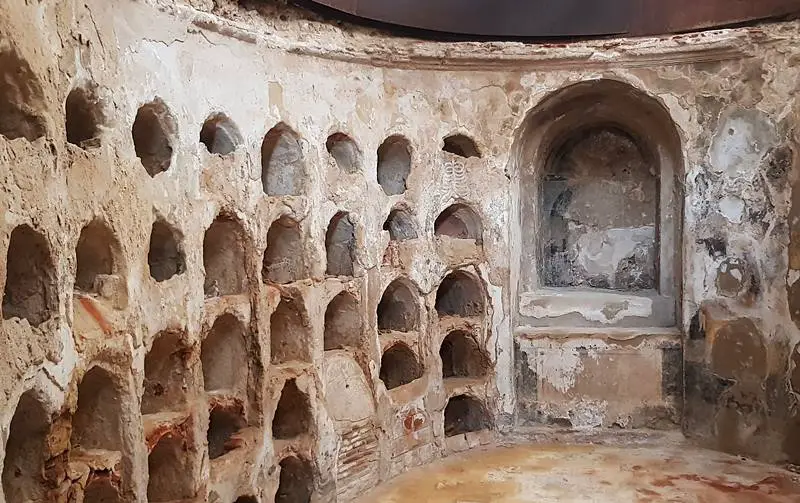
6. National Museum of Underwater Archeology
This impressive museum is located right at the Yacht Port Cartagena, less than a 5-minute walk from the dock. Upon exiting the ship, turn right and you’ll see two modern buildings housing the museum, designed to create an underwater effect.
This fascinating museum is the first underwater archeology museum in Spain that showcases underwater items including shipwrecks, fossils, and artifacts related to historic ships used in the ancient Mediterranean maritime trade.
There is a restaurant and a cafeteria on the top floor, offering great views of the harbour. The National Museum of Underwater Archeology is wheelchair-accessible.
A trip to the historic city of Murcia, the capital of the Murcia region, is one of the most popular shore excursions in the port of Cartagena. Nestled on the Segura River, Murcia was founded in the 9th century and nowadays primarily serves as a university town.
The city is known for its beautiful old town dominated by the stunning Cathedral of Murcia dating from the 14th century, featuring a blend of architectural styles including the Gothic, Renaissance and Spanish Baroque styles.
The Cathedral overlooks Plaza del Cardenal Belluga where you can also see the colorful Episcopal Palace of Murcia built in the 18th century.
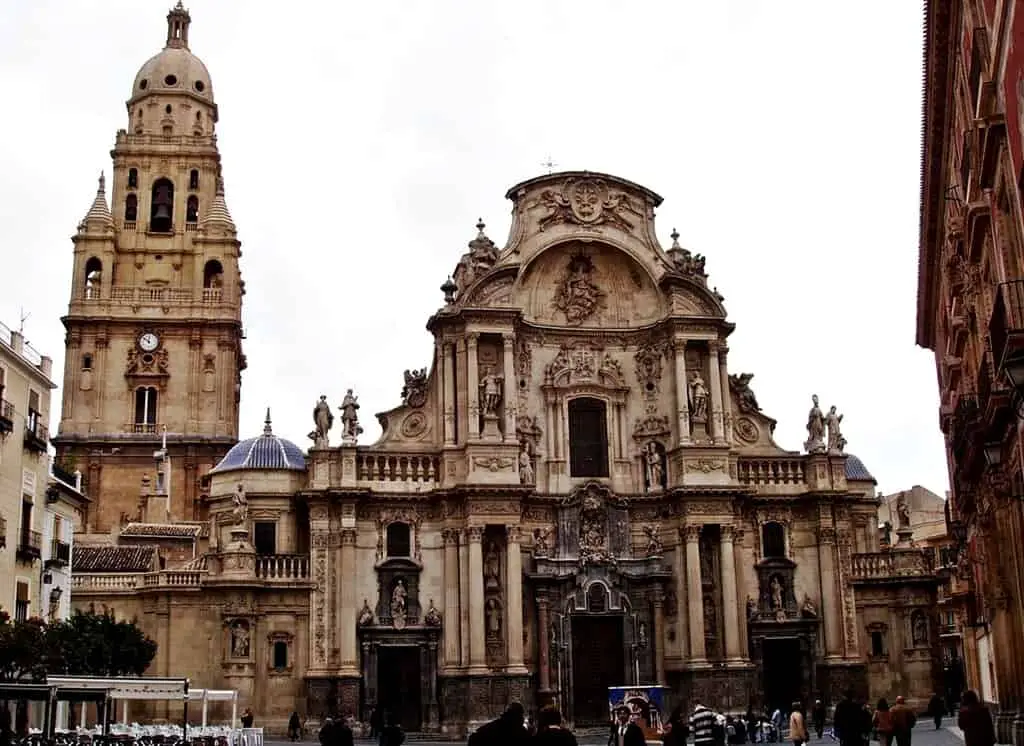
You can explore the city’s landmarks, wander around its old streets and indulge in the delicious tapas and sangria in the local bars you’ll find on every corner.
Murcia is located around 56 km/35 miles (a 35-minute drive) north of the port. There are regular trains from Cartagena station to Murcia del Carmen station and the ride lasts 50 minutes one way. Check the timetables at https://www.renfe.com/
Check out Cartagena to Murcia shore excursions
Visit our cruise port guides for La Coruna , Gibraltar , Rome (Civitavecchia) , La Spezia (Florence) , Lisbon
You may also like our cruise port guides to the Mediterranean , Caribbean , Western Europe , Baltic & Scandinavia , USA & Canada , Australia & New Zealand
Don’t miss out on the opportunity to enhance your Mediterranean cruise experience with our “ Mediterranean Cruise Port Guide “- your ultimate companion to discovering the region’s hidden treasures and creating unforgettable memories; click below to purchase your copy today and embark on the voyage of a lifetime!
This article may contain affiliate / compensated links. For full information, please see my disclaimer here.
Leave a Comment Cancel Reply
Your email address will not be published. Required fields are marked *


8 Reasons Why I Wanted to Visit Cartagena, Spain
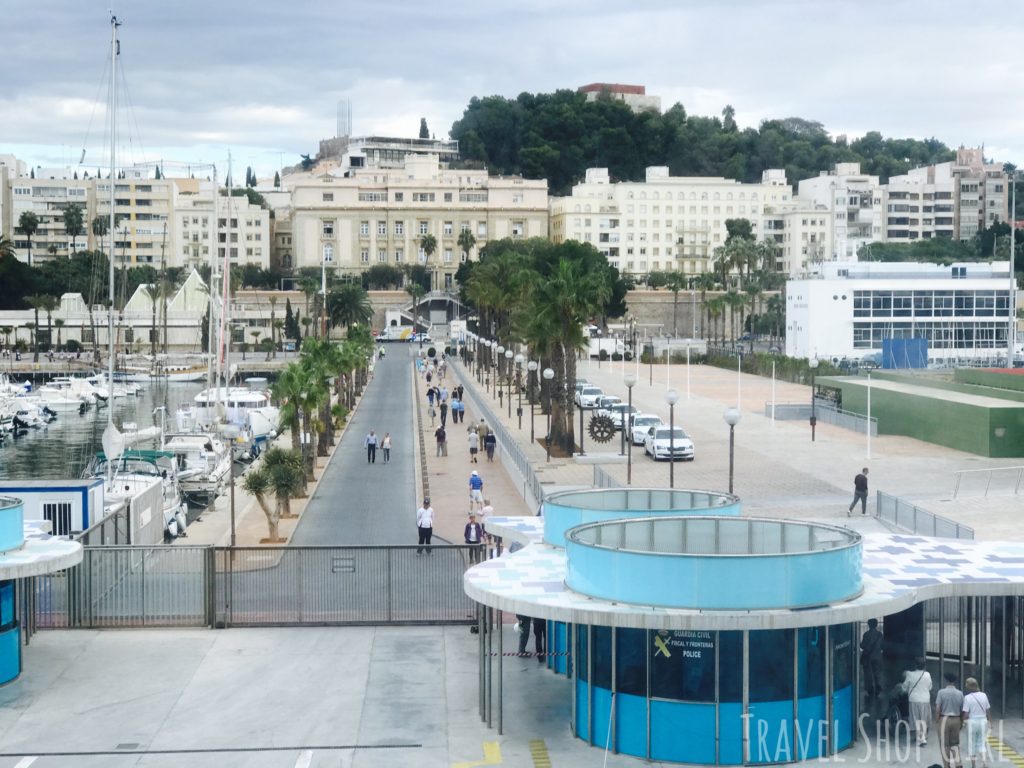
Today as I peered out my cabin window onboard Fred. Olsen Cruise Lines Balmoral , I could see right over to the beautiful city of Cartagena, Spain located in the province of Murcia. I was excited to visit all of the ports of call on this cruise, but I had several reasons why I wanted to visit Cartagena, Spain.
Reason #1: Cartagena, Spain and Cartagena Colombia
I’ve been lucky enough to travel to Colombia and I’ve stayed in a few cities there including Bogotá and Cartagena. When I saw that I would visit Cartagena, Spain on this cruise, I was curious how the two would compare. Would these cities have similarities or not?
TSG Tip : How do you pronounce Cartagena? Easy. So to say the name, say Car-ta-hey-na and like that — you’re now speaking Spanish.
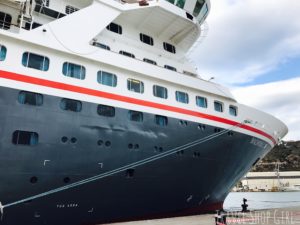
My friend, Danielle , and I made our way off the ship and decided to walk into Cartagena as it wasn’t far to the city. Cartagena has a population of 216,451 residents (as of 2014) in an area of about 215 square miles. Compare that to the other Cartagena, a city in Colombia that was founded in 1533 with a population of 1.1 million and an area of 221 square miles and named after Cartagena, Spain. While both cities are coastal cities and share a name, they are two distinct and different cities.
Reason #2: The Weather
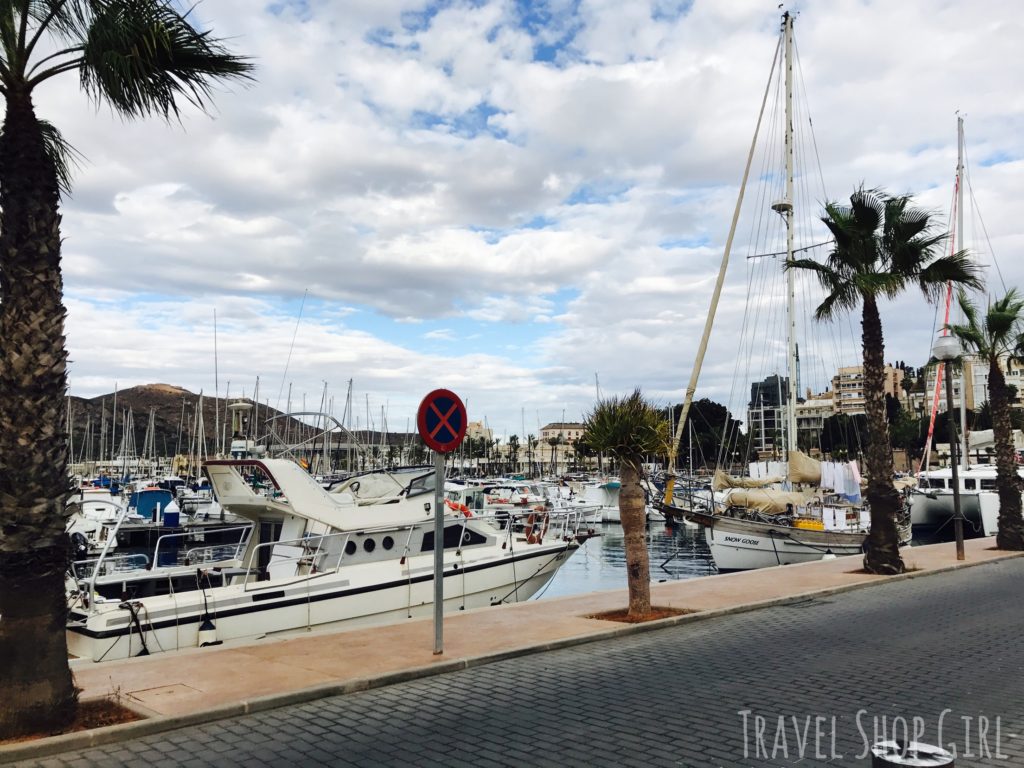
Located in southeastern Spain in the Mediterranean, the climate in Cartagena is one that anyone would enjoy year round. We’re talking an annual average temp of around 69 °F and an annual precipitation of no more than 15 inches. Hear that Boston? Yeah – I definitely could find myself living here.

From the ship, we walked less than five minutes before crossing the street and finding ourselves right in Cartagena. While most visitors head into Cartagena to see the major sites of interest, we were winging it for the day.
TSG Tip : Some of the major attractions include District of the Roman Forum, Punic Wall, Museum of the Roman Theatre, House of Fortune, Conception Castle Fort of Christmas.
Reason #3: Shopping
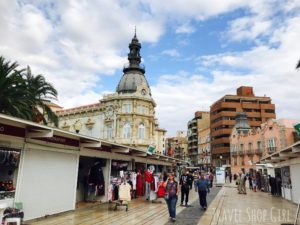
We were just in time for Cartagena’s fall fairs with merchants offering a variety of items like clothing, jewelry, handmade goods, and more. But beyond the booths here, there are tons of shops, both big name brands like Zara and Desigual , as well as small stores and everything in between.
Reason #4: Architecture
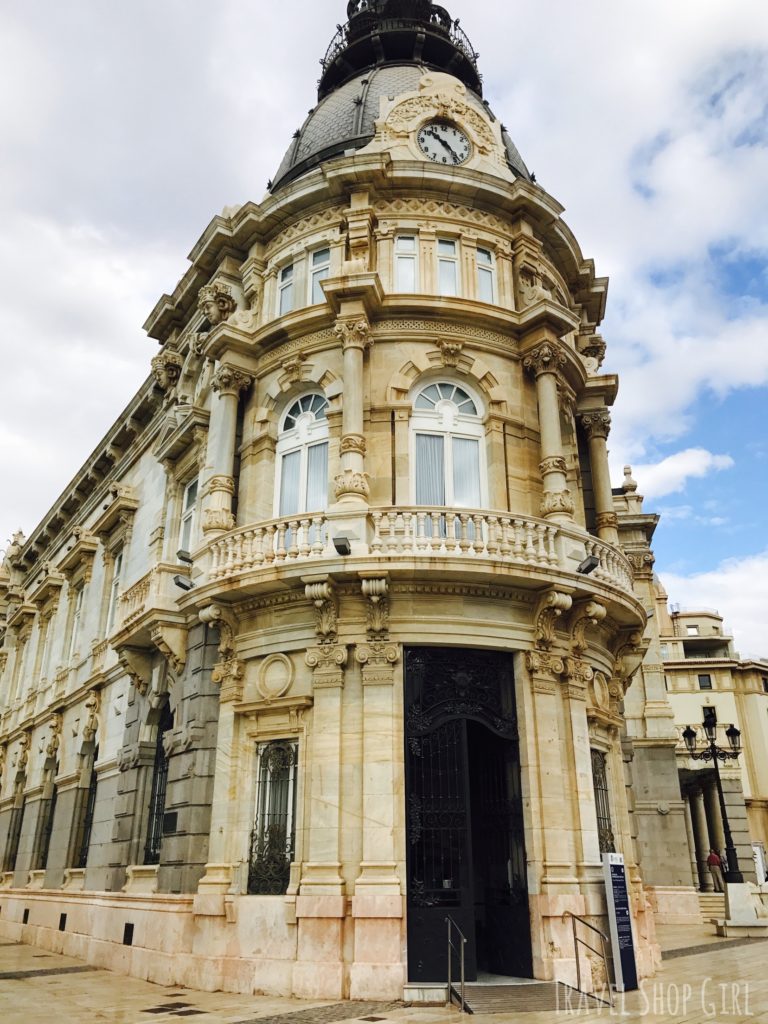
As you first walk into Cartagena, it will be impossible to miss this building, the Palacio Consistorial de Cartagena (Cartagena City Hall). Designed by Tomás Rico Valarino, construction began in 1900 and finished in 1907.

The building was refurbished about ten years ago to its current spectacular grandeur. 45 minute tours are available in English (€1) and should be booked in advance.

Whether you have time for a tour or not, take the time to admire this striking piece of architecture and many others as you walk along the streets of Cartagena.
Palacio Consistorial de Cartagena Plaza Ayuntamiento, 1, 30202 Cartagena, Murcia, Spain
Reason #5: Pedestrian Zone
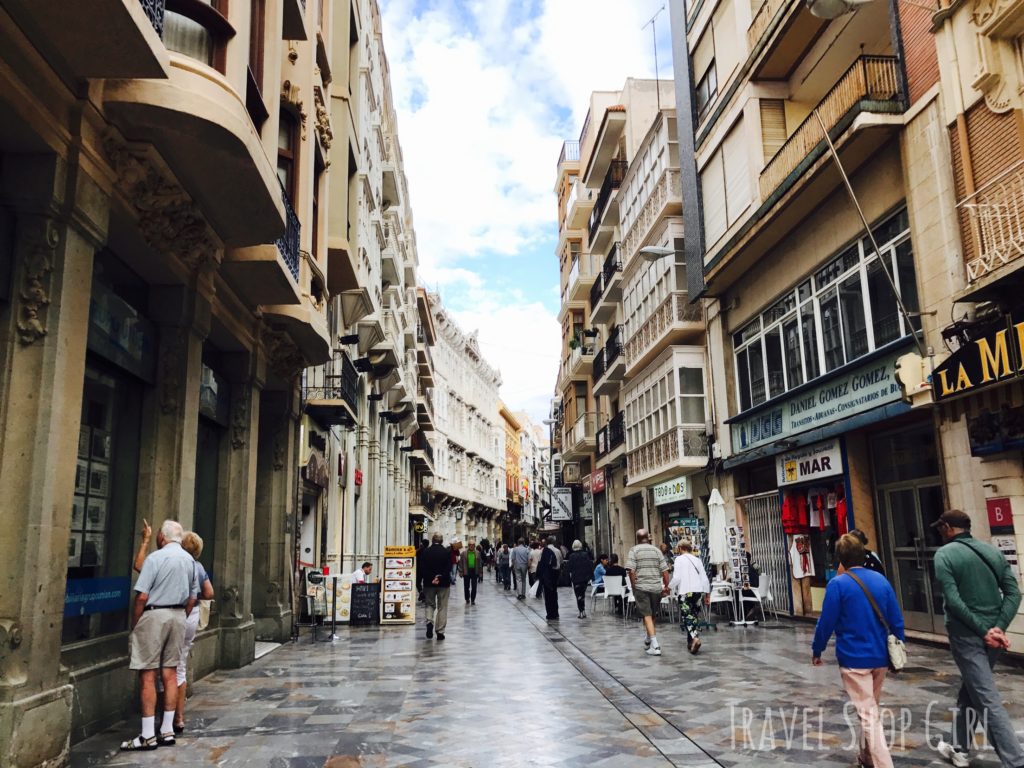
I was happy we didn’t have any plans or tours on this day as I was fine with finding things on my own this day. The pedestrian zone spans from Ayuntamiento to Plaza de España with shops, cafés, restaurants, and pretty much anything you need. The streets here are slate or granite, something so shiny and beautiful you’d think you were inside, not outside.

In fact, looking up at this building and down at the street, it almost felt like I was inside the Forum Shops at Caesars Palace in Las Vegas. You know, where the ceiling is made to look like the sky? While the sky was real, it looked so picture perfect that it almost didn’t look real, if that makes sense.
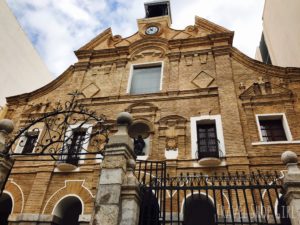
As a result, I did spend some time taking random pics of churches and doors because well, that’s what I do.

While I was hoping to get one or two items specific to Cartagena, instead I found a great store called Inside Shops that carried all sorts of clothing, shoes, and accessories, many with a British theme. At first I was like, “No way am I buying this in Spain,” but I couldn’t resist the prices. I ended up with a top, a scarf, and a little coin purse for all of €14. That’s way less than I would’ve spent in London so that’s a major score in my book.
TSG Tip : Holy Week, which is the final week of Lent, begins on Palm Sunday, the week before Easter. In Cartagena, Semana Santa or Holy Week is a big deal with a procession, special lamps or “cartelas,” drums, prayers, and the members of the Brotherhood. The members wear robes and a hood (capirote) to shield their face, a throwback to medieval times where the wearer was demonstrating their penance.

I mention this because no matter what time of year you visit, you’ll see the little figures in cloaks or robes of the Brotherhood sold as souvenirs. But then you’ll probably also see a sign underneath that reads, “ Holy Week in Cartagena. Not K.K.K. ” Therefore, if that doesn’t get your attention, nothing will.

As we walked along, I spotted a rather large sculpture that looked like sails and then just beyond that, one of the most visited sites in Cartagena, the Arsenal . Once Cartagena was named the capital of the Spanish Navy, construction on the neoclassical or baroque and gigantic Arsenal began in 1731. If you’re into military history, this is the place to visit. The gate here is the only original one left in walls of the city that gave access to the Arsenal .
Arsenal Calle Real, 26, 30201 Cartagena, Murcia, Spain
Palacio Consistorial de Cartagena
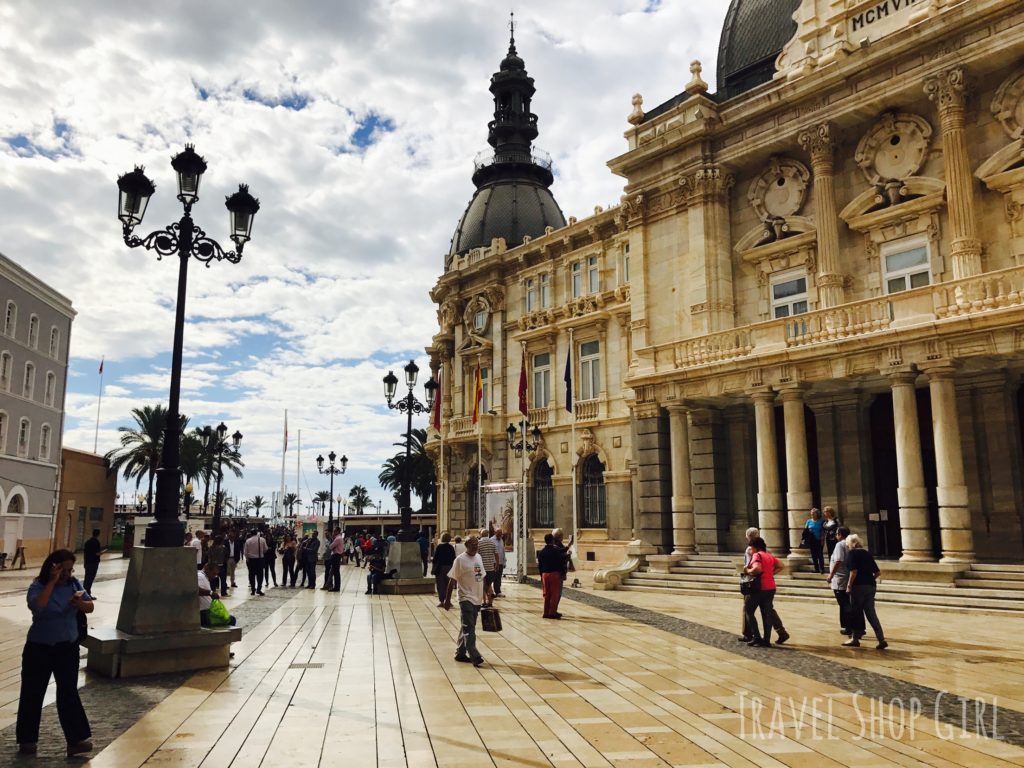
After browsing, shopping, and walking for a while, we found ourselves back where we started and decided it was probably time to head back. On the way, I couldn’t resist snapping more pics of the Palacio Consistorial de Cartagena .

Reason #6: Monuments, Sailors, and Cervantes

As I looked to the right, I saw this rather large monument that I hadn’t seen while walking into Cartagena. Titled, “ Monument to the Heroes of Cavite and Santiago de Cuba ,” this memorial is dedicated to all those that died during the Spanish-American War of 1898. What I found impressive was that the monument is surrounded by flowers and trees, making this a relaxing and tranquil place to stop and collect your things before heading back to the ship.
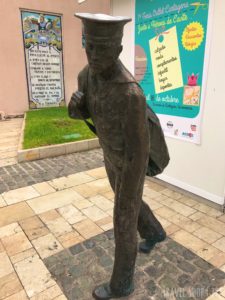
Looking over to the left, I noticed two more things I missed on the way in. First was this life sized bronze sailor statue, obviously a tribute to the fact that Cartagena is an important military hub in Spain. The second item, located near the famous city mosaics, was a plaque on the wall behind the sailor statue that was dedicated to Miguel de Cervantes on the four hundredth anniversary of his death. You should definitely stop to have a pic taken with the sailor and then admire those mosaics afterwards.
TSG Tip : What’s the connection Cervantes had with Cartagena? He was said to have visited at least twice (1568 and 1581) and even attempted to gain employment there as an accountant, although unsuccessfully.
Reason #7: The Yacht Club

While the next stop for us could’ve been straight back to the ship, we weren’t quite ready for that. Since the ship docks in what is known as the yacht club, there’s a few bars and even a Burger King for those absolutely in need of a fast food burger.
Coyote Ugly

As for us? We were content to sit in the sun after a few days of non-stop rain and enjoy the view. Out of the restaurants/bars that are right in this area, the Coyote (Coyote Ugly?) is definitely the most popular and so that’s where we sat.

Over the period of a couple of hours, I devoured a café con leche, a grilled cheese. Seems like it’d be a no brainer that I couldn’t possibly leave Spain without an order of Patatas Bravas as well.

But I don’t think this place was about the food. Nope, they were about drinks. As a result, I had this massive Margarita and didn’t care that they had ripped the name off from the original Coyote Ugly Saloon. Because it’s so not my place to discuss copyright infringement when I only want to enjoy a drink with my friend, know what I mean?

Seems like with this view it was hard to get up and return to the ship. Especially in the nearly 80° weather, but what can you do? I knew I’d eventually have to board the ship.
Coyote Ugly Paseo Muelle Alfonso XII , Cartagena, Spain
Leaving the Yacht Club

As I walked back to the ship I took in my last few images of the water, the yacht club, and wished I could stay. While both Cartagena, Colombia and Cartagena, Spain share a name and rich histories, they couldn’t have been more different. Cartagena, Spain was a sleepy little city with a Mediterranean feel. Yet I found Cartagena, Colombia so different as it’s definitely a far larger metropolitan city.
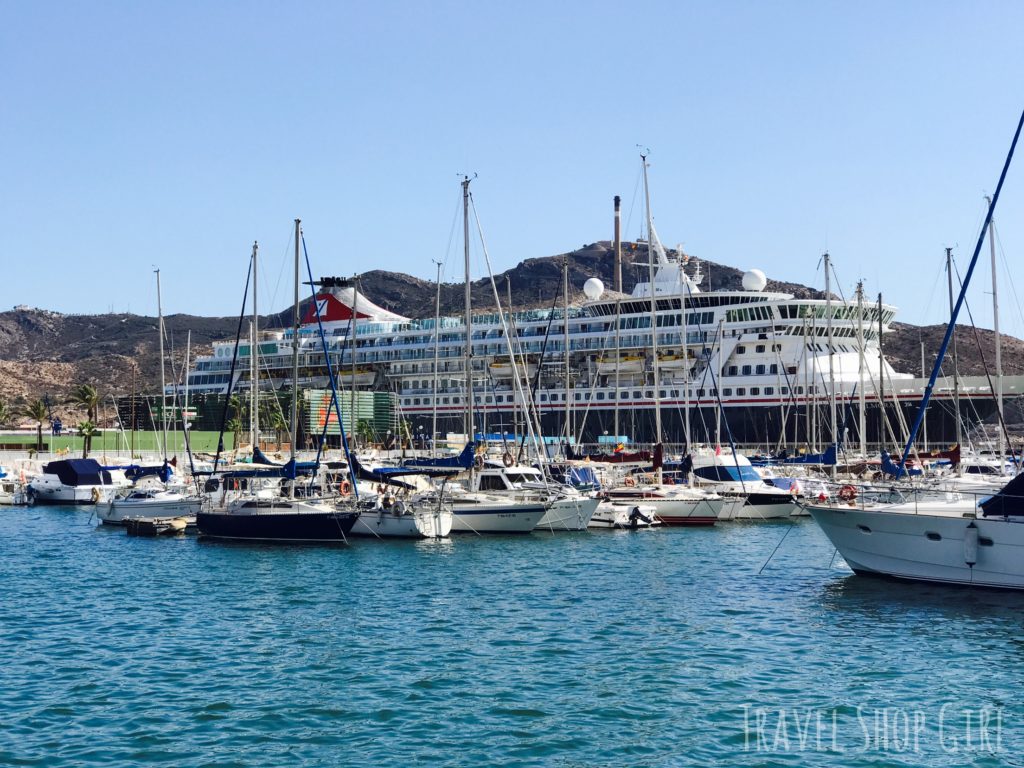
While I would’ve enjoyed staying longer in Cartagena, I had to get back onboard. There was still so much cruise left with more ports and adventures ahead.

Once onboard, we did as you’d expect that we’d do and we went straight up to the Lido Bar on deck 8 for our 4pm sailaway party. Because, in the end, that’s one of the reasons why cruising is such great fun.
Reason #8: Lighthouses

During the sailaway I was glued to the railing for pictures and video. I wasn’t about to miss a shot of this candy cane striped lighthouse called Cartagena Dique de Navidad (Navidad Light).

Although I only imagined the reasons I wanted to visit Cartagena, Spain, I left with a new appreciation for this quaint Spanish city even though I only saw a small section of it. As we sailed out of Cartagena and admired the landscape we were leaving behind, we were already dreaming of our next port of call on Balmoral : Gibraltar .
Have you ever visited Cartagena, Spain? Don’t forget to check out the rest of the Travel Shop Girl website for more great travel and destination information.

4 thoughts on “ 8 Reasons Why I Wanted to Visit Cartagena, Spain ”
I have to be honest, I never realized there was a Cartagena, SPAIN. I’ve only ever heard of the one in Colombia but it looks like the one in Spain is pretty beautiful! #WeekendWanderlust
Thanks Lolo! It was an amazing destination to visit.
Thanks Ruth! I wasn’t sure what to expect of the city, but it was a pleasant surprise!
Comments are closed.
Sunshine Seeker
Dream ◇ Create ◇ Travel
Popular categories, a first-timer’s guide to cartagena spain cruise port.
By: Charlotte · Last updated 27. January 2024 · In: Spain , Travel

Located in the Region of Murcia on the southeastern coast of Spain , Cartagena is a historic port city with a rich cultural heritage, making it an increasingly popular stop for cruise ships.
The modern cruise port welcomes hundreds of thousands of passengers every year and the convenient location provides visitors with easy access to explore the city’s ancient history, beautiful architecture and vibrant local life.
So if Cartagena is one of the stops on your cruise, you’re in for a treat. Let’s take a look at all the best things to do in Cartagena and the top tours departing from the Cartagena Spain cruise port .
🌟 Remember, always get insurance before you travel to Spain or anywhere else. SafetyWing is an affordable subscription-based travel insurance that you can purchase even after departure. Read my complete SafetyWing review here.
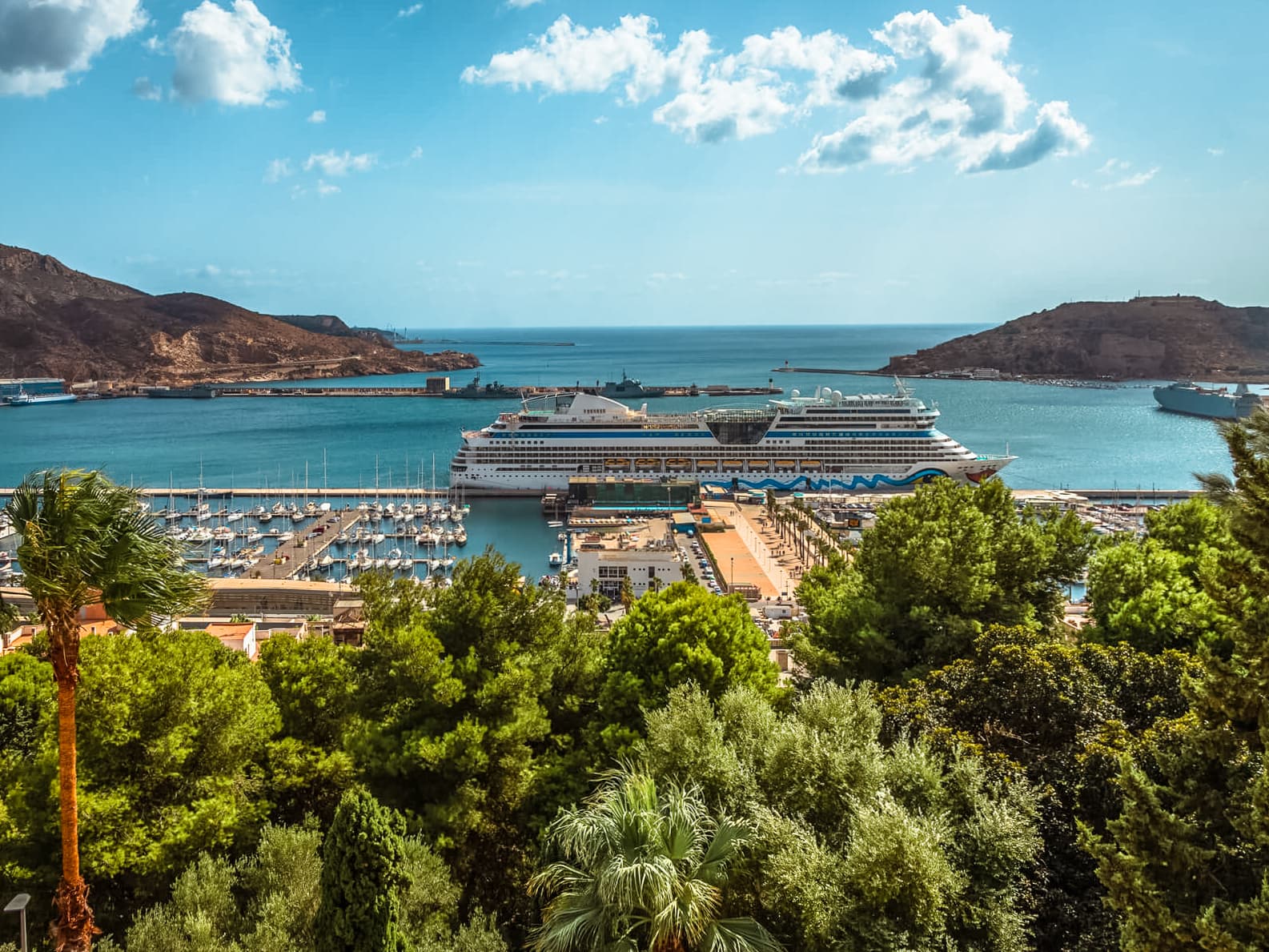
Article overview
Cartagena Cruise Port map
Things to do close to the cruise port, 🐚 coves & beaches private shore excursion, 🏛 private 4-hour shore excursion of cartagena, 📸 private photo session in cartagena, architecture, history and culture, where do cruise ships dock in cartagena, how do i get from the cruise port to cartagena’s old town, is cartagena spain worth a visit, what is the best time to visit cartagena spain, how much time do i need in cartagena, how to get from corvera airport to cartagena, what cruise lines visit cartagena cruise port, remember to pin for later 😉, overview of cartagena spain cruise port.
Cartagena is in my mind a bit of a hidden gem, often overlooked by most travelers coming to Spain. Both the port and city are much less busy than say Malaga Cruise Port or Barcelona Cruise Port .
Upon arriving at the Cartagena cruise port Terminal Juan Sebastian Elcano, you’re greeted by a stunning view of the city’s harbor, lined with sailboats and yachts.
The port offers various amenities and services such as tourist information, cafes, and souvenir shops for passengers to take advantage of before venturing into the city.
From the port, it is only a short walk to reach the historic center, making it convenient to explore the many attractions Cartagena has to offer in a short space of time. To give you an idea of the distances, you can walk from the port to the Roman Theatre in only 8 minutes.
The port is also easily accessible by car or public transportation, with regular bus and train services connecting the city to other parts of Spain.
In addition to historical sites, Cartagena offers various leisure and recreational activities. If you’re a water enthusiast, you can make your way to the marina for sailing, kayaking, or paddleboarding.
Or if you prefer a more relaxed experience, you can take a leisurely stroll along the harbor promenade or visit the city’s local markets. I also highly recommend joining a tour to get the most out of your visit to this beautiful city and the underrated region of Murcia .
Is there a shuttle bus from Cartagena cruise port?
No there are no shuttle buses running from Cartagena cruise port because the old town and other attractions are within easy walking distance of the port.
There is a bus stop and taxi rank right in front of the cruise terminal. A bus ticket to the city center should only cost a little over €1. However, if you are able, I highly recommend you walk.
What is the main pedestrian street in Cartagena Spain?
The main pedestrian street in Cartagena, Spain is Calle Mayor. It is a lively street located in the heart of the city’s historic center, lined with shops, restaurants, and historic buildings. The street is closed to traffic, making it a popular spot for strolling and people-watching.
After you exit the cruise port, keep left and walk along the marina until you see a tiled square (Plaza Héroes de Cavite) with lots of palm trees and a beautiful ornate building.
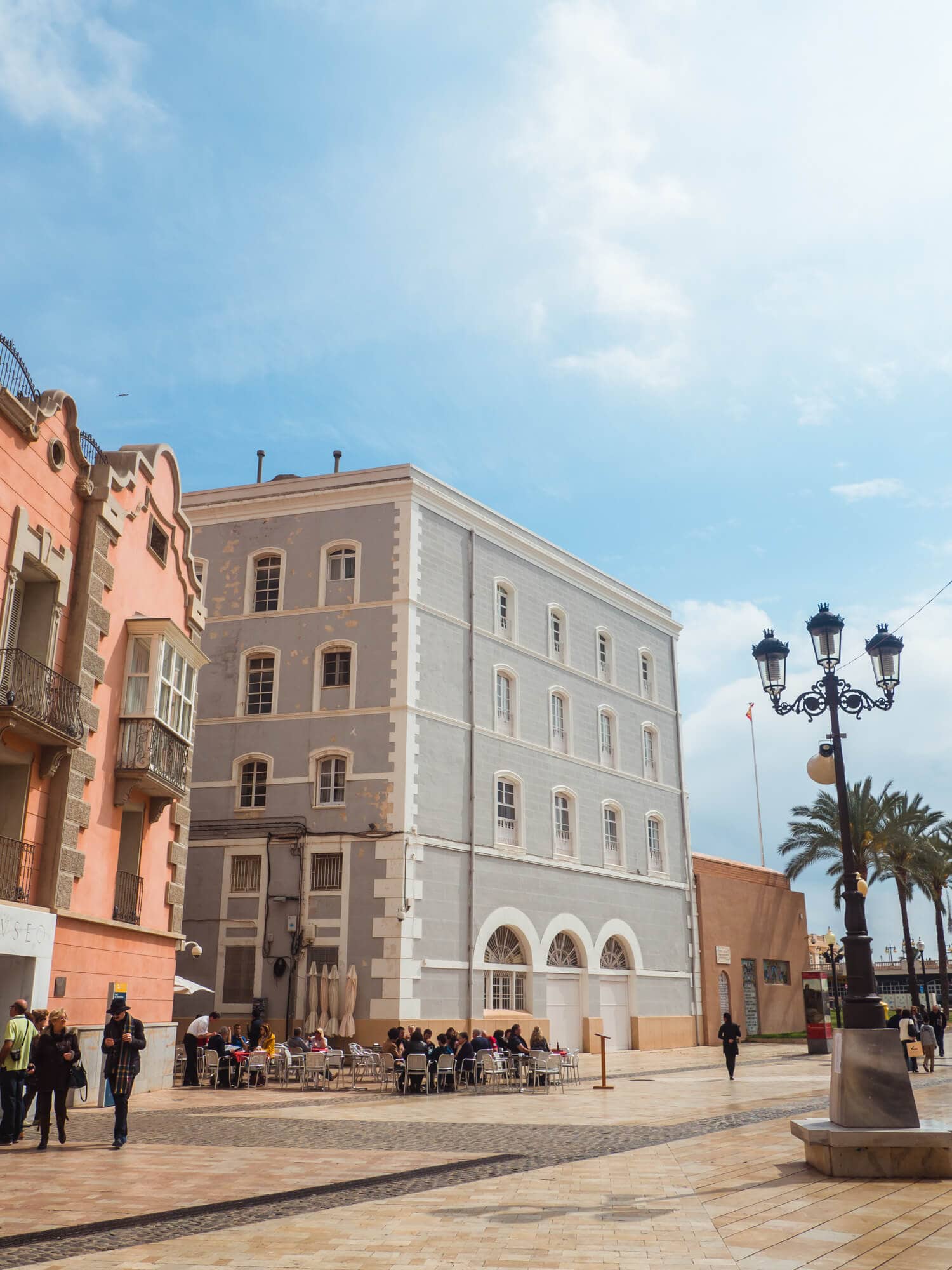
Tours from Cartagena Cruise Port
Make the most of your docking in Cartagena by booking one of these exciting experiences in advance.
This is my favorite tour departing from Cartagena cruise port , as it is fully customizable. Run by Kim and Chiringo Tours, you get to explore the best of what the Murcian coast offers with a glass of fizz in hand.
The suggested itinerary starts with a visit to the charming fishing village of Cabo de Palos, known for the striking lighthouse that towers over turquoise coves and golden beaches.
Next, you stop for some beach time and drinks in the chiringuitos on the La Manga strip, a long sandbank developed as a holiday resort in the 70s and today a playground for wealthy Spaniards.
You also have the option to stop at one of the most beautiful beaches in the region, Cala Cortina and drive through the salt flats of Marchamalo, where you might spot a flamingo or two.
🌟 My top pick >> Coves & Beaches Private Shore Excursion
Prefer to focus on the history of Cartagena? Explore the city in style during your shore leave on this half-day tour with both an official guide and a private driver. As mentioned above, I think Cartagena is one of the most underrated cities I’ve ever been to and a must on any itinerary.
The tour includes highlights such as the Roman Theater (entrance included), the Naval Museum and the National Museum of Underwater Archeology, the Punic Wall and the Molinete Archeological Park. You also get to ride the panoramic elevator up to Torres Park and Cartagena’s castle to enjoy the beautiful views.
Pickup and drop-off at the port or your Cartagena hotel are included.
🌟 Click here for current price and availability >> Private 4-hour Cartagena Shore Excursion
Meet a local photographer as soon as you get off the ship to capture your memories on camera, by yourself or with your loved ones. Cartagena is the perfect backdrop with its historic, colorful buildings and palm tree-lined streets.
The photoshoot only lasts for around 30 minutes so you’ll have ample time to do some sightseeing as well.
And the best part is that you literally have nothing to lose as they offer a 100% money-back satisfaction guarantee. This means that if you don’t like the result of your photo shoot, you can contact the company within 7 days and claim your money back!
🌟 Click here for current price and availability >> Private Photo Session in Cartagena
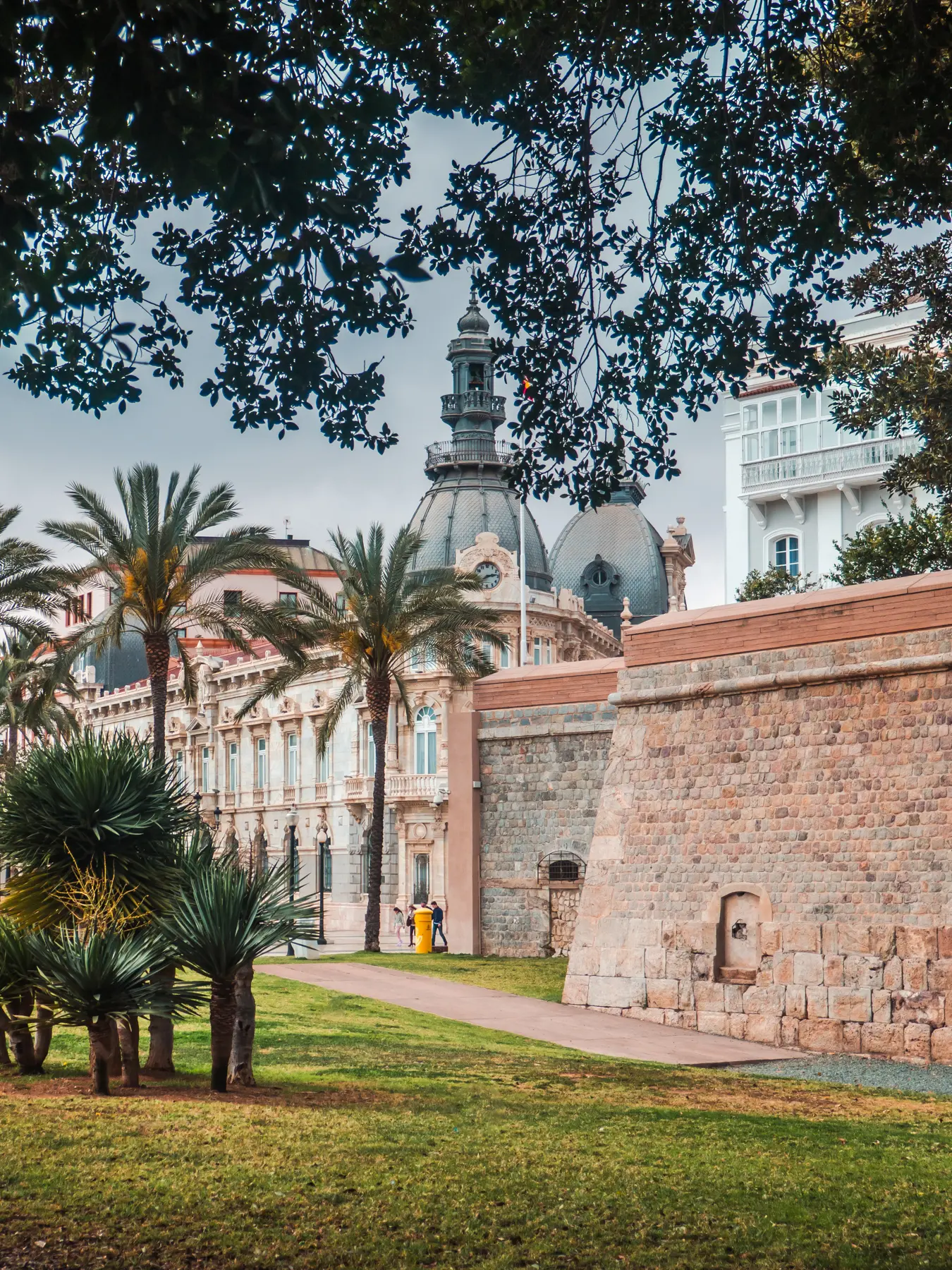
Top things to do in Cartagena
All the historic landmarks of Cartagena tell a fascinating story of the city’s diverse past, giving visitors an immersive experience of its rich history.
Aside from the historical sites, Cartagena also boasts stunning modern architecture, a vibrant food and drink scene and lively street markets. It is a must-do Spain bucket list experience !
🌟 My top tour pick >> Whenever I visit a Spanish city I love to do a food tour, this is the one I recommend in Cartagena. Just make sure you are clear on the meeting point and make your way there as soon as you disembark.
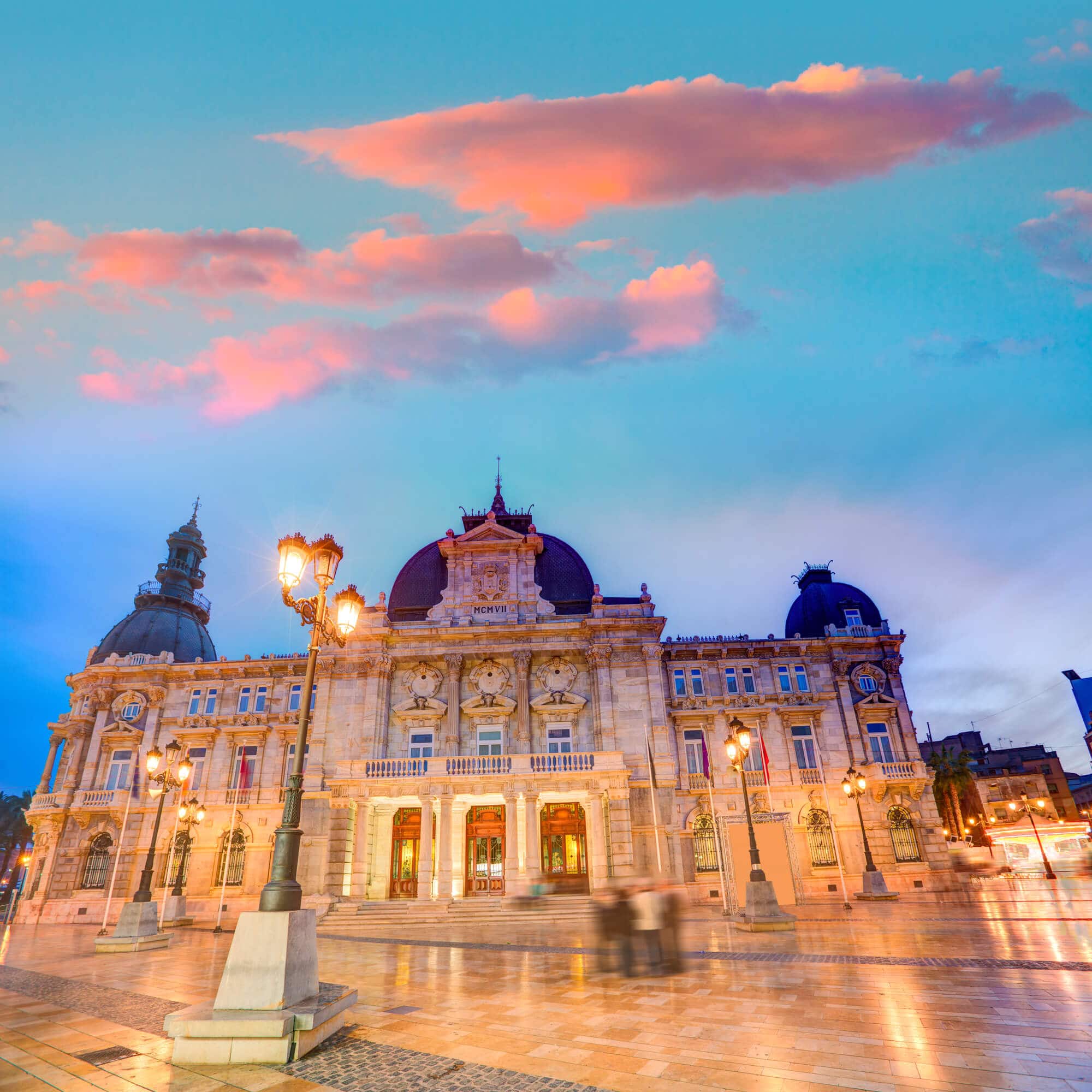
In the late 1800s, the mining industry in the mountains surrounding Cartagena made a handful of people very rich, and the expression of this wealth can be seen in the architecture of the historic center of Cartagena and nearby La Unión.
The 100-year-old town hall on Plaza del Ayuntamiento, one of Cartagena’s most impressive modernist wonders, is a definite highlight. Take in the intricate facade, composed entirely of white marble and topped with domes coated in local zinc, and explore the inside for some much-needed time in the shade during the summer months.
A semi-shaded pedestrian street paved with distinctive blue marble tiles links the town hall with Plaza de San Sebastián to the north. It’s a typically Spanish “Paseo” and I love to go for a stroll here to enjoy the architecture and browse the many boutiques.
With its strategic location on the Mediterranean coast, Cartagena has been a crossroads for various civilizations and an important port city throughout the centuries. Inhabited since the 3rd century BC, its historic architecture and landmarks reflect its long and fascinating history.
The highlight is by far the Roman Theatre dating back to the 1st century BC and the Punic Wall, which was built by the Carthaginians in the 3rd century BC. A fun fact is that the Theatre was first discovered in 1988 during the construction of the Centro regional de artesanía and the archaeological excavations and restorations were only completed in 2003.
I also recommend a ride on the panoramic elevator taking you up to explore the impressive Castillo de la Concepcion, a medieval fortress that offers stunning views across the city and the surrounding coastline.
30 minutes by car outside the city you’ll find Bateria de Castillitos, a military fortification built as part of a defense system along the coast in the 1930s. At 250 meters you’ll be met by extraordinary views of the mountainous landscape in this natural park.
🔥 Hot tip >> Visit the 4 top Cartagena sights at a discounted price with this combo ticket – the Roman Theater, Roman Forum Museum, Panoramic Lift, and Conception Castle.
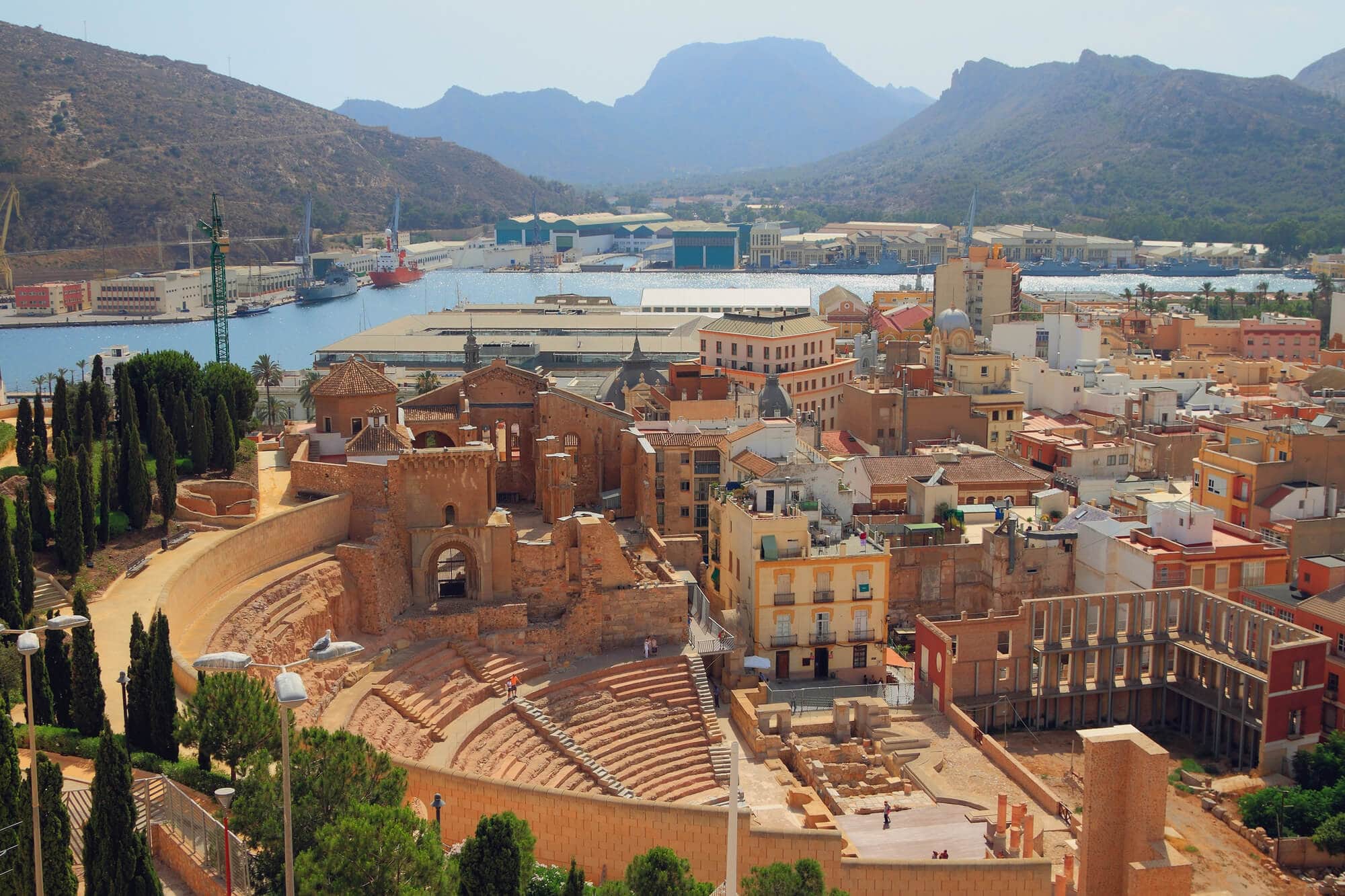
Cartagena is also home to several exciting museums that cater to a variety of interests:
- The Roman Theatre Museum: Displaying the well-preserved Roman Theatre and its artifacts. A must and the first stop for many visiting Cartagena.
- Municipal Archaeology Museum: See some of the latest evidence of Roman settlement, dating from 300 to 700AD, in addition to everything from Neanderthal remains to Phoenician ceramics.
- ARQUA, Marine Archaeology Museum: Marvel at historical artifacts from underwater sites such as the treasure of Nuestra Señora de las Mercedes, a frigate sunk in the early 19th century with 14.5 tons of gold and silver onboard.
- MURAM – Museo Regional de Arte Moderno: A modern art museum that houses contemporary artworks from the region.
- Spanish Civil War Museum: Housed in a massive air-raid shelter this museum is a space for the memory of more recent military history of Cartagena, which was a strategic point and primary objective of the bombings during the civil war.
- Museo Militar de Cartagena: Showcases the military history of the area, featuring intriguing exhibits of military equipment. In the museum building, constructed in the late 18th century, and in the courtyard you’ll find tanks, missiles, field telescopes, heavy-duty guns and all kinds of military equipment.

In addition to its historical sites and museums, the Carthaginian coast is also known for its beautiful beaches. Relaxing on the sand after a bit of sightseeing is the best way to spend your time here. Some of my favorites include:
- Cala Cortina : A beautiful, secluded beach with crystal clear waters, perfect for swimming and snorkeling.
- Playa de Calblanque : Several golden sandy beaches within a protected natural park, with shallow waters perfect for a swim.
- Playa del Portús : A picturesque, smaller beach nestled within a cove ideal for those seeking a tranquil atmosphere.
So as you can see, Cartagena is a must-visit destination for anyone interested in history, culture, natural wonders and beautiful coastal scenery.
Whether you’re arriving by cruise ship or exploring the city on your own, there’s something for everyone to enjoy in this charming Spanish port city.
FAQs: Cartagena Cruise Port
Cruise ships dock at the Port of Cartagena, which is located about 4 km from the Old Town. The port has two terminals, and most cruise ships dock at Terminal de Cruceros.
There are several ways to get from the cruise port to Cartagena’s Old Town. As mentioned above, the Old Town in Cartagena is located just a 5-10 minute walk away from the port. Alternatively, you can grab a taxi or bus right outside the terminal.
Yes, Cartagena is definitely worth a visit. I love it there! It is such a beautiful maritime city known for its rich history, stunning architecture, and beautiful beaches.
The city has a long and fascinating history, with numerous ancient ruins and historic landmarks to explore, including the Roman Theater, the Punic Wall, and the Cartagena Naval Museum.
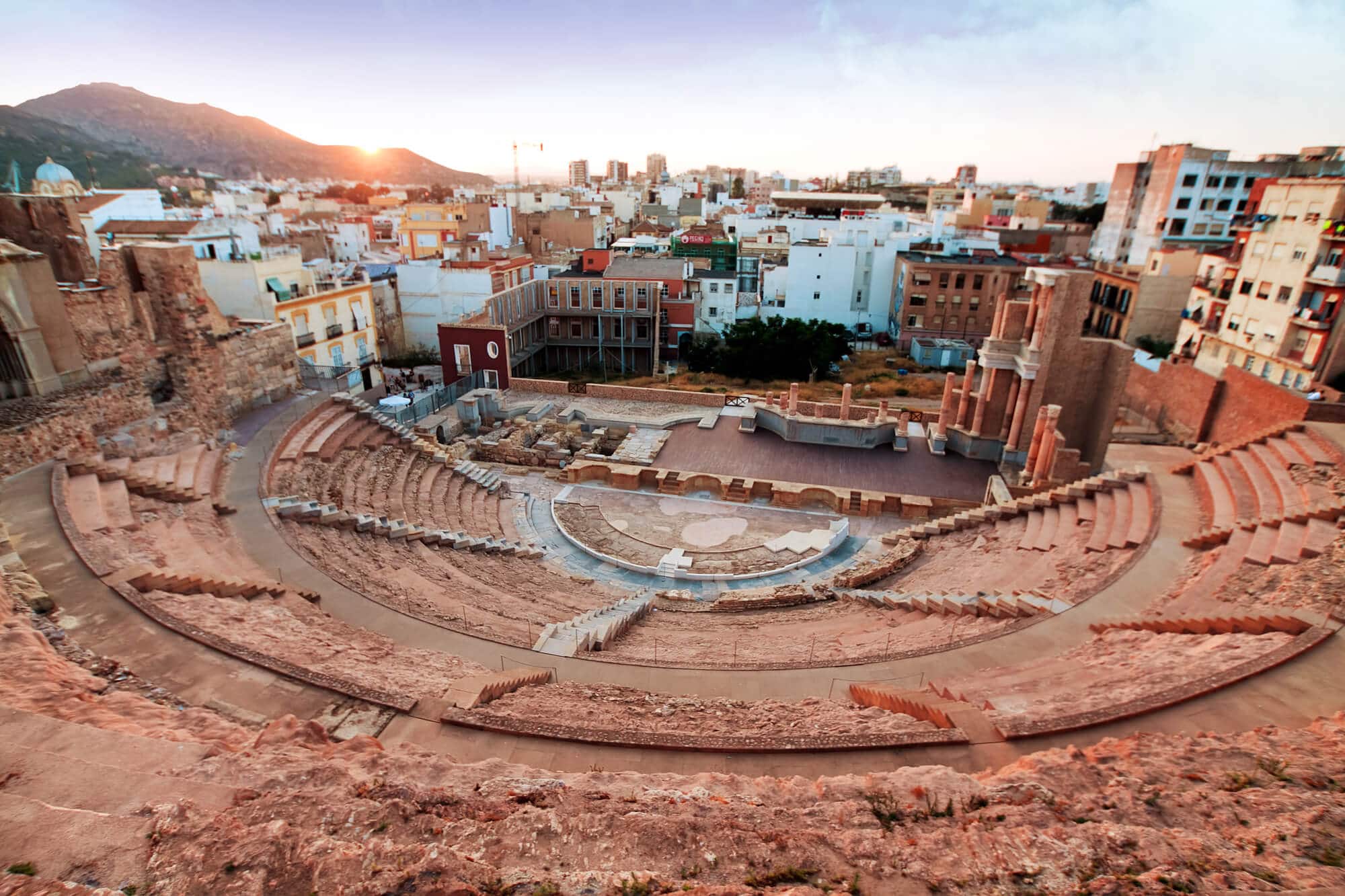
The best time to visit Cartagena is from May to September when the weather is warm and sunny. However, this is also the peak tourist season, so the city can be crowded.
If you prefer to avoid the crowds, you can visit in the shoulder seasons of April and October. My personal favorite time to travel in Cartagena, and Murcia in general, is May-June and October-November.
You can see the main attractions of Cartagena in one day. The city is relatively small and easy to navigate, and many of the top attractions are located within walking distance of each other.
There are several options for getting from Murcia Corvera Airport to Cartagena:
- Taxi: Taxis are readily available at the airport and can take you directly to Cartagena. The journey takes approximately 30 minutes and costs around 50-60 euros.
- Bus: During the summer months, May to September, there is a free direct bus service connecting Murcia Corvera Airport and Cartagena.
- Car Rental : There are several car rental companies located at the airport, and renting a car is a convenient way to get to Cartagena. The journey takes approximately 30 minutes, and there are several parking options available in the city. I always book rental cars through DiscoverCars .
- Private Transfer: Private transfer companies offer door-to-door service from the airport to Cartagena. The cost varies depending on the company and the type of vehicle, but it typically ranges around 100 euros.
Some of the major cruise lines that visit Cartagena include:
- Norwegian Cruise Line
- Celebrity Cruises
- Saga Ocean Cruises
- Princess Cruises
- Costa Cruises
- AIDA Cruises
- Windstar Cruises
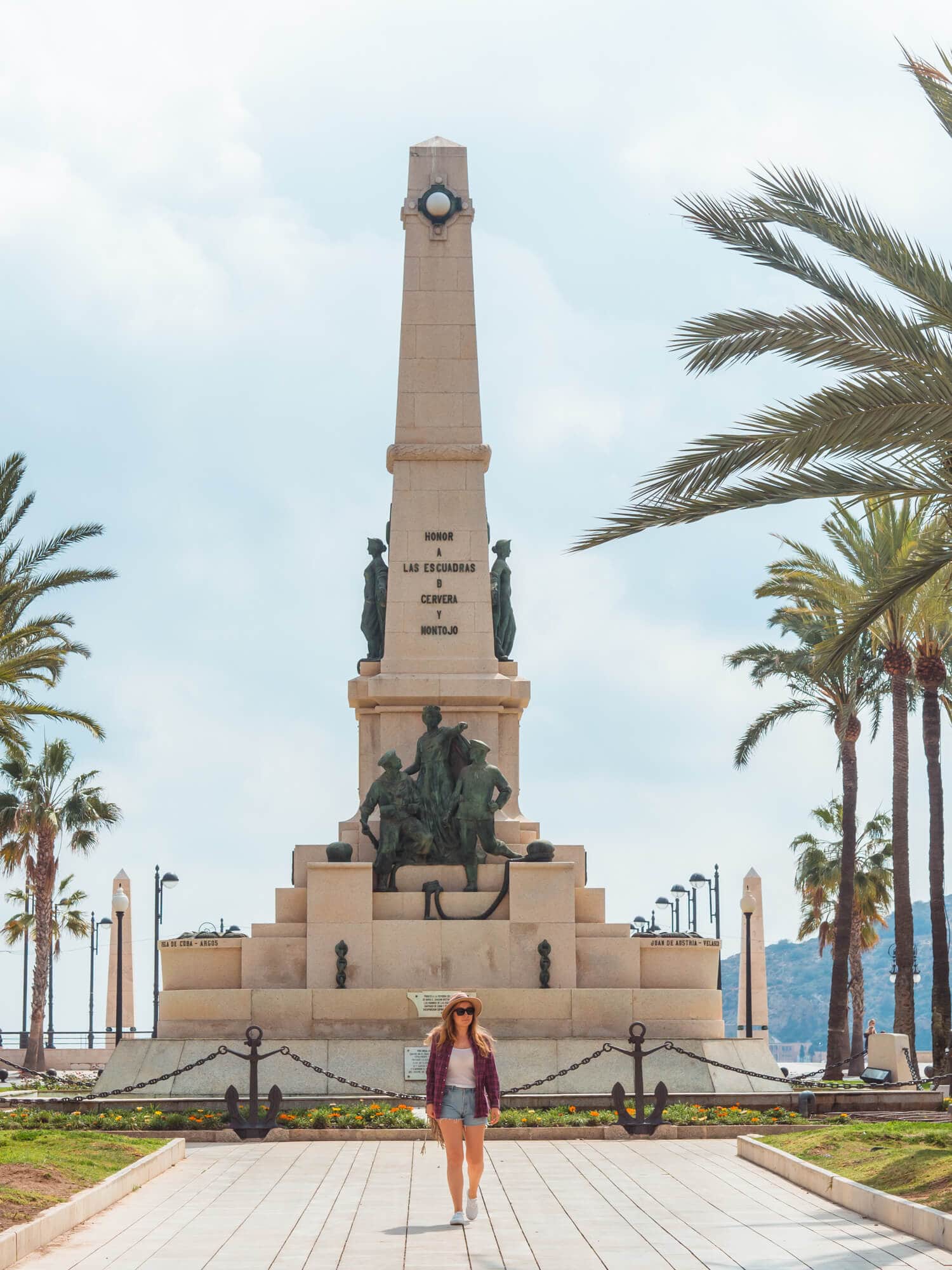
More Spain travel guides
- Is Hacienda Riquelme the best golf resort in Spain?
- The Enchanted City of Bolnuevo : A lesser-known natural wonder in Spain
- Rafting the stunning Segura River in Murcia, Spain
- The ultimate Spain bucket list : 101+ awesome things to do & places to see
- One remarkable day in Ronda , Spain (from Málaga by train)
- Mojácar Pueblo in Andalucía : One of Spain’s most beautiful white villages
- Discover the incredible Floración de Cieza (peach blossom season) in Murcia, Spain!
- Region of Murcia Spain : 15 awesome things to see and do
- Discover Spain’s stunning pink lake : Laguna Salada de Torrevieja
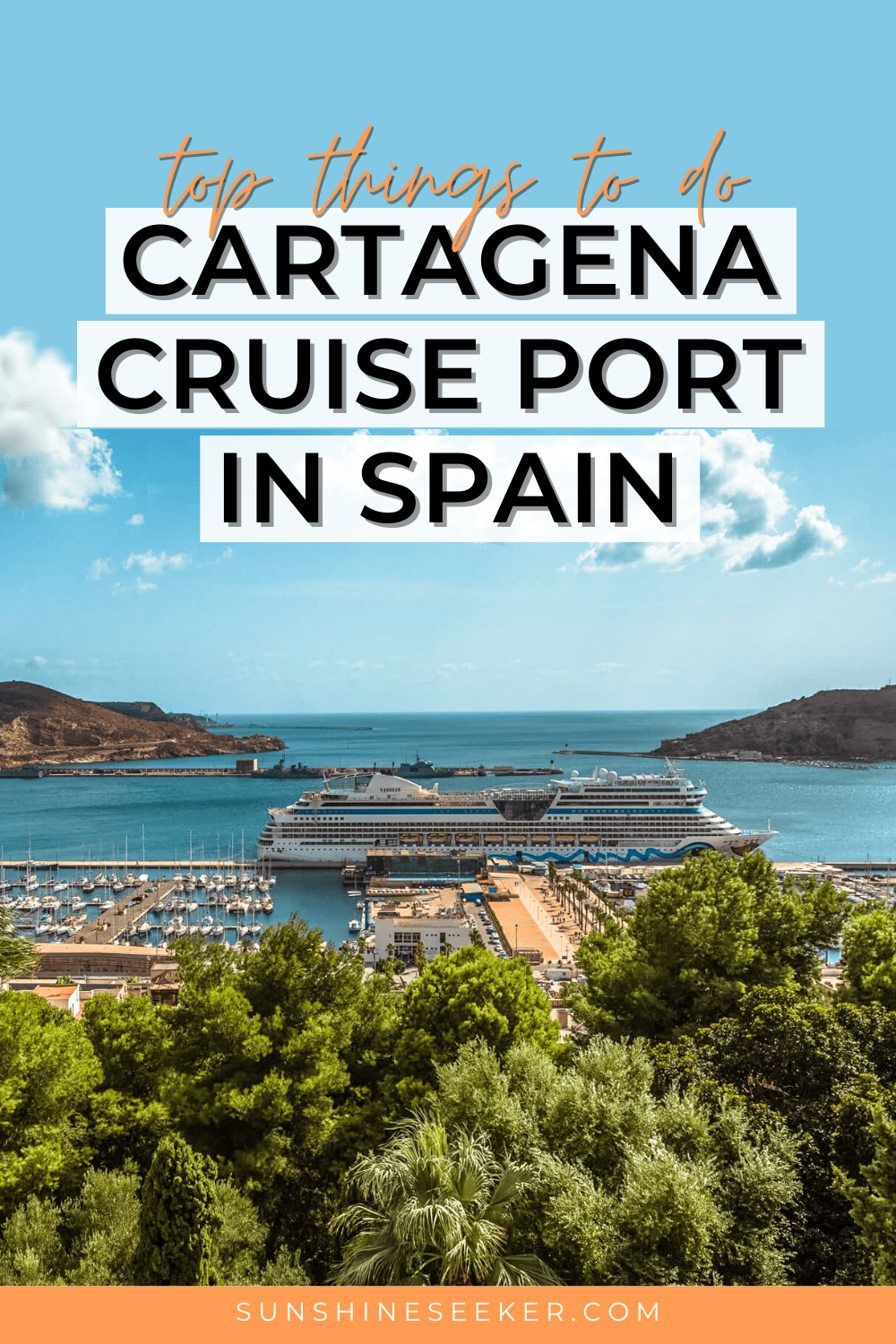
About Charlotte
Charlotte is the passionate traveler and online business coach behind Sunshine Seeker. She started working as a content creator on Instagram in 2014, before social media was even a thing, and as a travel blogger in 2015. Over the past 14 years she has explored 45+ countries and lived in Oslo, Kraków, Bali and Lombok. Every month she helps more than 50,000 people plan their adventures and learn how to create more freedom by working online.
You’ll Also Love

Leave a Reply Cancel reply
Your email address will not be published. Required fields are marked *
Save my name, email, and website in this browser for the next time I comment.

Secret Beach Nusa Ceningan: A hidden gem you don’t want to miss!
Join the travel creator club.
Sign up to receive one of my favorite Lightroom presets + my tour/product collab pitch template!
By clicking "SEND" you confirm that you want to join our mailing list and that you have read our Privacy policy .

I’m social…sort of!
Join me on Instagram

- Privacy Policy
- Affiliate Disclosure
- Terms & Conditions
As an Amazon Associate, I earn from qualifying purchases.
Copyright © 2024 Sunshine Seeker

COMMENTS
What to visit. Select from the list or hover over the map to find out about points of interest. National Museum of Underwater Archaeology. Cartagena Roman Theatre Museum. "Enrique Escudero de Castro" Municipal Archaeology Museum. Torre Ciega.
So towards the end of the century some gorgeous art nouveau buildings went up. You could fit the best ones into a walking tour and they include the Palacio Pedreño, the Casino de Cartagena, the Casa Cervantes, the Palacio de Aguirre and the Gran Hotel. 4. Palacio Consistoria. Source: turismocuatro.
Top Things To Do In Cartagena, Murcia Region - Our Cartagena Itinerary For 3 days. Visiting the Old Town and nearby monuments. Exploring ancient Roman ruins. Trying Andalusian cuisine and tapas. Relaxing on the best beach in Cartagena. Discovering wildlife from Southern Spain.
People watch in one of many streetside cafes. One of the best reasons to visit Cartagena is to enjoy its wonderful cafe culture, as the city boasts countless lovely streetside cafes. Because of the perennially warm and sunny weather, most cafes have plenty of outdoor seating and, if you find yourself a good place for a coffee or a drink on ...
Experiencia 43. 337. Distilleries. Come enjoy Experiencia 43 and discover the world of the iconic liqueur made in Cartagena. Learn how to make cocktails and visit the museum as well as the factory of Licor 43. See full details. 2023. 5. Museo Foro Romano Molinete.
Cartagena is a city with more than 2,500 years of history. Each corner, street and square of the city offers travellers monumental examples of its splendorous historical past, of the civilizations that put in at its port. The visitor will also be able to enjoy the local gastronomy which, in the case of Cartagena, is special in that it is a port ...
Best Things To Do In Cartagena, Spain. Travel tip. If you're interested in visiting more than two Cartagena's sites you might want to buy one of the combined tickets which allow access to the various sites at a cheaper rate. There are several options ranging from a 13€ ticket that allows access to 4 museums to the complete voucher that ...
Welcome to Cartagena. Cartagena is a small port city with a big history.Since its founding in 227 BC, the city has been ruled over by Carthaginians, Romans, Arabs and finally the Kingdom of Spain.There are numerous archaeological sites, including the Roman Theater that was only just discovered in 1988!. Cartagena is also home to a world-class naval museum and a charming old town with plenty of ...
Cartagena. Spain, Europe. Cartagena's fabulous natural harbour has been used for thousands of years. Stand on the battlements of the castle that overlook this city and you can literally see layer upon layer of history spread below you: the wharf where Phoenician traders docked their ships; the street where Roman legionaries marched; the plaza ...
Understand Ancient History at the Punic Wall. View Map. Address. C. San Diego, 25, 30202 Cartagena, Murcia, Spain. Phone +34 968 50 00 93. Web Visit website. Cartagena has made a great effort to explain the sometimes complicated history to visitors. The Punic Wall Interpretation Center protects the remains of Cartagena's oldest part, the ...
Mercado de Santa Florentina. One of the best ways to start your time in Cartagena is to head to the local Mercado de Santa Florentina. Open every day except Sunday from 8am to 3pm, this market has a range of typical fresh produce including fruits and vegetables, olives, cheeses, fish and meats. Apart from picking up a few snacks for your day of ...
About Cartagena. A Roman amphitheater, Moorish castle, and the bombed-out ruins of a 13th-century cathedral are just some of the major sights in history-steeped Cartagena. Add in beaches, thrumming nightlife, and mountainous surrounds, and you have one of southern Spain's most vibrant and varied cities. Cartagena. By Tracee H.
Cartagena, Spain, is located in the southeast of the country bordering on the Costa Blanca and the Costa de Azahar. Often overlooked by visitors to Spain, it is a city brimming with history, culture, and Mediterranean charm. ... One of the most iconic places of interest to visit in Cartagena is the Roman Theatre, which is a remarkable ...
Centre for the interpretation of the Punic Rampart. The Punic Rampart is the remains of a wall built in the 3rd century BC by the Carthaginians, and a 17th-century Crypt. The Rampart can be seen from the top of the Castillo. The Punic Wall stands on Monte Aletes, one of the five hills surrounding Cartagena.
Cartagena places to visit. Puerto de Mazarron. Puerto de Mazarron is a pleasant beach resort on the Costa Calida which has miles of long sandy beaches protected by the Sierra de la Almenera mountains. Orihuela. Orihuela is an attractive town with a restored old quarter and a wealth of historic buildings to admire.
Plan your Visit to Cartagena, Spain with free Cartagena, Spain itineraries, guides, things to do and maps. Create your personal guide to Cartagena, Spain with full information on all top attractions.
Here are 21 essential things to know before you visit Cartagena. about us blog travel resources Shop places. everywhere europe central america & mexico south america north america & caribbean asia ... for others it's their favourite nooks and side streets of Spain. Wherever it recalls for you, there's absolutely no doubt in our minds that ...
One of Cartagena's most popular historic attractions, the Roman Theater was hidden beneath the city for centuries; it was rediscovered during excavations that began in 1988. Believed to have been built between 5 and 1 B.C., the theater can seat 7,000 spectators and is divided into three horizontal sections.
Situated in the southeastern part of Spain, Cartagena boasts a Mediterranean climate with pleasant winters and scorching hot summers. Here is a basic breakdown of what to expect in each season. Spring (March to May): Spring is one of the best times to visit Cartagena, Spain. The weather boasts pleasant temperatures from around 15°C to 25°C ...
The reenactment of the Battle for Qart-Hadasht from the Second Punic War (218-208 BCE) is one of the highlights of the Fiestas de Carthagineses y Romanos (Festival of Carthaginians and Romans) that take place in Cartagena, Murcia, in the second half of September. The festivities put the Spanish city in full party mode, as it celebrates its ...
Cartagena, Spain, is often overlooked in favor of larger, more well-known Spanish cities. However, I believe that Cartagena is a gorgeous town that is well worth visiting.
There is a restaurant and a cafeteria on the top floor, offering great views of the harbour. The National Museum of Underwater Archeology is wheelchair-accessible. 7. Murcia. A trip to the historic city of Murcia, the capital of the Murcia region, is one of the most popular shore excursions in the port of Cartagena.
My friend, Danielle, and I made our way off the ship and decided to walk into Cartagena as it wasn't far to the city.Cartagena has a population of 216,451 residents (as of 2014) in an area of about 215 square miles. Compare that to the other Cartagena, a city in Colombia that was founded in 1533 with a population of 1.1 million and an area of 221 square miles and named after Cartagena, Spain.
January 2024 · In: Spain, Travel. Located in the Region of Murcia on the southeastern coast of Spain, Cartagena is a historic port city with a rich cultural heritage, making it an increasingly popular stop for cruise ships. The modern cruise port welcomes hundreds of thousands of passengers every year and the convenient location provides ...